End-of-Life Management of PV Solar Modules in India
VerifiedAdded on 2023/01/12
|52
|16715
|53
AI Summary
This report presents a feasibility study for recycling thin film solar cells and manufacturing waste in India, based on the current recycling system and emerging technologies. It discusses the environmental advantages of PV technology, the challenges of decommissioning solar cells, and the potential for recycling them. The report also highlights the need for proper end-of-life management of PV modules and suggests policy recommendations.
Contribute Materials
Your contribution can guide someone’s learning journey. Share your
documents today.
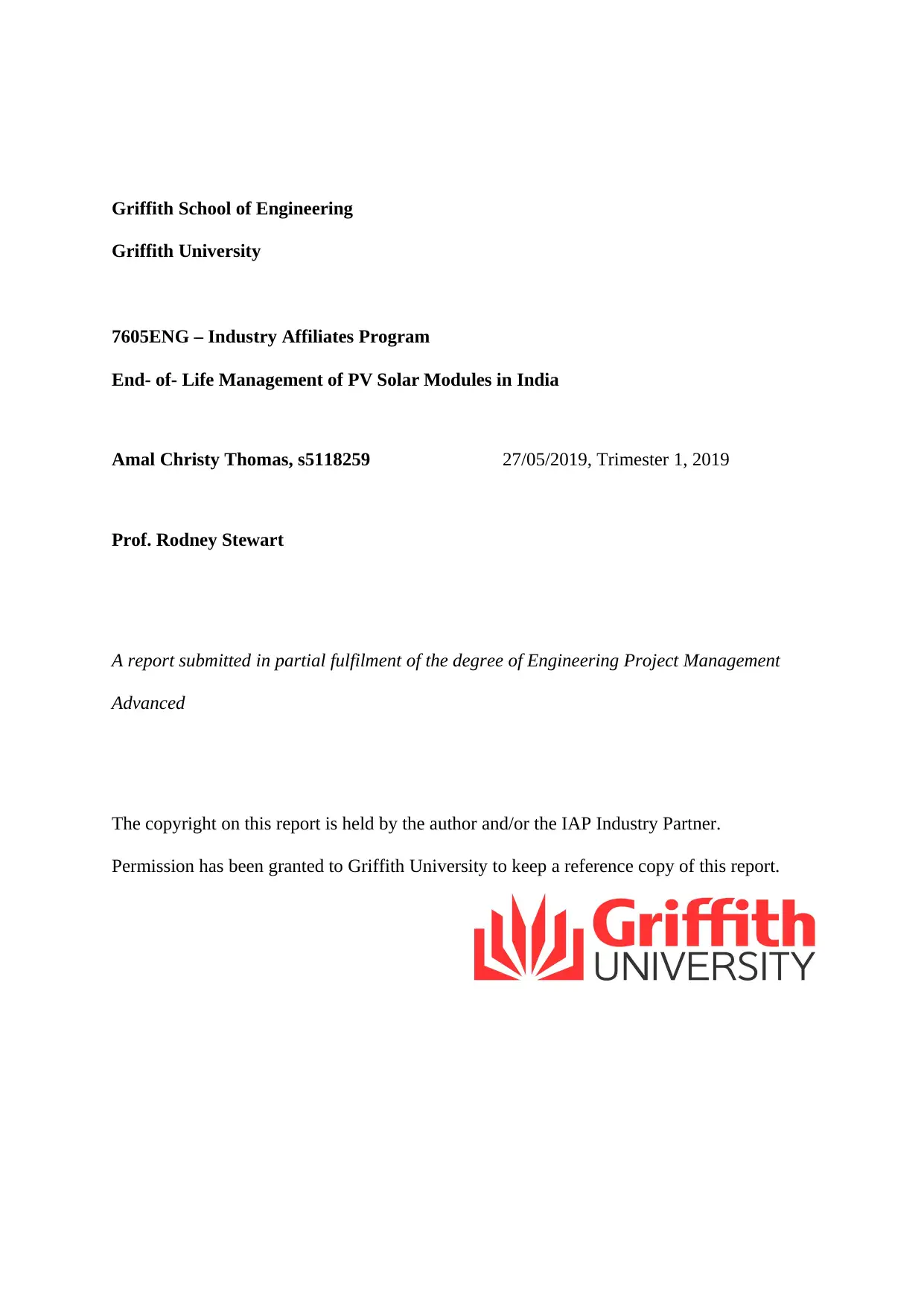
Griffith School of Engineering
Griffith University
7605ENG – Industry Affiliates Program
End- of- Life Management of PV Solar Modules in India
Amal Christy Thomas, s5118259 27/05/2019, Trimester 1, 2019
Prof. Rodney Stewart
A report submitted in partial fulfilment of the degree of Engineering Project Management
Advanced
The copyright on this report is held by the author and/or the IAP Industry Partner.
Permission has been granted to Griffith University to keep a reference copy of this report.
Griffith University
7605ENG – Industry Affiliates Program
End- of- Life Management of PV Solar Modules in India
Amal Christy Thomas, s5118259 27/05/2019, Trimester 1, 2019
Prof. Rodney Stewart
A report submitted in partial fulfilment of the degree of Engineering Project Management
Advanced
The copyright on this report is held by the author and/or the IAP Industry Partner.
Permission has been granted to Griffith University to keep a reference copy of this report.
Secure Best Marks with AI Grader
Need help grading? Try our AI Grader for instant feedback on your assignments.
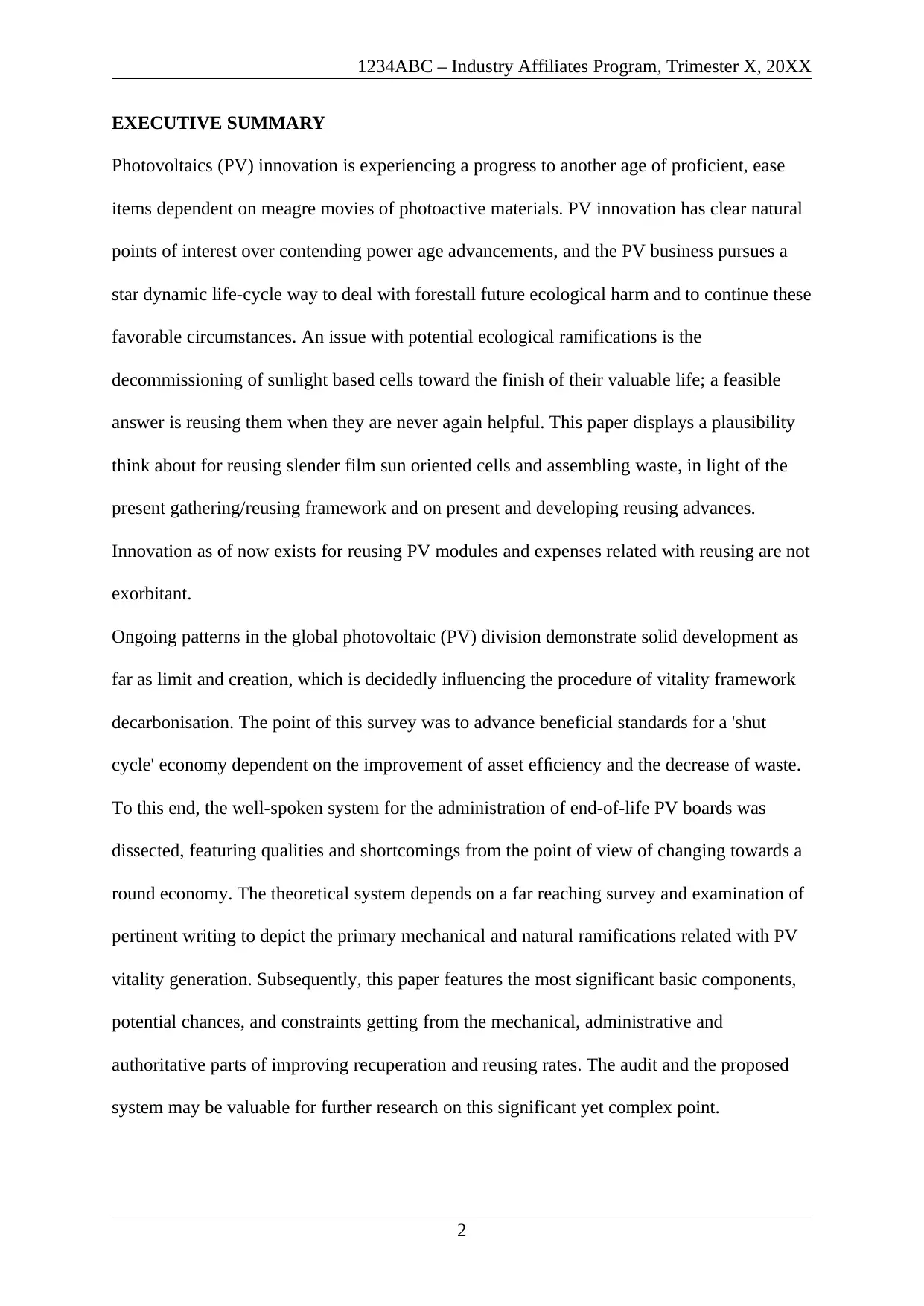
1234ABC – Industry Affiliates Program, Trimester X, 20XX
EXECUTIVE SUMMARY
Photovoltaics (PV) innovation is experiencing a progress to another age of proficient, ease
items dependent on meagre movies of photoactive materials. PV innovation has clear natural
points of interest over contending power age advancements, and the PV business pursues a
star dynamic life-cycle way to deal with forestall future ecological harm and to continue these
favorable circumstances. An issue with potential ecological ramifications is the
decommissioning of sunlight based cells toward the finish of their valuable life; a feasible
answer is reusing them when they are never again helpful. This paper displays a plausibility
think about for reusing slender film sun oriented cells and assembling waste, in light of the
present gathering/reusing framework and on present and developing reusing advances.
Innovation as of now exists for reusing PV modules and expenses related with reusing are not
exorbitant.
Ongoing patterns in the global photovoltaic (PV) division demonstrate solid development as
far as limit and creation, which is decidedly influencing the procedure of vitality framework
decarbonisation. The point of this survey was to advance beneficial standards for a 'shut
cycle' economy dependent on the improvement of asset efficiency and the decrease of waste.
To this end, the well-spoken system for the administration of end-of-life PV boards was
dissected, featuring qualities and shortcomings from the point of view of changing towards a
round economy. The theoretical system depends on a far reaching survey and examination of
pertinent writing to depict the primary mechanical and natural ramifications related with PV
vitality generation. Subsequently, this paper features the most significant basic components,
potential chances, and constraints getting from the mechanical, administrative and
authoritative parts of improving recuperation and reusing rates. The audit and the proposed
system may be valuable for further research on this significant yet complex point.
2
EXECUTIVE SUMMARY
Photovoltaics (PV) innovation is experiencing a progress to another age of proficient, ease
items dependent on meagre movies of photoactive materials. PV innovation has clear natural
points of interest over contending power age advancements, and the PV business pursues a
star dynamic life-cycle way to deal with forestall future ecological harm and to continue these
favorable circumstances. An issue with potential ecological ramifications is the
decommissioning of sunlight based cells toward the finish of their valuable life; a feasible
answer is reusing them when they are never again helpful. This paper displays a plausibility
think about for reusing slender film sun oriented cells and assembling waste, in light of the
present gathering/reusing framework and on present and developing reusing advances.
Innovation as of now exists for reusing PV modules and expenses related with reusing are not
exorbitant.
Ongoing patterns in the global photovoltaic (PV) division demonstrate solid development as
far as limit and creation, which is decidedly influencing the procedure of vitality framework
decarbonisation. The point of this survey was to advance beneficial standards for a 'shut
cycle' economy dependent on the improvement of asset efficiency and the decrease of waste.
To this end, the well-spoken system for the administration of end-of-life PV boards was
dissected, featuring qualities and shortcomings from the point of view of changing towards a
round economy. The theoretical system depends on a far reaching survey and examination of
pertinent writing to depict the primary mechanical and natural ramifications related with PV
vitality generation. Subsequently, this paper features the most significant basic components,
potential chances, and constraints getting from the mechanical, administrative and
authoritative parts of improving recuperation and reusing rates. The audit and the proposed
system may be valuable for further research on this significant yet complex point.
2
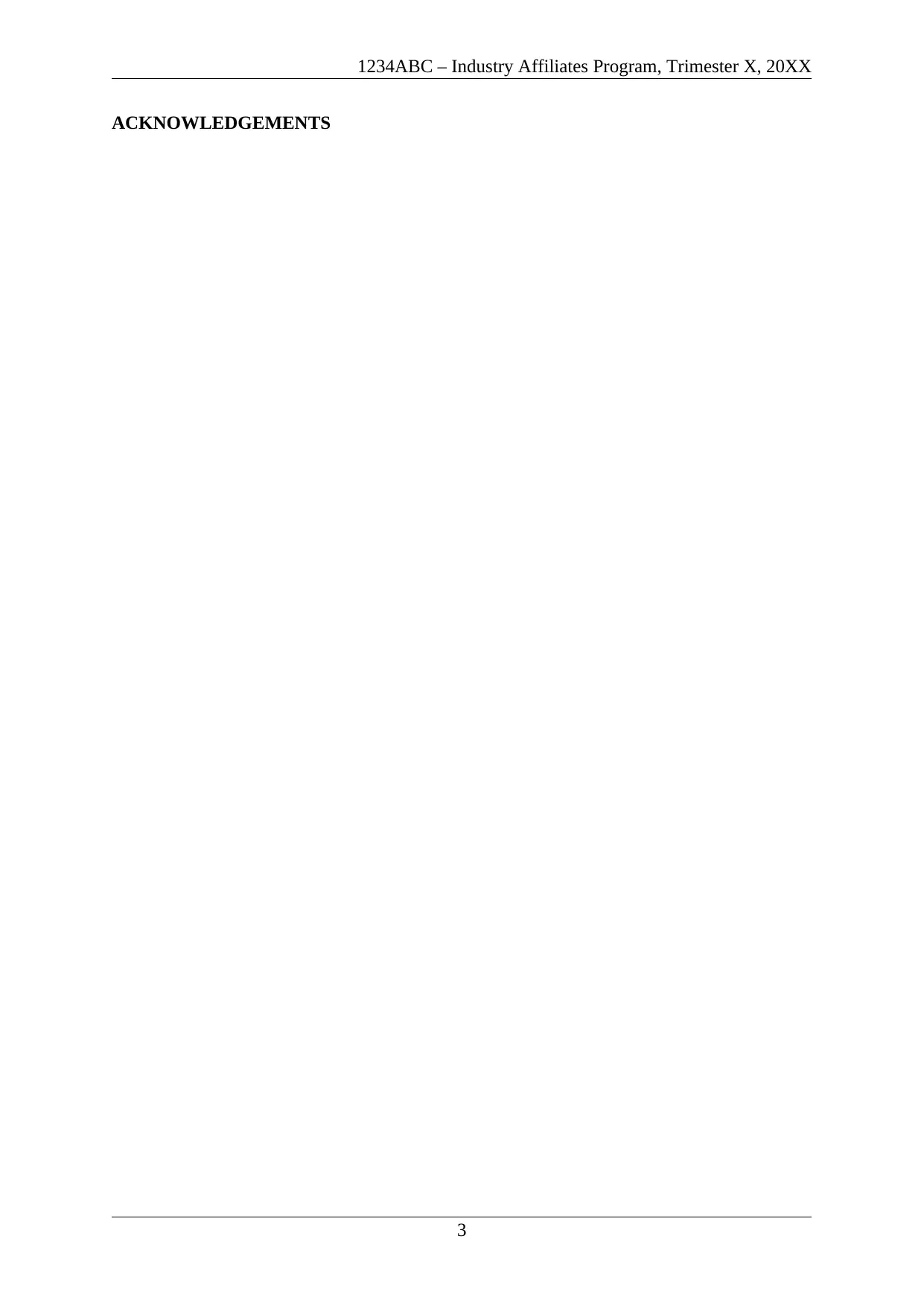
1234ABC – Industry Affiliates Program, Trimester X, 20XX
ACKNOWLEDGEMENTS
3
ACKNOWLEDGEMENTS
3
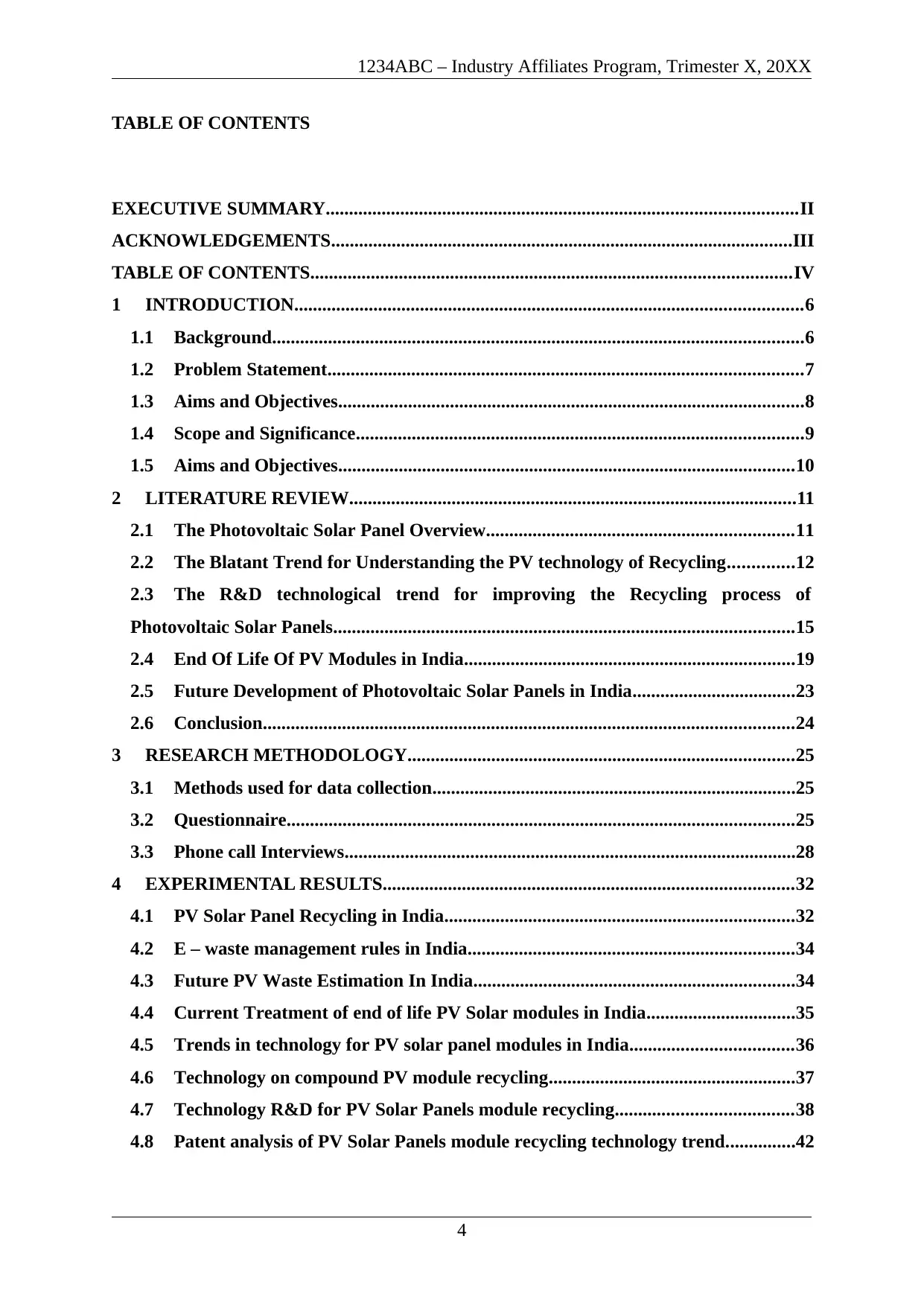
1234ABC – Industry Affiliates Program, Trimester X, 20XX
TABLE OF CONTENTS
EXECUTIVE SUMMARY.....................................................................................................II
ACKNOWLEDGEMENTS...................................................................................................III
TABLE OF CONTENTS.......................................................................................................IV
1 INTRODUCTION.............................................................................................................6
1.1 Background..................................................................................................................6
1.2 Problem Statement......................................................................................................7
1.3 Aims and Objectives....................................................................................................8
1.4 Scope and Significance................................................................................................9
1.5 Aims and Objectives..................................................................................................10
2 LITERATURE REVIEW................................................................................................11
2.1 The Photovoltaic Solar Panel Overview..................................................................11
2.2 The Blatant Trend for Understanding the PV technology of Recycling..............12
2.3 The R&D technological trend for improving the Recycling process of
Photovoltaic Solar Panels...................................................................................................15
2.4 End Of Life Of PV Modules in India.......................................................................19
2.5 Future Development of Photovoltaic Solar Panels in India...................................23
2.6 Conclusion..................................................................................................................24
3 RESEARCH METHODOLOGY...................................................................................25
3.1 Methods used for data collection..............................................................................25
3.2 Questionnaire.............................................................................................................25
3.3 Phone call Interviews.................................................................................................28
4 EXPERIMENTAL RESULTS........................................................................................32
4.1 PV Solar Panel Recycling in India...........................................................................32
4.2 E – waste management rules in India......................................................................34
4.3 Future PV Waste Estimation In India.....................................................................34
4.4 Current Treatment of end of life PV Solar modules in India................................35
4.5 Trends in technology for PV solar panel modules in India...................................36
4.6 Technology on compound PV module recycling.....................................................37
4.7 Technology R&D for PV Solar Panels module recycling......................................38
4.8 Patent analysis of PV Solar Panels module recycling technology trend...............42
4
TABLE OF CONTENTS
EXECUTIVE SUMMARY.....................................................................................................II
ACKNOWLEDGEMENTS...................................................................................................III
TABLE OF CONTENTS.......................................................................................................IV
1 INTRODUCTION.............................................................................................................6
1.1 Background..................................................................................................................6
1.2 Problem Statement......................................................................................................7
1.3 Aims and Objectives....................................................................................................8
1.4 Scope and Significance................................................................................................9
1.5 Aims and Objectives..................................................................................................10
2 LITERATURE REVIEW................................................................................................11
2.1 The Photovoltaic Solar Panel Overview..................................................................11
2.2 The Blatant Trend for Understanding the PV technology of Recycling..............12
2.3 The R&D technological trend for improving the Recycling process of
Photovoltaic Solar Panels...................................................................................................15
2.4 End Of Life Of PV Modules in India.......................................................................19
2.5 Future Development of Photovoltaic Solar Panels in India...................................23
2.6 Conclusion..................................................................................................................24
3 RESEARCH METHODOLOGY...................................................................................25
3.1 Methods used for data collection..............................................................................25
3.2 Questionnaire.............................................................................................................25
3.3 Phone call Interviews.................................................................................................28
4 EXPERIMENTAL RESULTS........................................................................................32
4.1 PV Solar Panel Recycling in India...........................................................................32
4.2 E – waste management rules in India......................................................................34
4.3 Future PV Waste Estimation In India.....................................................................34
4.4 Current Treatment of end of life PV Solar modules in India................................35
4.5 Trends in technology for PV solar panel modules in India...................................36
4.6 Technology on compound PV module recycling.....................................................37
4.7 Technology R&D for PV Solar Panels module recycling......................................38
4.8 Patent analysis of PV Solar Panels module recycling technology trend...............42
4
Secure Best Marks with AI Grader
Need help grading? Try our AI Grader for instant feedback on your assignments.
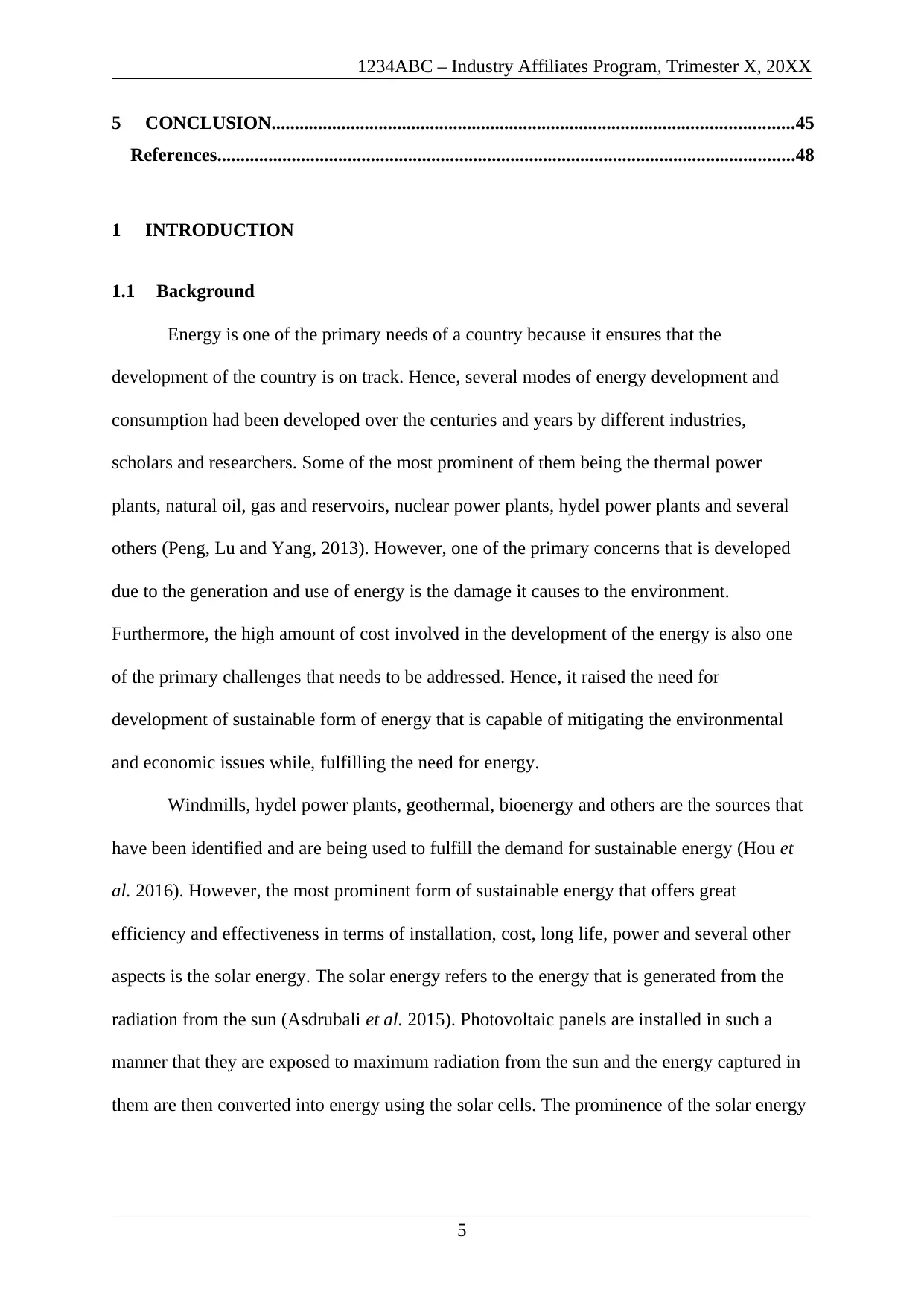
1234ABC – Industry Affiliates Program, Trimester X, 20XX
5 CONCLUSION................................................................................................................45
References............................................................................................................................48
1 INTRODUCTION
1.1 Background
Energy is one of the primary needs of a country because it ensures that the
development of the country is on track. Hence, several modes of energy development and
consumption had been developed over the centuries and years by different industries,
scholars and researchers. Some of the most prominent of them being the thermal power
plants, natural oil, gas and reservoirs, nuclear power plants, hydel power plants and several
others (Peng, Lu and Yang, 2013). However, one of the primary concerns that is developed
due to the generation and use of energy is the damage it causes to the environment.
Furthermore, the high amount of cost involved in the development of the energy is also one
of the primary challenges that needs to be addressed. Hence, it raised the need for
development of sustainable form of energy that is capable of mitigating the environmental
and economic issues while, fulfilling the need for energy.
Windmills, hydel power plants, geothermal, bioenergy and others are the sources that
have been identified and are being used to fulfill the demand for sustainable energy (Hou et
al. 2016). However, the most prominent form of sustainable energy that offers great
efficiency and effectiveness in terms of installation, cost, long life, power and several other
aspects is the solar energy. The solar energy refers to the energy that is generated from the
radiation from the sun (Asdrubali et al. 2015). Photovoltaic panels are installed in such a
manner that they are exposed to maximum radiation from the sun and the energy captured in
them are then converted into energy using the solar cells. The prominence of the solar energy
5
5 CONCLUSION................................................................................................................45
References............................................................................................................................48
1 INTRODUCTION
1.1 Background
Energy is one of the primary needs of a country because it ensures that the
development of the country is on track. Hence, several modes of energy development and
consumption had been developed over the centuries and years by different industries,
scholars and researchers. Some of the most prominent of them being the thermal power
plants, natural oil, gas and reservoirs, nuclear power plants, hydel power plants and several
others (Peng, Lu and Yang, 2013). However, one of the primary concerns that is developed
due to the generation and use of energy is the damage it causes to the environment.
Furthermore, the high amount of cost involved in the development of the energy is also one
of the primary challenges that needs to be addressed. Hence, it raised the need for
development of sustainable form of energy that is capable of mitigating the environmental
and economic issues while, fulfilling the need for energy.
Windmills, hydel power plants, geothermal, bioenergy and others are the sources that
have been identified and are being used to fulfill the demand for sustainable energy (Hou et
al. 2016). However, the most prominent form of sustainable energy that offers great
efficiency and effectiveness in terms of installation, cost, long life, power and several other
aspects is the solar energy. The solar energy refers to the energy that is generated from the
radiation from the sun (Asdrubali et al. 2015). Photovoltaic panels are installed in such a
manner that they are exposed to maximum radiation from the sun and the energy captured in
them are then converted into energy using the solar cells. The prominence of the solar energy
5
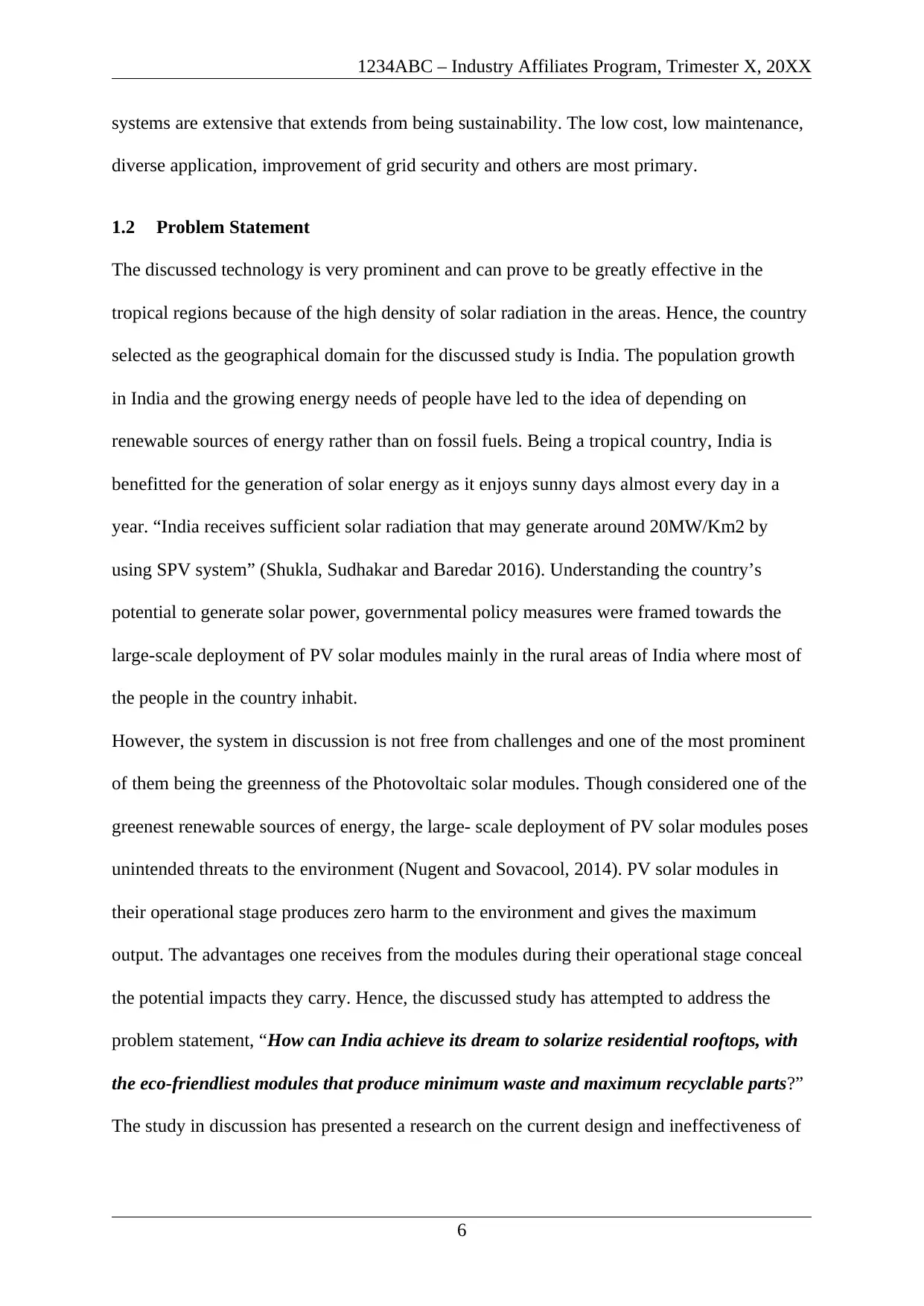
1234ABC – Industry Affiliates Program, Trimester X, 20XX
systems are extensive that extends from being sustainability. The low cost, low maintenance,
diverse application, improvement of grid security and others are most primary.
1.2 Problem Statement
The discussed technology is very prominent and can prove to be greatly effective in the
tropical regions because of the high density of solar radiation in the areas. Hence, the country
selected as the geographical domain for the discussed study is India. The population growth
in India and the growing energy needs of people have led to the idea of depending on
renewable sources of energy rather than on fossil fuels. Being a tropical country, India is
benefitted for the generation of solar energy as it enjoys sunny days almost every day in a
year. “India receives sufficient solar radiation that may generate around 20MW/Km2 by
using SPV system” (Shukla, Sudhakar and Baredar 2016). Understanding the country’s
potential to generate solar power, governmental policy measures were framed towards the
large-scale deployment of PV solar modules mainly in the rural areas of India where most of
the people in the country inhabit.
However, the system in discussion is not free from challenges and one of the most prominent
of them being the greenness of the Photovoltaic solar modules. Though considered one of the
greenest renewable sources of energy, the large- scale deployment of PV solar modules poses
unintended threats to the environment (Nugent and Sovacool, 2014). PV solar modules in
their operational stage produces zero harm to the environment and gives the maximum
output. The advantages one receives from the modules during their operational stage conceal
the potential impacts they carry. Hence, the discussed study has attempted to address the
problem statement, “How can India achieve its dream to solarize residential rooftops, with
the eco-friendliest modules that produce minimum waste and maximum recyclable parts?”
The study in discussion has presented a research on the current design and ineffectiveness of
6
systems are extensive that extends from being sustainability. The low cost, low maintenance,
diverse application, improvement of grid security and others are most primary.
1.2 Problem Statement
The discussed technology is very prominent and can prove to be greatly effective in the
tropical regions because of the high density of solar radiation in the areas. Hence, the country
selected as the geographical domain for the discussed study is India. The population growth
in India and the growing energy needs of people have led to the idea of depending on
renewable sources of energy rather than on fossil fuels. Being a tropical country, India is
benefitted for the generation of solar energy as it enjoys sunny days almost every day in a
year. “India receives sufficient solar radiation that may generate around 20MW/Km2 by
using SPV system” (Shukla, Sudhakar and Baredar 2016). Understanding the country’s
potential to generate solar power, governmental policy measures were framed towards the
large-scale deployment of PV solar modules mainly in the rural areas of India where most of
the people in the country inhabit.
However, the system in discussion is not free from challenges and one of the most prominent
of them being the greenness of the Photovoltaic solar modules. Though considered one of the
greenest renewable sources of energy, the large- scale deployment of PV solar modules poses
unintended threats to the environment (Nugent and Sovacool, 2014). PV solar modules in
their operational stage produces zero harm to the environment and gives the maximum
output. The advantages one receives from the modules during their operational stage conceal
the potential impacts they carry. Hence, the discussed study has attempted to address the
problem statement, “How can India achieve its dream to solarize residential rooftops, with
the eco-friendliest modules that produce minimum waste and maximum recyclable parts?”
The study in discussion has presented a research on the current design and ineffectiveness of
6
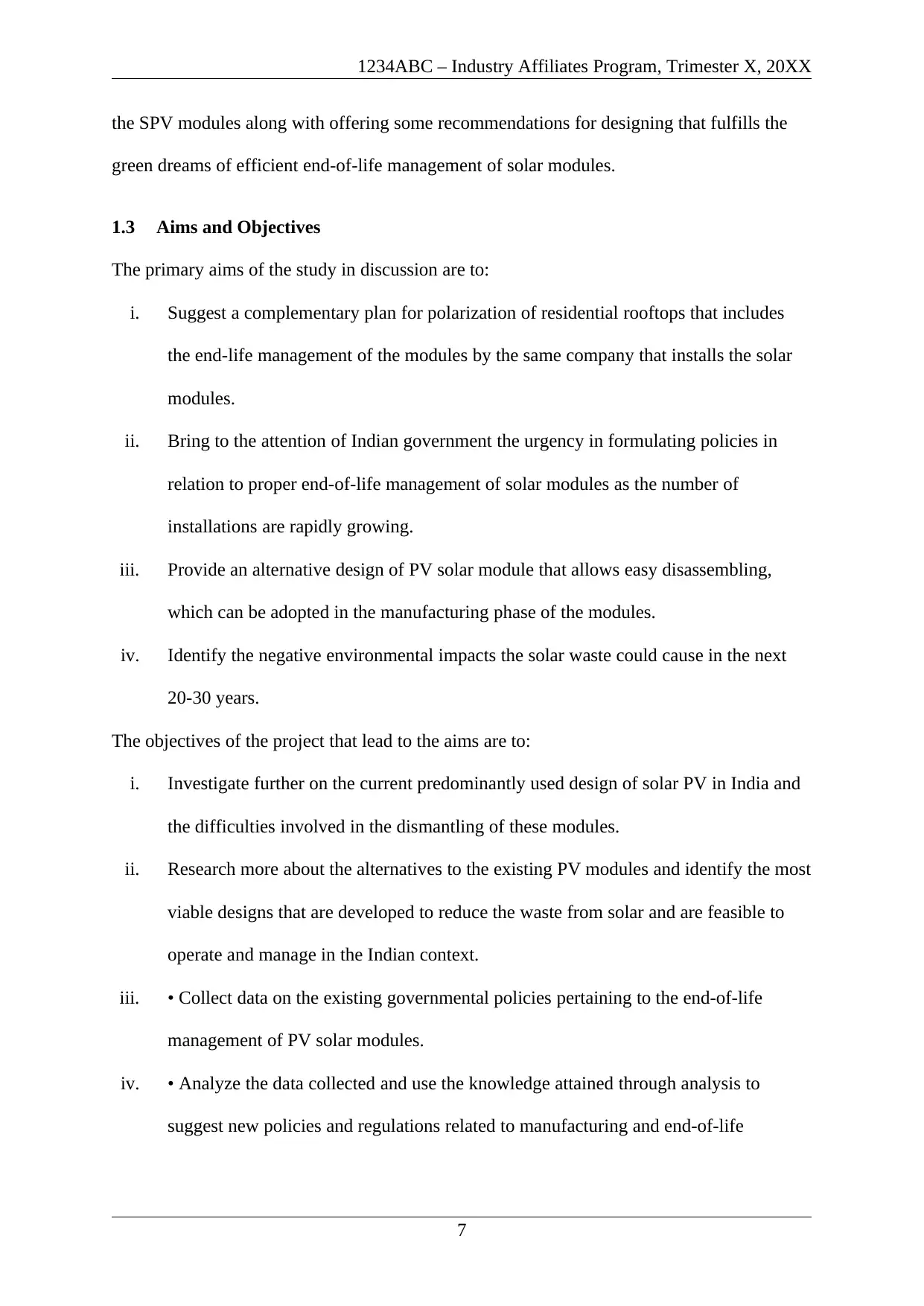
1234ABC – Industry Affiliates Program, Trimester X, 20XX
the SPV modules along with offering some recommendations for designing that fulfills the
green dreams of efficient end-of-life management of solar modules.
1.3 Aims and Objectives
The primary aims of the study in discussion are to:
i. Suggest a complementary plan for polarization of residential rooftops that includes
the end-life management of the modules by the same company that installs the solar
modules.
ii. Bring to the attention of Indian government the urgency in formulating policies in
relation to proper end-of-life management of solar modules as the number of
installations are rapidly growing.
iii. Provide an alternative design of PV solar module that allows easy disassembling,
which can be adopted in the manufacturing phase of the modules.
iv. Identify the negative environmental impacts the solar waste could cause in the next
20-30 years.
The objectives of the project that lead to the aims are to:
i. Investigate further on the current predominantly used design of solar PV in India and
the difficulties involved in the dismantling of these modules.
ii. Research more about the alternatives to the existing PV modules and identify the most
viable designs that are developed to reduce the waste from solar and are feasible to
operate and manage in the Indian context.
iii. • Collect data on the existing governmental policies pertaining to the end-of-life
management of PV solar modules.
iv. • Analyze the data collected and use the knowledge attained through analysis to
suggest new policies and regulations related to manufacturing and end-of-life
7
the SPV modules along with offering some recommendations for designing that fulfills the
green dreams of efficient end-of-life management of solar modules.
1.3 Aims and Objectives
The primary aims of the study in discussion are to:
i. Suggest a complementary plan for polarization of residential rooftops that includes
the end-life management of the modules by the same company that installs the solar
modules.
ii. Bring to the attention of Indian government the urgency in formulating policies in
relation to proper end-of-life management of solar modules as the number of
installations are rapidly growing.
iii. Provide an alternative design of PV solar module that allows easy disassembling,
which can be adopted in the manufacturing phase of the modules.
iv. Identify the negative environmental impacts the solar waste could cause in the next
20-30 years.
The objectives of the project that lead to the aims are to:
i. Investigate further on the current predominantly used design of solar PV in India and
the difficulties involved in the dismantling of these modules.
ii. Research more about the alternatives to the existing PV modules and identify the most
viable designs that are developed to reduce the waste from solar and are feasible to
operate and manage in the Indian context.
iii. • Collect data on the existing governmental policies pertaining to the end-of-life
management of PV solar modules.
iv. • Analyze the data collected and use the knowledge attained through analysis to
suggest new policies and regulations related to manufacturing and end-of-life
7
Paraphrase This Document
Need a fresh take? Get an instant paraphrase of this document with our AI Paraphraser
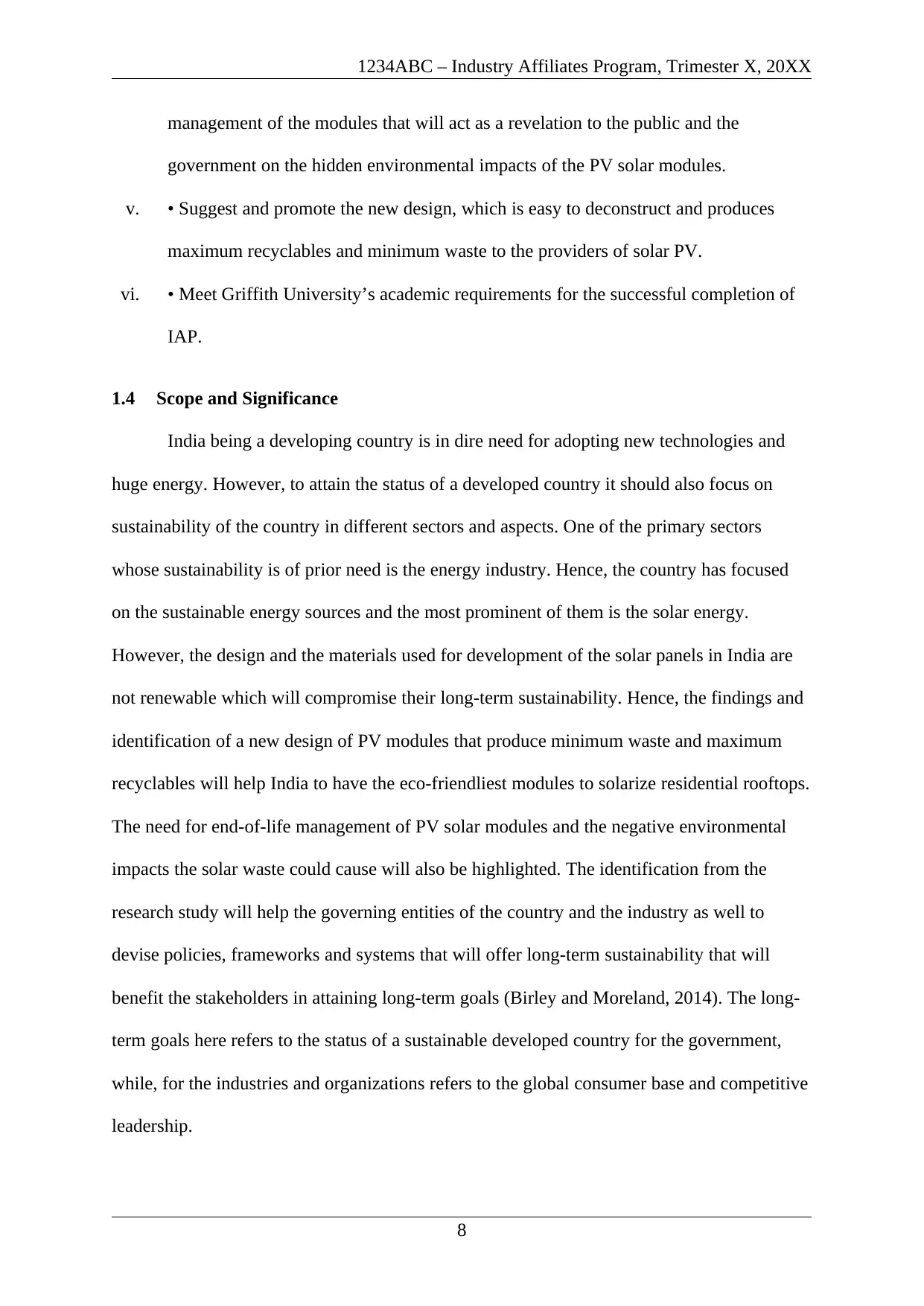
1234ABC – Industry Affiliates Program, Trimester X, 20XX
management of the modules that will act as a revelation to the public and the
government on the hidden environmental impacts of the PV solar modules.
v. • Suggest and promote the new design, which is easy to deconstruct and produces
maximum recyclables and minimum waste to the providers of solar PV.
vi. • Meet Griffith University’s academic requirements for the successful completion of
IAP.
1.4 Scope and Significance
India being a developing country is in dire need for adopting new technologies and
huge energy. However, to attain the status of a developed country it should also focus on
sustainability of the country in different sectors and aspects. One of the primary sectors
whose sustainability is of prior need is the energy industry. Hence, the country has focused
on the sustainable energy sources and the most prominent of them is the solar energy.
However, the design and the materials used for development of the solar panels in India are
not renewable which will compromise their long-term sustainability. Hence, the findings and
identification of a new design of PV modules that produce minimum waste and maximum
recyclables will help India to have the eco-friendliest modules to solarize residential rooftops.
The need for end-of-life management of PV solar modules and the negative environmental
impacts the solar waste could cause will also be highlighted. The identification from the
research study will help the governing entities of the country and the industry as well to
devise policies, frameworks and systems that will offer long-term sustainability that will
benefit the stakeholders in attaining long-term goals (Birley and Moreland, 2014). The long-
term goals here refers to the status of a sustainable developed country for the government,
while, for the industries and organizations refers to the global consumer base and competitive
leadership.
8
management of the modules that will act as a revelation to the public and the
government on the hidden environmental impacts of the PV solar modules.
v. • Suggest and promote the new design, which is easy to deconstruct and produces
maximum recyclables and minimum waste to the providers of solar PV.
vi. • Meet Griffith University’s academic requirements for the successful completion of
IAP.
1.4 Scope and Significance
India being a developing country is in dire need for adopting new technologies and
huge energy. However, to attain the status of a developed country it should also focus on
sustainability of the country in different sectors and aspects. One of the primary sectors
whose sustainability is of prior need is the energy industry. Hence, the country has focused
on the sustainable energy sources and the most prominent of them is the solar energy.
However, the design and the materials used for development of the solar panels in India are
not renewable which will compromise their long-term sustainability. Hence, the findings and
identification of a new design of PV modules that produce minimum waste and maximum
recyclables will help India to have the eco-friendliest modules to solarize residential rooftops.
The need for end-of-life management of PV solar modules and the negative environmental
impacts the solar waste could cause will also be highlighted. The identification from the
research study will help the governing entities of the country and the industry as well to
devise policies, frameworks and systems that will offer long-term sustainability that will
benefit the stakeholders in attaining long-term goals (Birley and Moreland, 2014). The long-
term goals here refers to the status of a sustainable developed country for the government,
while, for the industries and organizations refers to the global consumer base and competitive
leadership.
8
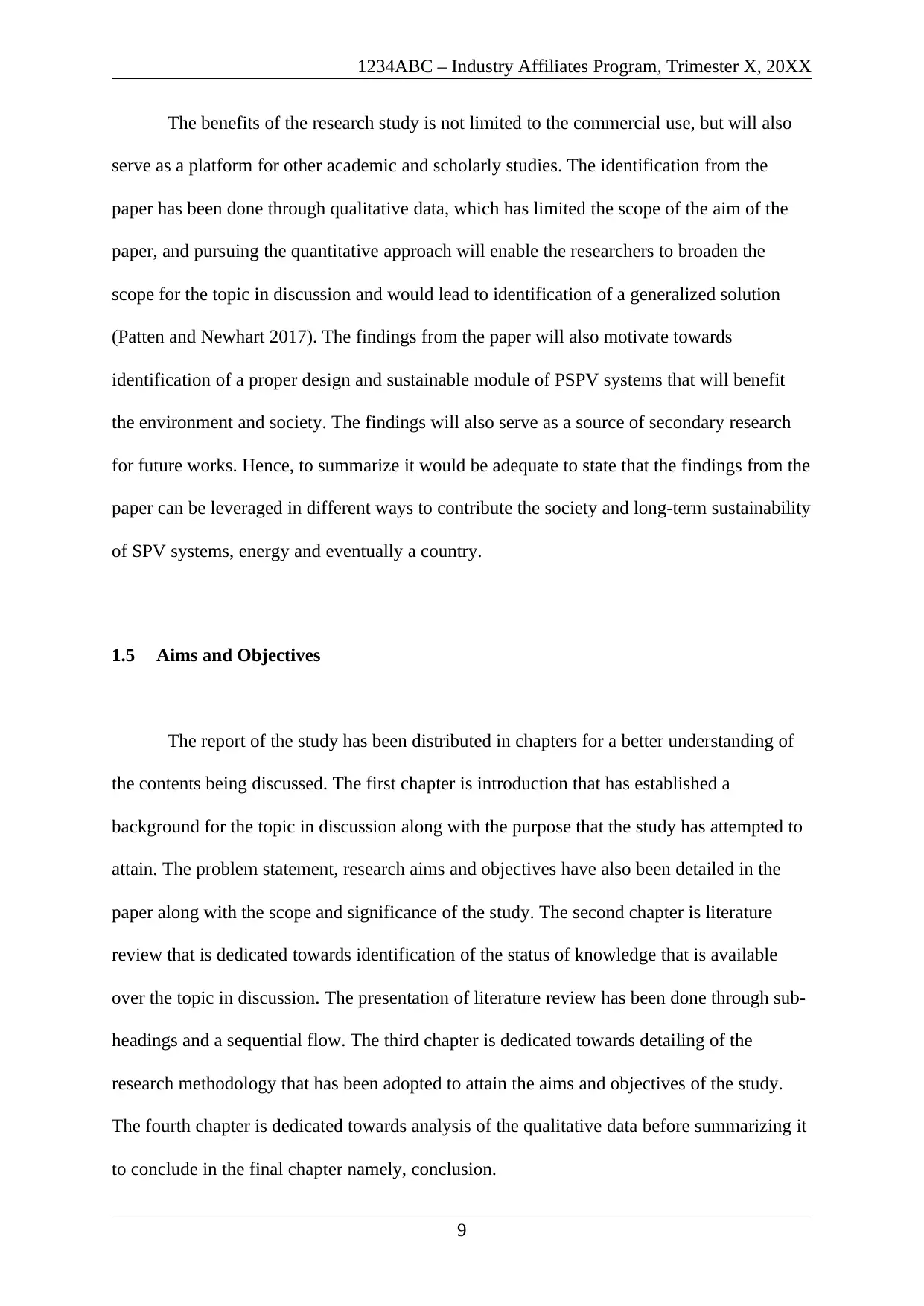
1234ABC – Industry Affiliates Program, Trimester X, 20XX
The benefits of the research study is not limited to the commercial use, but will also
serve as a platform for other academic and scholarly studies. The identification from the
paper has been done through qualitative data, which has limited the scope of the aim of the
paper, and pursuing the quantitative approach will enable the researchers to broaden the
scope for the topic in discussion and would lead to identification of a generalized solution
(Patten and Newhart 2017). The findings from the paper will also motivate towards
identification of a proper design and sustainable module of PSPV systems that will benefit
the environment and society. The findings will also serve as a source of secondary research
for future works. Hence, to summarize it would be adequate to state that the findings from the
paper can be leveraged in different ways to contribute the society and long-term sustainability
of SPV systems, energy and eventually a country.
1.5 Aims and Objectives
The report of the study has been distributed in chapters for a better understanding of
the contents being discussed. The first chapter is introduction that has established a
background for the topic in discussion along with the purpose that the study has attempted to
attain. The problem statement, research aims and objectives have also been detailed in the
paper along with the scope and significance of the study. The second chapter is literature
review that is dedicated towards identification of the status of knowledge that is available
over the topic in discussion. The presentation of literature review has been done through sub-
headings and a sequential flow. The third chapter is dedicated towards detailing of the
research methodology that has been adopted to attain the aims and objectives of the study.
The fourth chapter is dedicated towards analysis of the qualitative data before summarizing it
to conclude in the final chapter namely, conclusion.
9
The benefits of the research study is not limited to the commercial use, but will also
serve as a platform for other academic and scholarly studies. The identification from the
paper has been done through qualitative data, which has limited the scope of the aim of the
paper, and pursuing the quantitative approach will enable the researchers to broaden the
scope for the topic in discussion and would lead to identification of a generalized solution
(Patten and Newhart 2017). The findings from the paper will also motivate towards
identification of a proper design and sustainable module of PSPV systems that will benefit
the environment and society. The findings will also serve as a source of secondary research
for future works. Hence, to summarize it would be adequate to state that the findings from the
paper can be leveraged in different ways to contribute the society and long-term sustainability
of SPV systems, energy and eventually a country.
1.5 Aims and Objectives
The report of the study has been distributed in chapters for a better understanding of
the contents being discussed. The first chapter is introduction that has established a
background for the topic in discussion along with the purpose that the study has attempted to
attain. The problem statement, research aims and objectives have also been detailed in the
paper along with the scope and significance of the study. The second chapter is literature
review that is dedicated towards identification of the status of knowledge that is available
over the topic in discussion. The presentation of literature review has been done through sub-
headings and a sequential flow. The third chapter is dedicated towards detailing of the
research methodology that has been adopted to attain the aims and objectives of the study.
The fourth chapter is dedicated towards analysis of the qualitative data before summarizing it
to conclude in the final chapter namely, conclusion.
9
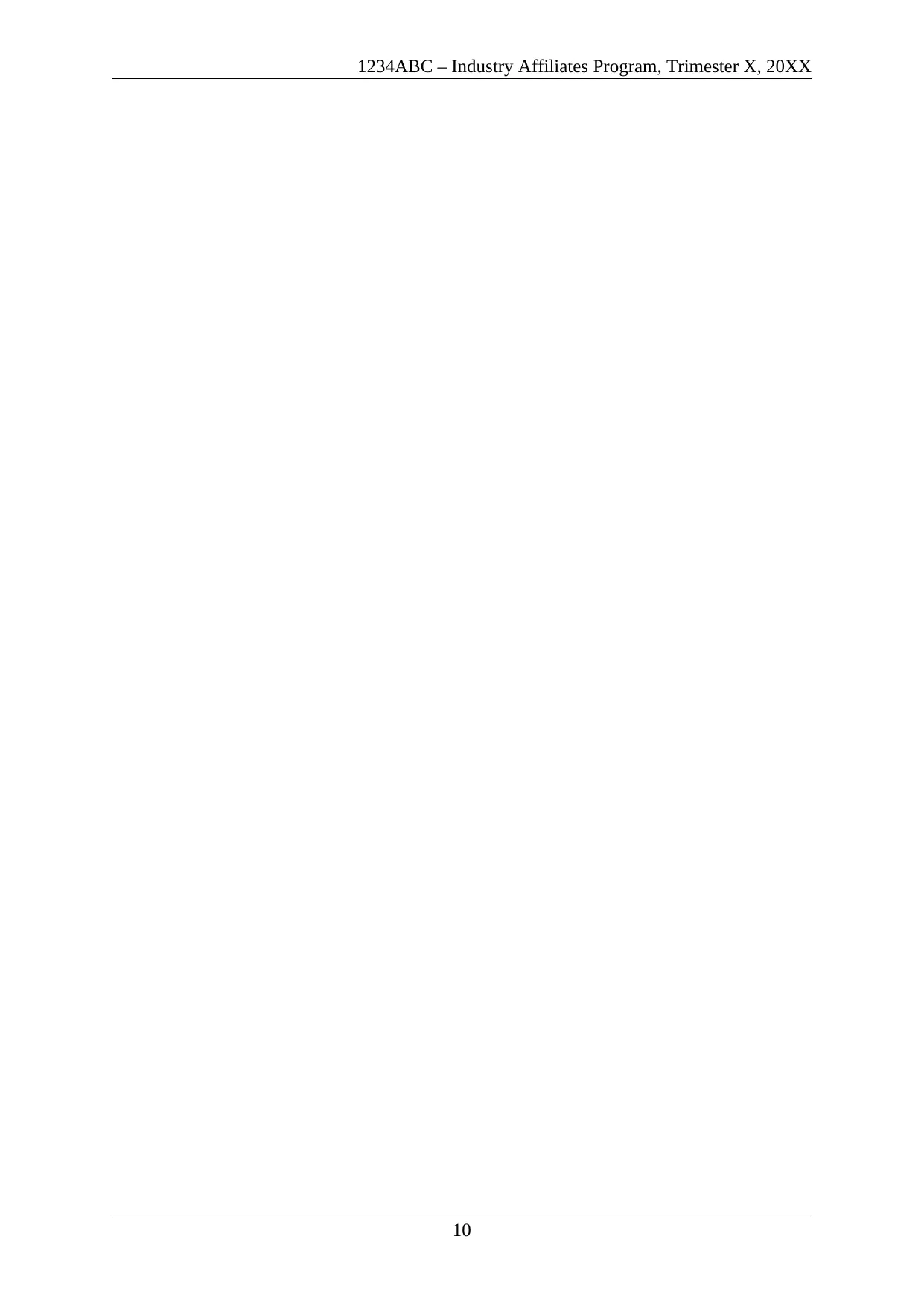
1234ABC – Industry Affiliates Program, Trimester X, 20XX
10
10
Secure Best Marks with AI Grader
Need help grading? Try our AI Grader for instant feedback on your assignments.
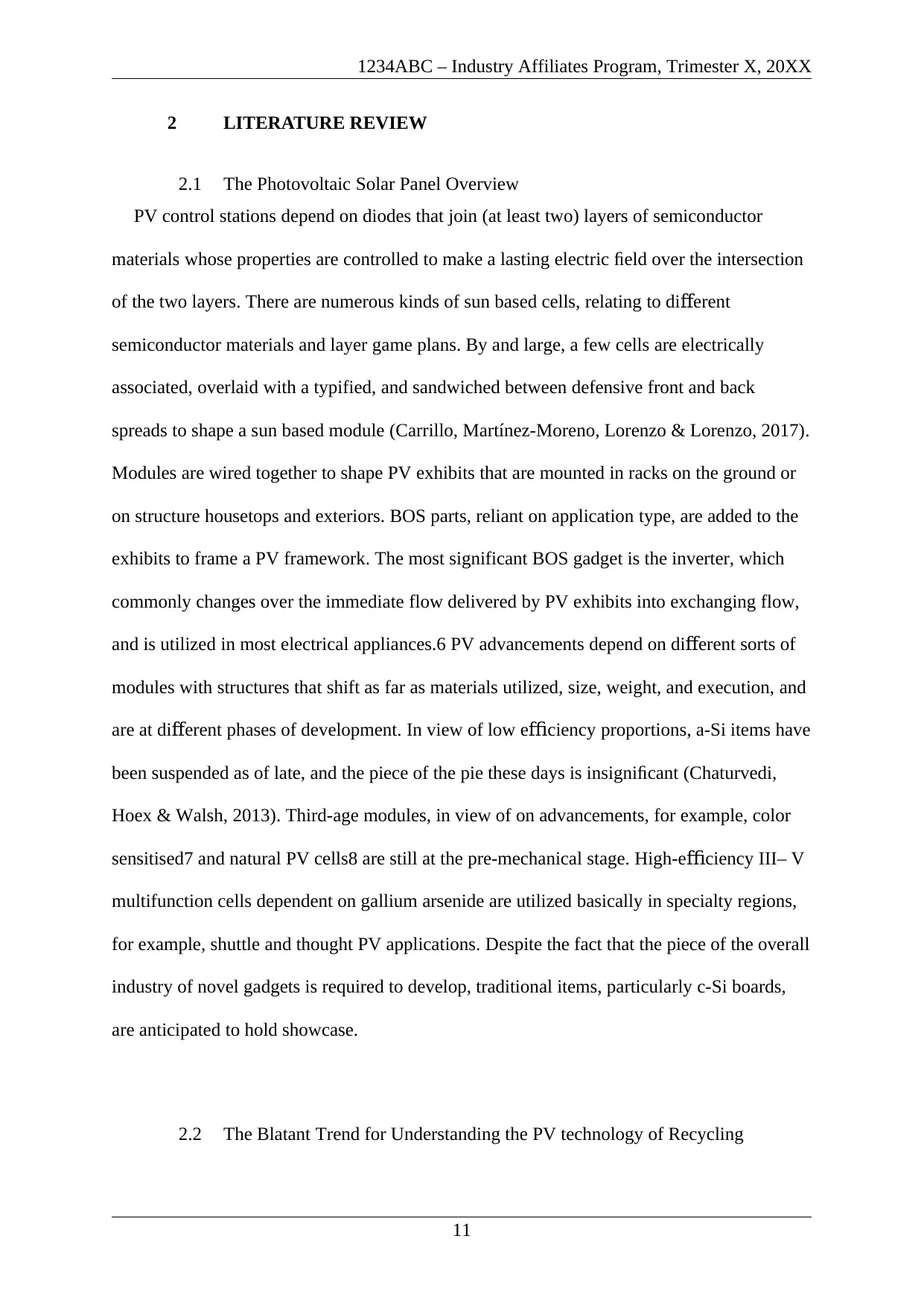
1234ABC – Industry Affiliates Program, Trimester X, 20XX
2 LITERATURE REVIEW
2.1 The Photovoltaic Solar Panel Overview
PV control stations depend on diodes that join (at least two) layers of semiconductor
materials whose properties are controlled to make a lasting electric field over the intersection
of the two layers. There are numerous kinds of sun based cells, relating to di erentff
semiconductor materials and layer game plans. By and large, a few cells are electrically
associated, overlaid with a typified, and sandwiched between defensive front and back
spreads to shape a sun based module (Carrillo, Martínez-Moreno, Lorenzo & Lorenzo, 2017).
Modules are wired together to shape PV exhibits that are mounted in racks on the ground or
on structure housetops and exteriors. BOS parts, reliant on application type, are added to the
exhibits to frame a PV framework. The most significant BOS gadget is the inverter, which
commonly changes over the immediate flow delivered by PV exhibits into exchanging flow,
and is utilized in most electrical appliances.6 PV advancements depend on di erent sorts offf
modules with structures that shift as far as materials utilized, size, weight, and execution, and
are at di erent phases of development. In view of low e ciency proportions, a-Si items haveff ffi
been suspended as of late, and the piece of the pie these days is insignificant (Chaturvedi,
Hoex & Walsh, 2013). Third-age modules, in view of on advancements, for example, color
sensitised7 and natural PV cells8 are still at the pre-mechanical stage. High-e ciency III– Vffi
multifunction cells dependent on gallium arsenide are utilized basically in specialty regions,
for example, shuttle and thought PV applications. Despite the fact that the piece of the overall
industry of novel gadgets is required to develop, traditional items, particularly c-Si boards,
are anticipated to hold showcase.
2.2 The Blatant Trend for Understanding the PV technology of Recycling
11
2 LITERATURE REVIEW
2.1 The Photovoltaic Solar Panel Overview
PV control stations depend on diodes that join (at least two) layers of semiconductor
materials whose properties are controlled to make a lasting electric field over the intersection
of the two layers. There are numerous kinds of sun based cells, relating to di erentff
semiconductor materials and layer game plans. By and large, a few cells are electrically
associated, overlaid with a typified, and sandwiched between defensive front and back
spreads to shape a sun based module (Carrillo, Martínez-Moreno, Lorenzo & Lorenzo, 2017).
Modules are wired together to shape PV exhibits that are mounted in racks on the ground or
on structure housetops and exteriors. BOS parts, reliant on application type, are added to the
exhibits to frame a PV framework. The most significant BOS gadget is the inverter, which
commonly changes over the immediate flow delivered by PV exhibits into exchanging flow,
and is utilized in most electrical appliances.6 PV advancements depend on di erent sorts offf
modules with structures that shift as far as materials utilized, size, weight, and execution, and
are at di erent phases of development. In view of low e ciency proportions, a-Si items haveff ffi
been suspended as of late, and the piece of the pie these days is insignificant (Chaturvedi,
Hoex & Walsh, 2013). Third-age modules, in view of on advancements, for example, color
sensitised7 and natural PV cells8 are still at the pre-mechanical stage. High-e ciency III– Vffi
multifunction cells dependent on gallium arsenide are utilized basically in specialty regions,
for example, shuttle and thought PV applications. Despite the fact that the piece of the overall
industry of novel gadgets is required to develop, traditional items, particularly c-Si boards,
are anticipated to hold showcase.
2.2 The Blatant Trend for Understanding the PV technology of Recycling
11
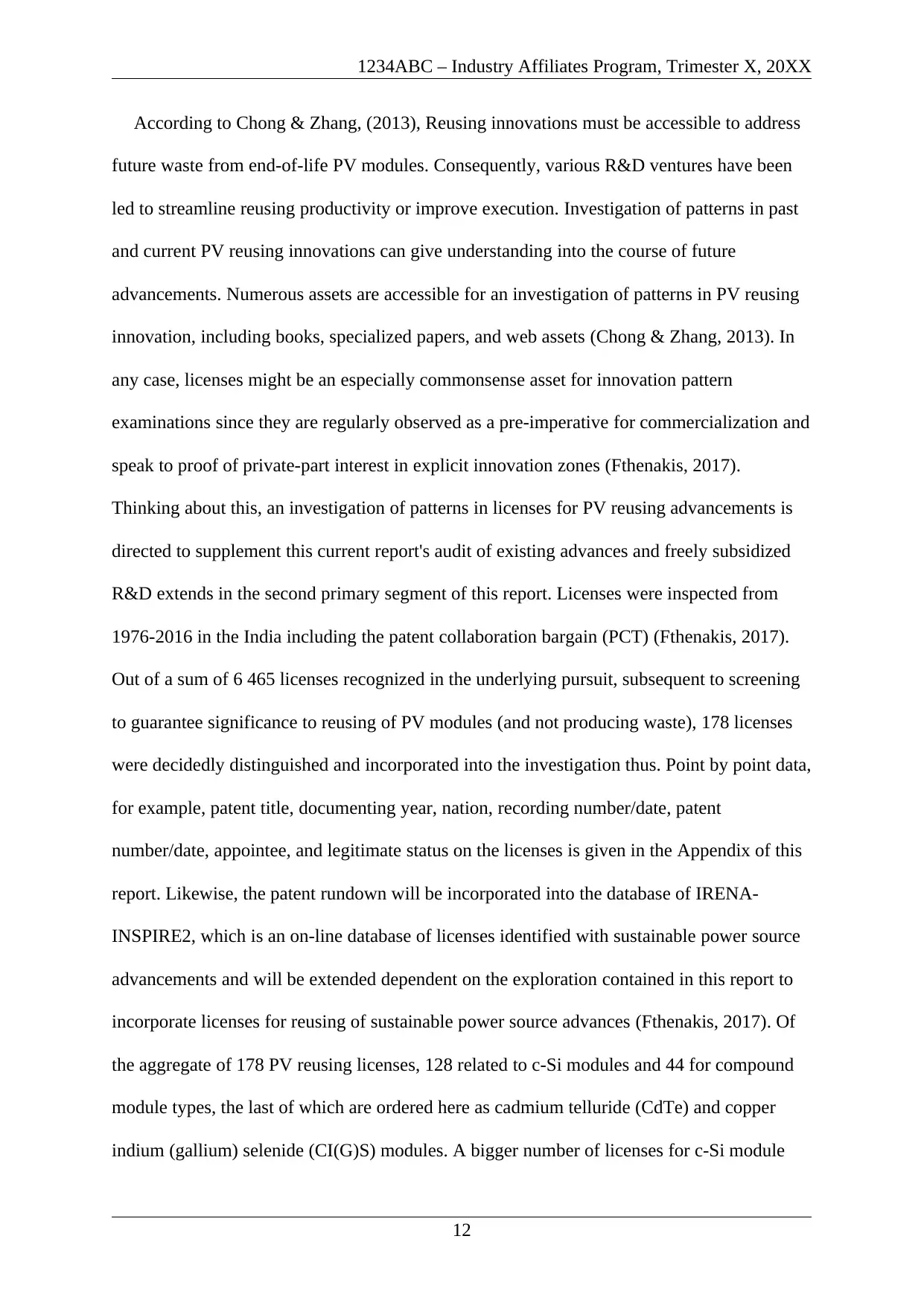
1234ABC – Industry Affiliates Program, Trimester X, 20XX
According to Chong & Zhang, (2013), Reusing innovations must be accessible to address
future waste from end-of-life PV modules. Consequently, various R&D ventures have been
led to streamline reusing productivity or improve execution. Investigation of patterns in past
and current PV reusing innovations can give understanding into the course of future
advancements. Numerous assets are accessible for an investigation of patterns in PV reusing
innovation, including books, specialized papers, and web assets (Chong & Zhang, 2013). In
any case, licenses might be an especially commonsense asset for innovation pattern
examinations since they are regularly observed as a pre-imperative for commercialization and
speak to proof of private-part interest in explicit innovation zones (Fthenakis, 2017).
Thinking about this, an investigation of patterns in licenses for PV reusing advancements is
directed to supplement this current report's audit of existing advances and freely subsidized
R&D extends in the second primary segment of this report. Licenses were inspected from
1976-2016 in the India including the patent collaboration bargain (PCT) (Fthenakis, 2017).
Out of a sum of 6 465 licenses recognized in the underlying pursuit, subsequent to screening
to guarantee significance to reusing of PV modules (and not producing waste), 178 licenses
were decidedly distinguished and incorporated into the investigation thus. Point by point data,
for example, patent title, documenting year, nation, recording number/date, patent
number/date, appointee, and legitimate status on the licenses is given in the Appendix of this
report. Likewise, the patent rundown will be incorporated into the database of IRENA-
INSPIRE2, which is an on-line database of licenses identified with sustainable power source
advancements and will be extended dependent on the exploration contained in this report to
incorporate licenses for reusing of sustainable power source advances (Fthenakis, 2017). Of
the aggregate of 178 PV reusing licenses, 128 related to c-Si modules and 44 for compound
module types, the last of which are ordered here as cadmium telluride (CdTe) and copper
indium (gallium) selenide (CI(G)S) modules. A bigger number of licenses for c-Si module
12
According to Chong & Zhang, (2013), Reusing innovations must be accessible to address
future waste from end-of-life PV modules. Consequently, various R&D ventures have been
led to streamline reusing productivity or improve execution. Investigation of patterns in past
and current PV reusing innovations can give understanding into the course of future
advancements. Numerous assets are accessible for an investigation of patterns in PV reusing
innovation, including books, specialized papers, and web assets (Chong & Zhang, 2013). In
any case, licenses might be an especially commonsense asset for innovation pattern
examinations since they are regularly observed as a pre-imperative for commercialization and
speak to proof of private-part interest in explicit innovation zones (Fthenakis, 2017).
Thinking about this, an investigation of patterns in licenses for PV reusing advancements is
directed to supplement this current report's audit of existing advances and freely subsidized
R&D extends in the second primary segment of this report. Licenses were inspected from
1976-2016 in the India including the patent collaboration bargain (PCT) (Fthenakis, 2017).
Out of a sum of 6 465 licenses recognized in the underlying pursuit, subsequent to screening
to guarantee significance to reusing of PV modules (and not producing waste), 178 licenses
were decidedly distinguished and incorporated into the investigation thus. Point by point data,
for example, patent title, documenting year, nation, recording number/date, patent
number/date, appointee, and legitimate status on the licenses is given in the Appendix of this
report. Likewise, the patent rundown will be incorporated into the database of IRENA-
INSPIRE2, which is an on-line database of licenses identified with sustainable power source
advancements and will be extended dependent on the exploration contained in this report to
incorporate licenses for reusing of sustainable power source advances (Fthenakis, 2017). Of
the aggregate of 178 PV reusing licenses, 128 related to c-Si modules and 44 for compound
module types, the last of which are ordered here as cadmium telluride (CdTe) and copper
indium (gallium) selenide (CI(G)S) modules. A bigger number of licenses for c-Si module
12
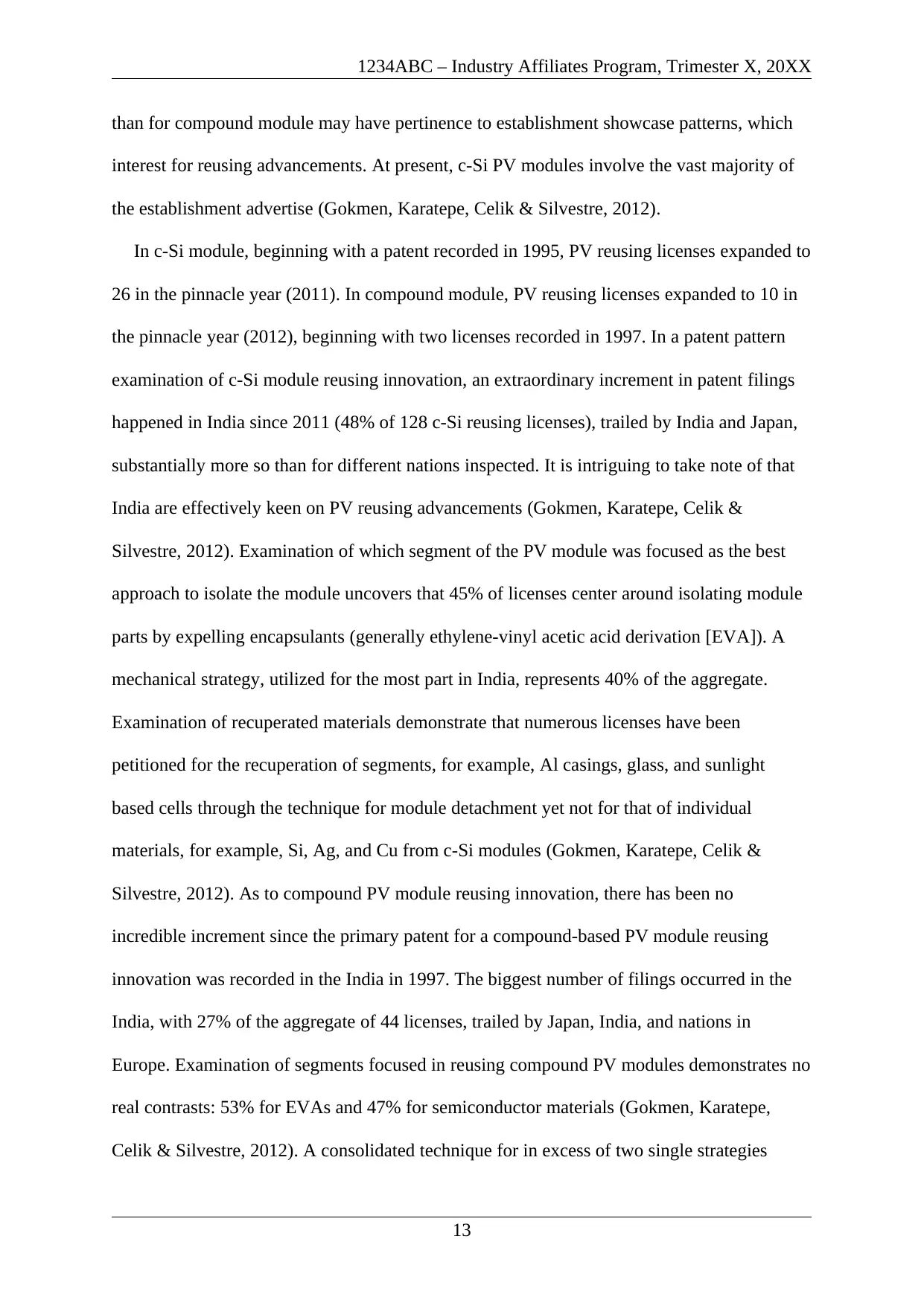
1234ABC – Industry Affiliates Program, Trimester X, 20XX
than for compound module may have pertinence to establishment showcase patterns, which
interest for reusing advancements. At present, c-Si PV modules involve the vast majority of
the establishment advertise (Gokmen, Karatepe, Celik & Silvestre, 2012).
In c-Si module, beginning with a patent recorded in 1995, PV reusing licenses expanded to
26 in the pinnacle year (2011). In compound module, PV reusing licenses expanded to 10 in
the pinnacle year (2012), beginning with two licenses recorded in 1997. In a patent pattern
examination of c-Si module reusing innovation, an extraordinary increment in patent filings
happened in India since 2011 (48% of 128 c-Si reusing licenses), trailed by India and Japan,
substantially more so than for different nations inspected. It is intriguing to take note of that
India are effectively keen on PV reusing advancements (Gokmen, Karatepe, Celik &
Silvestre, 2012). Examination of which segment of the PV module was focused as the best
approach to isolate the module uncovers that 45% of licenses center around isolating module
parts by expelling encapsulants (generally ethylene-vinyl acetic acid derivation [EVA]). A
mechanical strategy, utilized for the most part in India, represents 40% of the aggregate.
Examination of recuperated materials demonstrate that numerous licenses have been
petitioned for the recuperation of segments, for example, Al casings, glass, and sunlight
based cells through the technique for module detachment yet not for that of individual
materials, for example, Si, Ag, and Cu from c-Si modules (Gokmen, Karatepe, Celik &
Silvestre, 2012). As to compound PV module reusing innovation, there has been no
incredible increment since the primary patent for a compound-based PV module reusing
innovation was recorded in the India in 1997. The biggest number of filings occurred in the
India, with 27% of the aggregate of 44 licenses, trailed by Japan, India, and nations in
Europe. Examination of segments focused in reusing compound PV modules demonstrates no
real contrasts: 53% for EVAs and 47% for semiconductor materials (Gokmen, Karatepe,
Celik & Silvestre, 2012). A consolidated technique for in excess of two single strategies
13
than for compound module may have pertinence to establishment showcase patterns, which
interest for reusing advancements. At present, c-Si PV modules involve the vast majority of
the establishment advertise (Gokmen, Karatepe, Celik & Silvestre, 2012).
In c-Si module, beginning with a patent recorded in 1995, PV reusing licenses expanded to
26 in the pinnacle year (2011). In compound module, PV reusing licenses expanded to 10 in
the pinnacle year (2012), beginning with two licenses recorded in 1997. In a patent pattern
examination of c-Si module reusing innovation, an extraordinary increment in patent filings
happened in India since 2011 (48% of 128 c-Si reusing licenses), trailed by India and Japan,
substantially more so than for different nations inspected. It is intriguing to take note of that
India are effectively keen on PV reusing advancements (Gokmen, Karatepe, Celik &
Silvestre, 2012). Examination of which segment of the PV module was focused as the best
approach to isolate the module uncovers that 45% of licenses center around isolating module
parts by expelling encapsulants (generally ethylene-vinyl acetic acid derivation [EVA]). A
mechanical strategy, utilized for the most part in India, represents 40% of the aggregate.
Examination of recuperated materials demonstrate that numerous licenses have been
petitioned for the recuperation of segments, for example, Al casings, glass, and sunlight
based cells through the technique for module detachment yet not for that of individual
materials, for example, Si, Ag, and Cu from c-Si modules (Gokmen, Karatepe, Celik &
Silvestre, 2012). As to compound PV module reusing innovation, there has been no
incredible increment since the primary patent for a compound-based PV module reusing
innovation was recorded in the India in 1997. The biggest number of filings occurred in the
India, with 27% of the aggregate of 44 licenses, trailed by Japan, India, and nations in
Europe. Examination of segments focused in reusing compound PV modules demonstrates no
real contrasts: 53% for EVAs and 47% for semiconductor materials (Gokmen, Karatepe,
Celik & Silvestre, 2012). A consolidated technique for in excess of two single strategies
13
Paraphrase This Document
Need a fresh take? Get an instant paraphrase of this document with our AI Paraphraser
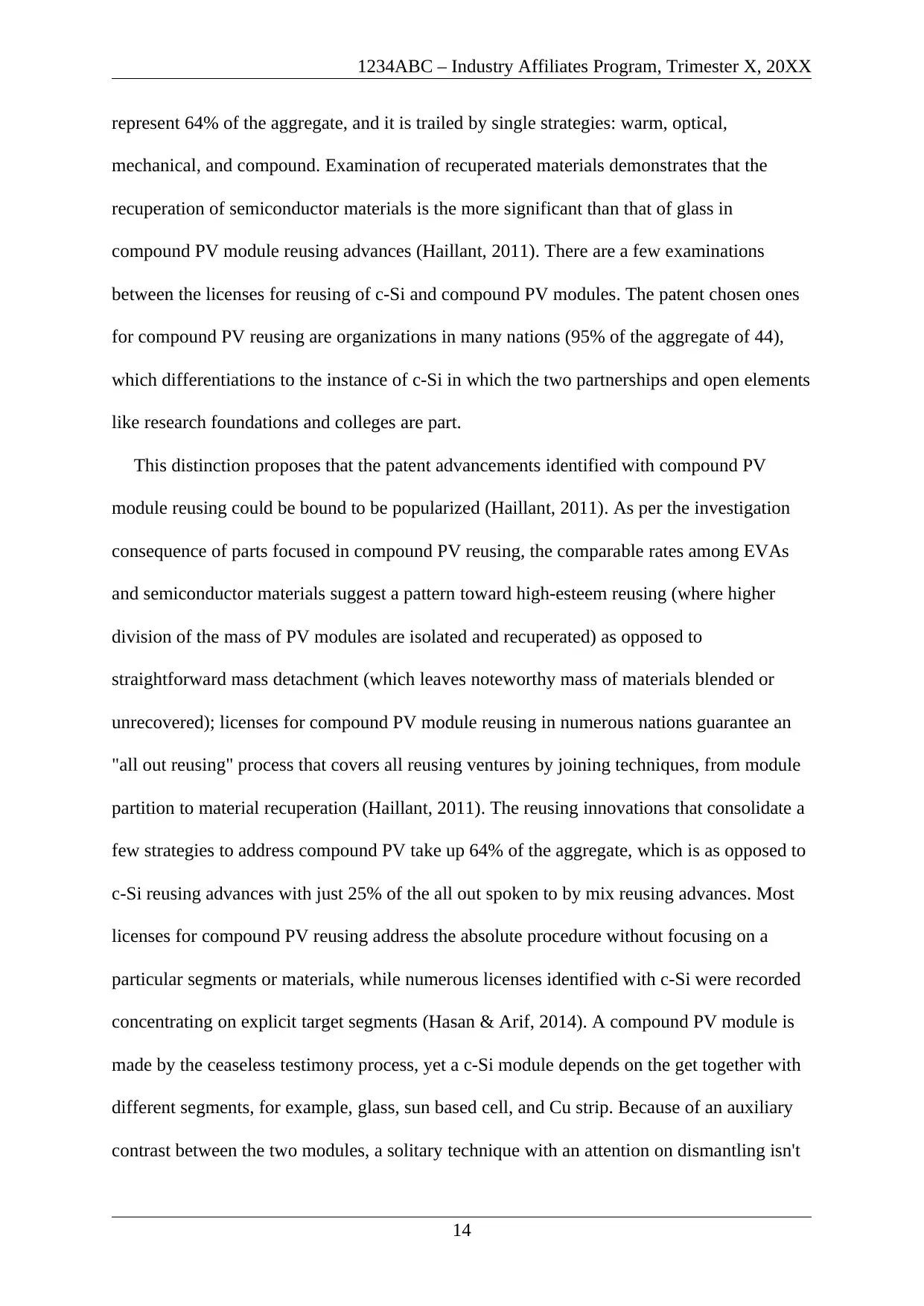
1234ABC – Industry Affiliates Program, Trimester X, 20XX
represent 64% of the aggregate, and it is trailed by single strategies: warm, optical,
mechanical, and compound. Examination of recuperated materials demonstrates that the
recuperation of semiconductor materials is the more significant than that of glass in
compound PV module reusing advances (Haillant, 2011). There are a few examinations
between the licenses for reusing of c-Si and compound PV modules. The patent chosen ones
for compound PV reusing are organizations in many nations (95% of the aggregate of 44),
which differentiations to the instance of c-Si in which the two partnerships and open elements
like research foundations and colleges are part.
This distinction proposes that the patent advancements identified with compound PV
module reusing could be bound to be popularized (Haillant, 2011). As per the investigation
consequence of parts focused in compound PV reusing, the comparable rates among EVAs
and semiconductor materials suggest a pattern toward high-esteem reusing (where higher
division of the mass of PV modules are isolated and recuperated) as opposed to
straightforward mass detachment (which leaves noteworthy mass of materials blended or
unrecovered); licenses for compound PV module reusing in numerous nations guarantee an
"all out reusing" process that covers all reusing ventures by joining techniques, from module
partition to material recuperation (Haillant, 2011). The reusing innovations that consolidate a
few strategies to address compound PV take up 64% of the aggregate, which is as opposed to
c-Si reusing advances with just 25% of the all out spoken to by mix reusing advances. Most
licenses for compound PV reusing address the absolute procedure without focusing on a
particular segments or materials, while numerous licenses identified with c-Si were recorded
concentrating on explicit target segments (Hasan & Arif, 2014). A compound PV module is
made by the ceaseless testimony process, yet a c-Si module depends on the get together with
different segments, for example, glass, sun based cell, and Cu strip. Because of an auxiliary
contrast between the two modules, a solitary technique with an attention on dismantling isn't
14
represent 64% of the aggregate, and it is trailed by single strategies: warm, optical,
mechanical, and compound. Examination of recuperated materials demonstrates that the
recuperation of semiconductor materials is the more significant than that of glass in
compound PV module reusing advances (Haillant, 2011). There are a few examinations
between the licenses for reusing of c-Si and compound PV modules. The patent chosen ones
for compound PV reusing are organizations in many nations (95% of the aggregate of 44),
which differentiations to the instance of c-Si in which the two partnerships and open elements
like research foundations and colleges are part.
This distinction proposes that the patent advancements identified with compound PV
module reusing could be bound to be popularized (Haillant, 2011). As per the investigation
consequence of parts focused in compound PV reusing, the comparable rates among EVAs
and semiconductor materials suggest a pattern toward high-esteem reusing (where higher
division of the mass of PV modules are isolated and recuperated) as opposed to
straightforward mass detachment (which leaves noteworthy mass of materials blended or
unrecovered); licenses for compound PV module reusing in numerous nations guarantee an
"all out reusing" process that covers all reusing ventures by joining techniques, from module
partition to material recuperation (Haillant, 2011). The reusing innovations that consolidate a
few strategies to address compound PV take up 64% of the aggregate, which is as opposed to
c-Si reusing advances with just 25% of the all out spoken to by mix reusing advances. Most
licenses for compound PV reusing address the absolute procedure without focusing on a
particular segments or materials, while numerous licenses identified with c-Si were recorded
concentrating on explicit target segments (Hasan & Arif, 2014). A compound PV module is
made by the ceaseless testimony process, yet a c-Si module depends on the get together with
different segments, for example, glass, sun based cell, and Cu strip. Because of an auxiliary
contrast between the two modules, a solitary technique with an attention on dismantling isn't
14
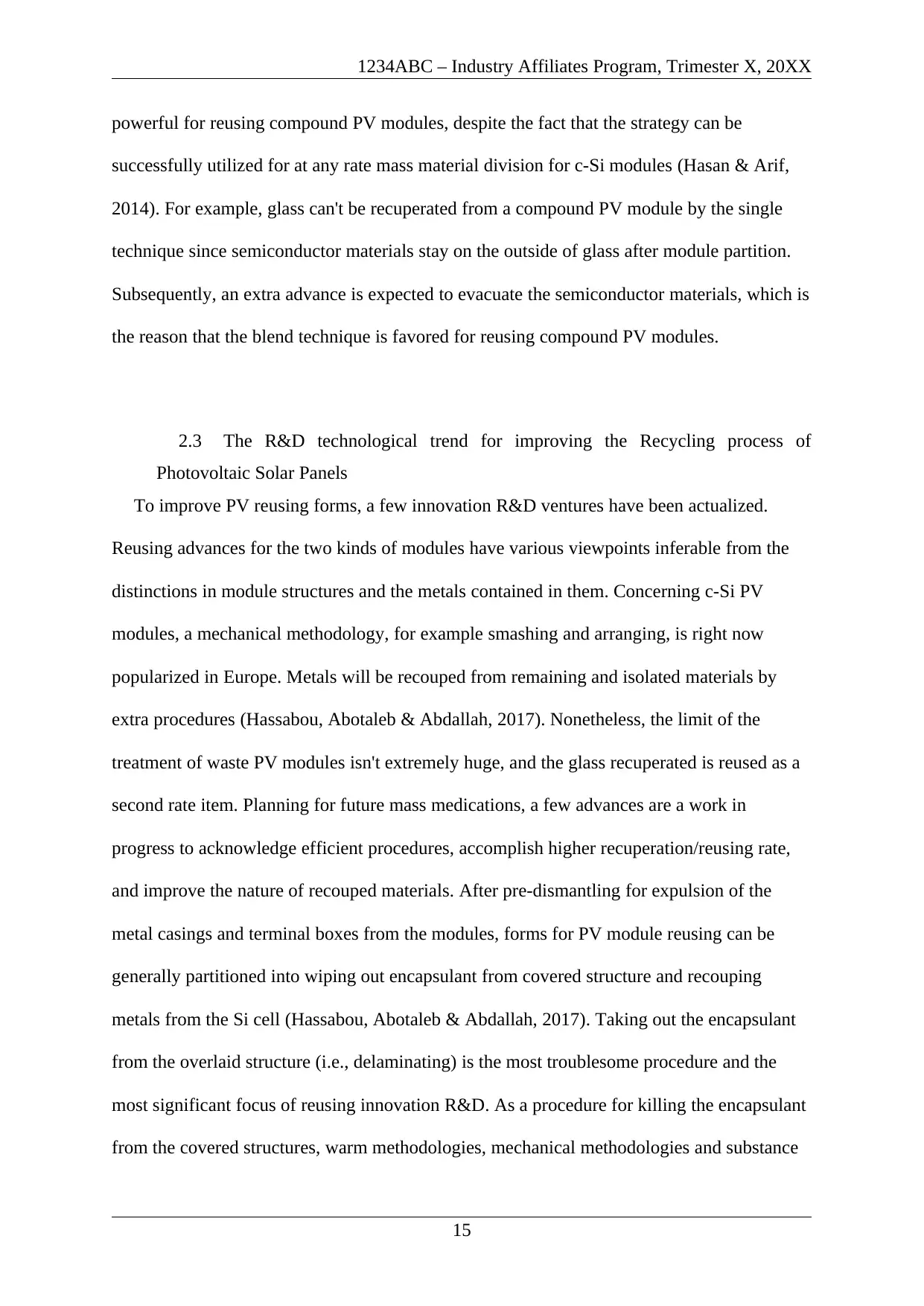
1234ABC – Industry Affiliates Program, Trimester X, 20XX
powerful for reusing compound PV modules, despite the fact that the strategy can be
successfully utilized for at any rate mass material division for c-Si modules (Hasan & Arif,
2014). For example, glass can't be recuperated from a compound PV module by the single
technique since semiconductor materials stay on the outside of glass after module partition.
Subsequently, an extra advance is expected to evacuate the semiconductor materials, which is
the reason that the blend technique is favored for reusing compound PV modules.
2.3 The R&D technological trend for improving the Recycling process of
Photovoltaic Solar Panels
To improve PV reusing forms, a few innovation R&D ventures have been actualized.
Reusing advances for the two kinds of modules have various viewpoints inferable from the
distinctions in module structures and the metals contained in them. Concerning c-Si PV
modules, a mechanical methodology, for example smashing and arranging, is right now
popularized in Europe. Metals will be recouped from remaining and isolated materials by
extra procedures (Hassabou, Abotaleb & Abdallah, 2017). Nonetheless, the limit of the
treatment of waste PV modules isn't extremely huge, and the glass recuperated is reused as a
second rate item. Planning for future mass medications, a few advances are a work in
progress to acknowledge efficient procedures, accomplish higher recuperation/reusing rate,
and improve the nature of recouped materials. After pre-dismantling for expulsion of the
metal casings and terminal boxes from the modules, forms for PV module reusing can be
generally partitioned into wiping out encapsulant from covered structure and recouping
metals from the Si cell (Hassabou, Abotaleb & Abdallah, 2017). Taking out the encapsulant
from the overlaid structure (i.e., delaminating) is the most troublesome procedure and the
most significant focus of reusing innovation R&D. As a procedure for killing the encapsulant
from the covered structures, warm methodologies, mechanical methodologies and substance
15
powerful for reusing compound PV modules, despite the fact that the strategy can be
successfully utilized for at any rate mass material division for c-Si modules (Hasan & Arif,
2014). For example, glass can't be recuperated from a compound PV module by the single
technique since semiconductor materials stay on the outside of glass after module partition.
Subsequently, an extra advance is expected to evacuate the semiconductor materials, which is
the reason that the blend technique is favored for reusing compound PV modules.
2.3 The R&D technological trend for improving the Recycling process of
Photovoltaic Solar Panels
To improve PV reusing forms, a few innovation R&D ventures have been actualized.
Reusing advances for the two kinds of modules have various viewpoints inferable from the
distinctions in module structures and the metals contained in them. Concerning c-Si PV
modules, a mechanical methodology, for example smashing and arranging, is right now
popularized in Europe. Metals will be recouped from remaining and isolated materials by
extra procedures (Hassabou, Abotaleb & Abdallah, 2017). Nonetheless, the limit of the
treatment of waste PV modules isn't extremely huge, and the glass recuperated is reused as a
second rate item. Planning for future mass medications, a few advances are a work in
progress to acknowledge efficient procedures, accomplish higher recuperation/reusing rate,
and improve the nature of recouped materials. After pre-dismantling for expulsion of the
metal casings and terminal boxes from the modules, forms for PV module reusing can be
generally partitioned into wiping out encapsulant from covered structure and recouping
metals from the Si cell (Hassabou, Abotaleb & Abdallah, 2017). Taking out the encapsulant
from the overlaid structure (i.e., delaminating) is the most troublesome procedure and the
most significant focus of reusing innovation R&D. As a procedure for killing the encapsulant
from the covered structures, warm methodologies, mechanical methodologies and substance
15
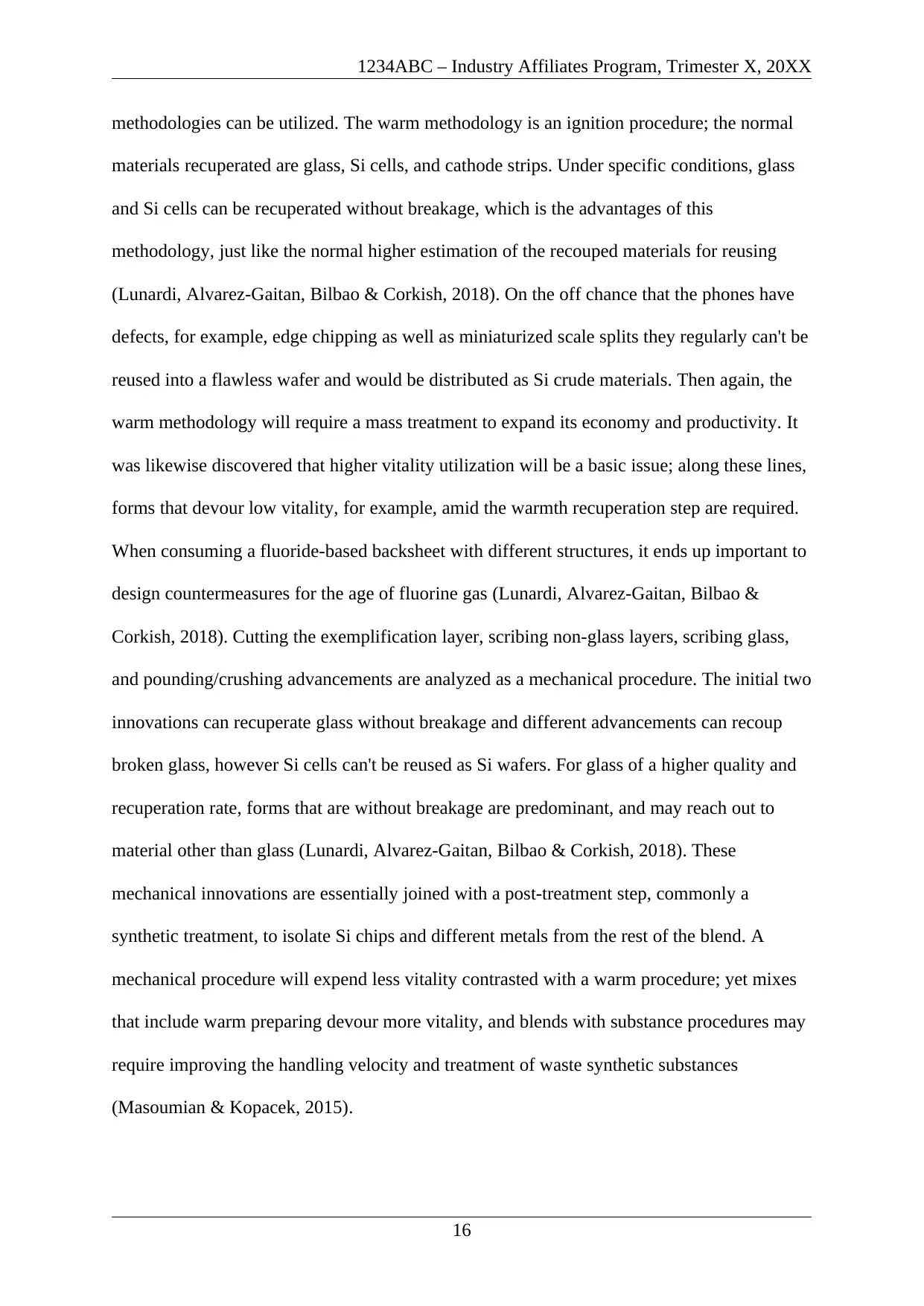
1234ABC – Industry Affiliates Program, Trimester X, 20XX
methodologies can be utilized. The warm methodology is an ignition procedure; the normal
materials recuperated are glass, Si cells, and cathode strips. Under specific conditions, glass
and Si cells can be recuperated without breakage, which is the advantages of this
methodology, just like the normal higher estimation of the recouped materials for reusing
(Lunardi, Alvarez-Gaitan, Bilbao & Corkish, 2018). On the off chance that the phones have
defects, for example, edge chipping as well as miniaturized scale splits they regularly can't be
reused into a flawless wafer and would be distributed as Si crude materials. Then again, the
warm methodology will require a mass treatment to expand its economy and productivity. It
was likewise discovered that higher vitality utilization will be a basic issue; along these lines,
forms that devour low vitality, for example, amid the warmth recuperation step are required.
When consuming a fluoride-based backsheet with different structures, it ends up important to
design countermeasures for the age of fluorine gas (Lunardi, Alvarez-Gaitan, Bilbao &
Corkish, 2018). Cutting the exemplification layer, scribing non-glass layers, scribing glass,
and pounding/crushing advancements are analyzed as a mechanical procedure. The initial two
innovations can recuperate glass without breakage and different advancements can recoup
broken glass, however Si cells can't be reused as Si wafers. For glass of a higher quality and
recuperation rate, forms that are without breakage are predominant, and may reach out to
material other than glass (Lunardi, Alvarez-Gaitan, Bilbao & Corkish, 2018). These
mechanical innovations are essentially joined with a post-treatment step, commonly a
synthetic treatment, to isolate Si chips and different metals from the rest of the blend. A
mechanical procedure will expend less vitality contrasted with a warm procedure; yet mixes
that include warm preparing devour more vitality, and blends with substance procedures may
require improving the handling velocity and treatment of waste synthetic substances
(Masoumian & Kopacek, 2015).
16
methodologies can be utilized. The warm methodology is an ignition procedure; the normal
materials recuperated are glass, Si cells, and cathode strips. Under specific conditions, glass
and Si cells can be recuperated without breakage, which is the advantages of this
methodology, just like the normal higher estimation of the recouped materials for reusing
(Lunardi, Alvarez-Gaitan, Bilbao & Corkish, 2018). On the off chance that the phones have
defects, for example, edge chipping as well as miniaturized scale splits they regularly can't be
reused into a flawless wafer and would be distributed as Si crude materials. Then again, the
warm methodology will require a mass treatment to expand its economy and productivity. It
was likewise discovered that higher vitality utilization will be a basic issue; along these lines,
forms that devour low vitality, for example, amid the warmth recuperation step are required.
When consuming a fluoride-based backsheet with different structures, it ends up important to
design countermeasures for the age of fluorine gas (Lunardi, Alvarez-Gaitan, Bilbao &
Corkish, 2018). Cutting the exemplification layer, scribing non-glass layers, scribing glass,
and pounding/crushing advancements are analyzed as a mechanical procedure. The initial two
innovations can recuperate glass without breakage and different advancements can recoup
broken glass, however Si cells can't be reused as Si wafers. For glass of a higher quality and
recuperation rate, forms that are without breakage are predominant, and may reach out to
material other than glass (Lunardi, Alvarez-Gaitan, Bilbao & Corkish, 2018). These
mechanical innovations are essentially joined with a post-treatment step, commonly a
synthetic treatment, to isolate Si chips and different metals from the rest of the blend. A
mechanical procedure will expend less vitality contrasted with a warm procedure; yet mixes
that include warm preparing devour more vitality, and blends with substance procedures may
require improving the handling velocity and treatment of waste synthetic substances
(Masoumian & Kopacek, 2015).
16
Secure Best Marks with AI Grader
Need help grading? Try our AI Grader for instant feedback on your assignments.
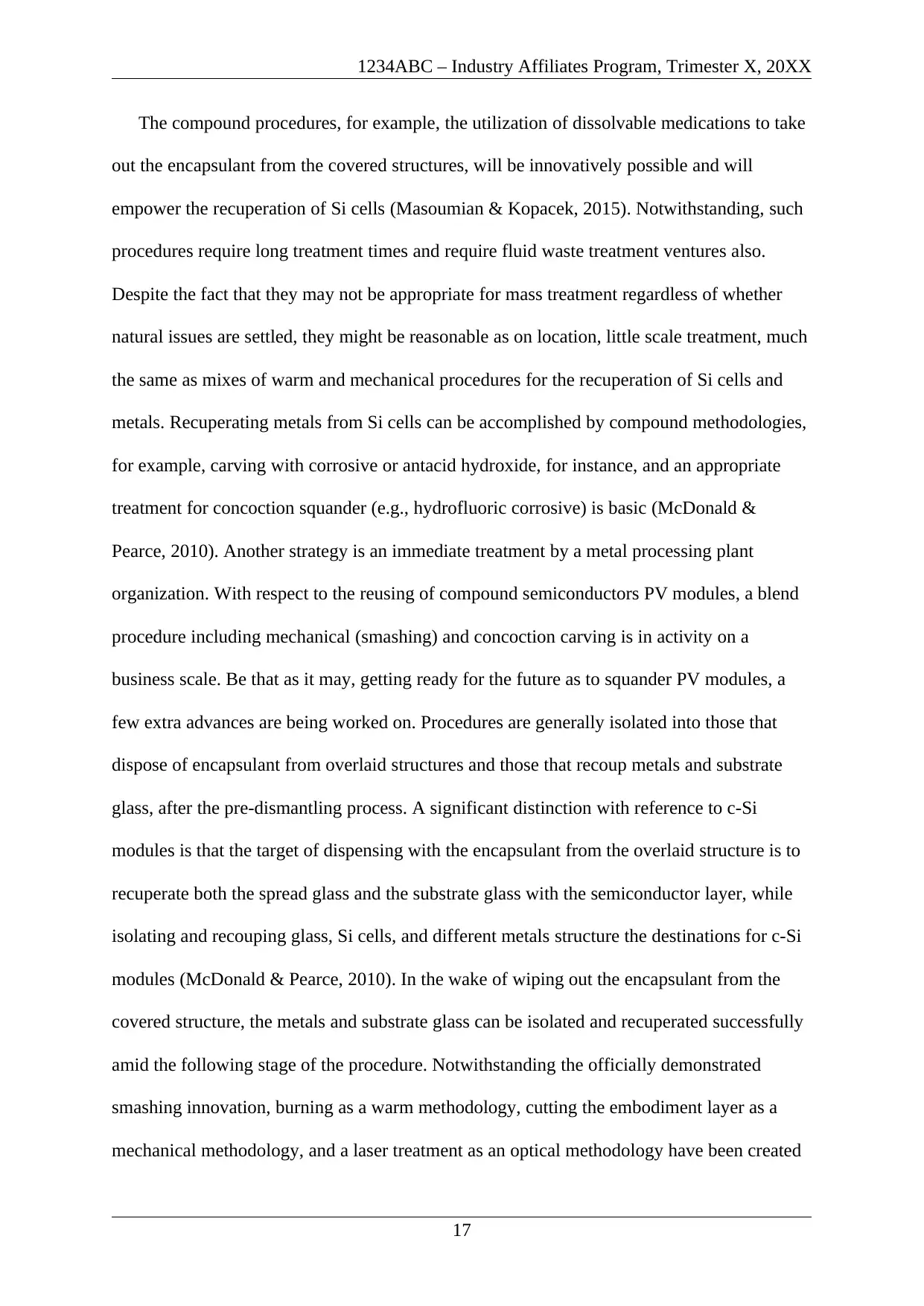
1234ABC – Industry Affiliates Program, Trimester X, 20XX
The compound procedures, for example, the utilization of dissolvable medications to take
out the encapsulant from the covered structures, will be innovatively possible and will
empower the recuperation of Si cells (Masoumian & Kopacek, 2015). Notwithstanding, such
procedures require long treatment times and require fluid waste treatment ventures also.
Despite the fact that they may not be appropriate for mass treatment regardless of whether
natural issues are settled, they might be reasonable as on location, little scale treatment, much
the same as mixes of warm and mechanical procedures for the recuperation of Si cells and
metals. Recuperating metals from Si cells can be accomplished by compound methodologies,
for example, carving with corrosive or antacid hydroxide, for instance, and an appropriate
treatment for concoction squander (e.g., hydrofluoric corrosive) is basic (McDonald &
Pearce, 2010). Another strategy is an immediate treatment by a metal processing plant
organization. With respect to the reusing of compound semiconductors PV modules, a blend
procedure including mechanical (smashing) and concoction carving is in activity on a
business scale. Be that as it may, getting ready for the future as to squander PV modules, a
few extra advances are being worked on. Procedures are generally isolated into those that
dispose of encapsulant from overlaid structures and those that recoup metals and substrate
glass, after the pre-dismantling process. A significant distinction with reference to c-Si
modules is that the target of dispensing with the encapsulant from the overlaid structure is to
recuperate both the spread glass and the substrate glass with the semiconductor layer, while
isolating and recouping glass, Si cells, and different metals structure the destinations for c-Si
modules (McDonald & Pearce, 2010). In the wake of wiping out the encapsulant from the
covered structure, the metals and substrate glass can be isolated and recuperated successfully
amid the following stage of the procedure. Notwithstanding the officially demonstrated
smashing innovation, burning as a warm methodology, cutting the embodiment layer as a
mechanical methodology, and a laser treatment as an optical methodology have been created
17
The compound procedures, for example, the utilization of dissolvable medications to take
out the encapsulant from the covered structures, will be innovatively possible and will
empower the recuperation of Si cells (Masoumian & Kopacek, 2015). Notwithstanding, such
procedures require long treatment times and require fluid waste treatment ventures also.
Despite the fact that they may not be appropriate for mass treatment regardless of whether
natural issues are settled, they might be reasonable as on location, little scale treatment, much
the same as mixes of warm and mechanical procedures for the recuperation of Si cells and
metals. Recuperating metals from Si cells can be accomplished by compound methodologies,
for example, carving with corrosive or antacid hydroxide, for instance, and an appropriate
treatment for concoction squander (e.g., hydrofluoric corrosive) is basic (McDonald &
Pearce, 2010). Another strategy is an immediate treatment by a metal processing plant
organization. With respect to the reusing of compound semiconductors PV modules, a blend
procedure including mechanical (smashing) and concoction carving is in activity on a
business scale. Be that as it may, getting ready for the future as to squander PV modules, a
few extra advances are being worked on. Procedures are generally isolated into those that
dispose of encapsulant from overlaid structures and those that recoup metals and substrate
glass, after the pre-dismantling process. A significant distinction with reference to c-Si
modules is that the target of dispensing with the encapsulant from the overlaid structure is to
recuperate both the spread glass and the substrate glass with the semiconductor layer, while
isolating and recouping glass, Si cells, and different metals structure the destinations for c-Si
modules (McDonald & Pearce, 2010). In the wake of wiping out the encapsulant from the
covered structure, the metals and substrate glass can be isolated and recuperated successfully
amid the following stage of the procedure. Notwithstanding the officially demonstrated
smashing innovation, burning as a warm methodology, cutting the embodiment layer as a
mechanical methodology, and a laser treatment as an optical methodology have been created
17
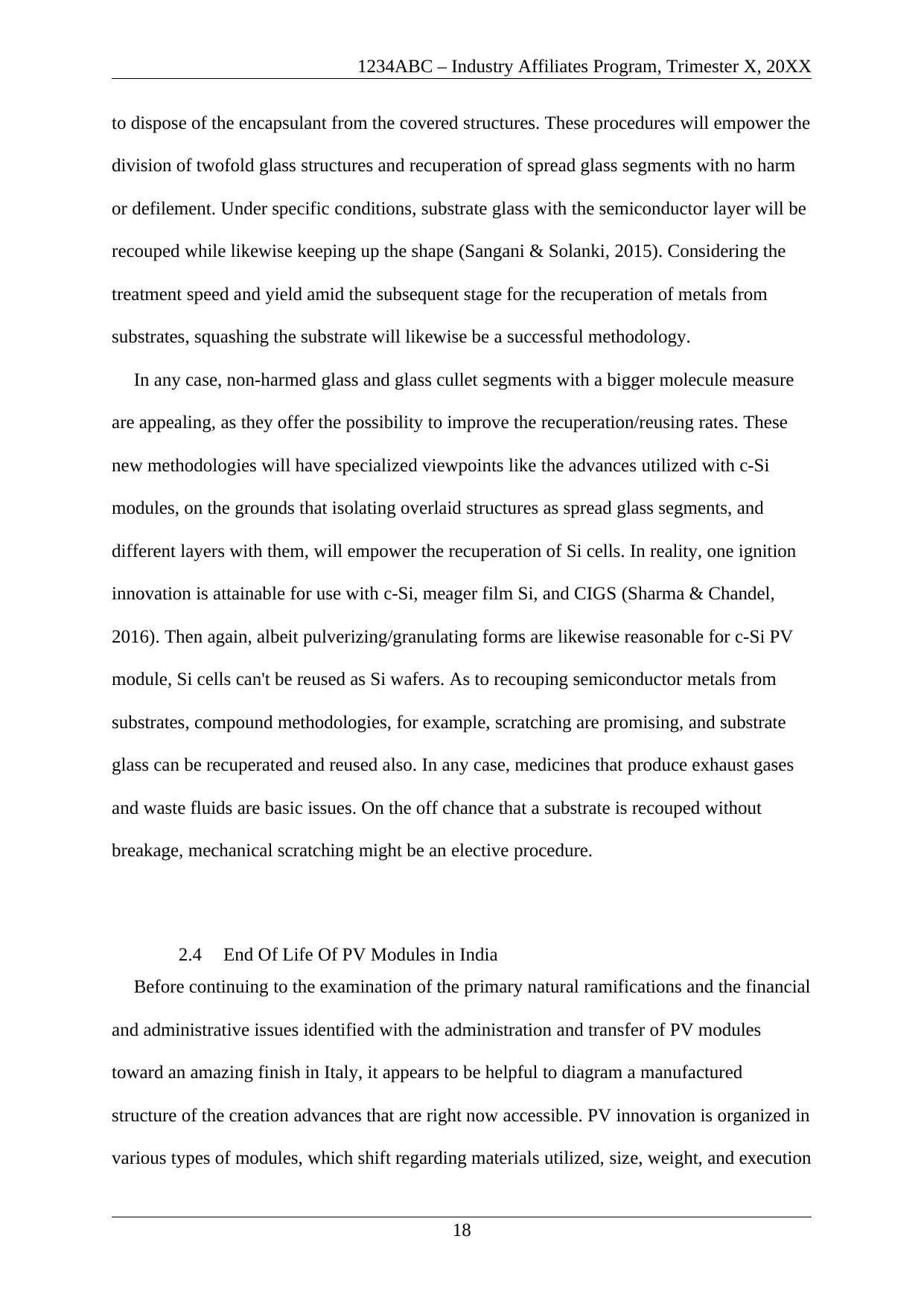
1234ABC – Industry Affiliates Program, Trimester X, 20XX
to dispose of the encapsulant from the covered structures. These procedures will empower the
division of twofold glass structures and recuperation of spread glass segments with no harm
or defilement. Under specific conditions, substrate glass with the semiconductor layer will be
recouped while likewise keeping up the shape (Sangani & Solanki, 2015). Considering the
treatment speed and yield amid the subsequent stage for the recuperation of metals from
substrates, squashing the substrate will likewise be a successful methodology.
In any case, non-harmed glass and glass cullet segments with a bigger molecule measure
are appealing, as they offer the possibility to improve the recuperation/reusing rates. These
new methodologies will have specialized viewpoints like the advances utilized with c-Si
modules, on the grounds that isolating overlaid structures as spread glass segments, and
different layers with them, will empower the recuperation of Si cells. In reality, one ignition
innovation is attainable for use with c-Si, meager film Si, and CIGS (Sharma & Chandel,
2016). Then again, albeit pulverizing/granulating forms are likewise reasonable for c-Si PV
module, Si cells can't be reused as Si wafers. As to recouping semiconductor metals from
substrates, compound methodologies, for example, scratching are promising, and substrate
glass can be recuperated and reused also. In any case, medicines that produce exhaust gases
and waste fluids are basic issues. On the off chance that a substrate is recouped without
breakage, mechanical scratching might be an elective procedure.
2.4 End Of Life Of PV Modules in India
Before continuing to the examination of the primary natural ramifications and the financial
and administrative issues identified with the administration and transfer of PV modules
toward an amazing finish in Italy, it appears to be helpful to diagram a manufactured
structure of the creation advances that are right now accessible. PV innovation is organized in
various types of modules, which shift regarding materials utilized, size, weight, and execution
18
to dispose of the encapsulant from the covered structures. These procedures will empower the
division of twofold glass structures and recuperation of spread glass segments with no harm
or defilement. Under specific conditions, substrate glass with the semiconductor layer will be
recouped while likewise keeping up the shape (Sangani & Solanki, 2015). Considering the
treatment speed and yield amid the subsequent stage for the recuperation of metals from
substrates, squashing the substrate will likewise be a successful methodology.
In any case, non-harmed glass and glass cullet segments with a bigger molecule measure
are appealing, as they offer the possibility to improve the recuperation/reusing rates. These
new methodologies will have specialized viewpoints like the advances utilized with c-Si
modules, on the grounds that isolating overlaid structures as spread glass segments, and
different layers with them, will empower the recuperation of Si cells. In reality, one ignition
innovation is attainable for use with c-Si, meager film Si, and CIGS (Sharma & Chandel,
2016). Then again, albeit pulverizing/granulating forms are likewise reasonable for c-Si PV
module, Si cells can't be reused as Si wafers. As to recouping semiconductor metals from
substrates, compound methodologies, for example, scratching are promising, and substrate
glass can be recuperated and reused also. In any case, medicines that produce exhaust gases
and waste fluids are basic issues. On the off chance that a substrate is recouped without
breakage, mechanical scratching might be an elective procedure.
2.4 End Of Life Of PV Modules in India
Before continuing to the examination of the primary natural ramifications and the financial
and administrative issues identified with the administration and transfer of PV modules
toward an amazing finish in Italy, it appears to be helpful to diagram a manufactured
structure of the creation advances that are right now accessible. PV innovation is organized in
various types of modules, which shift regarding materials utilized, size, weight, and execution
18
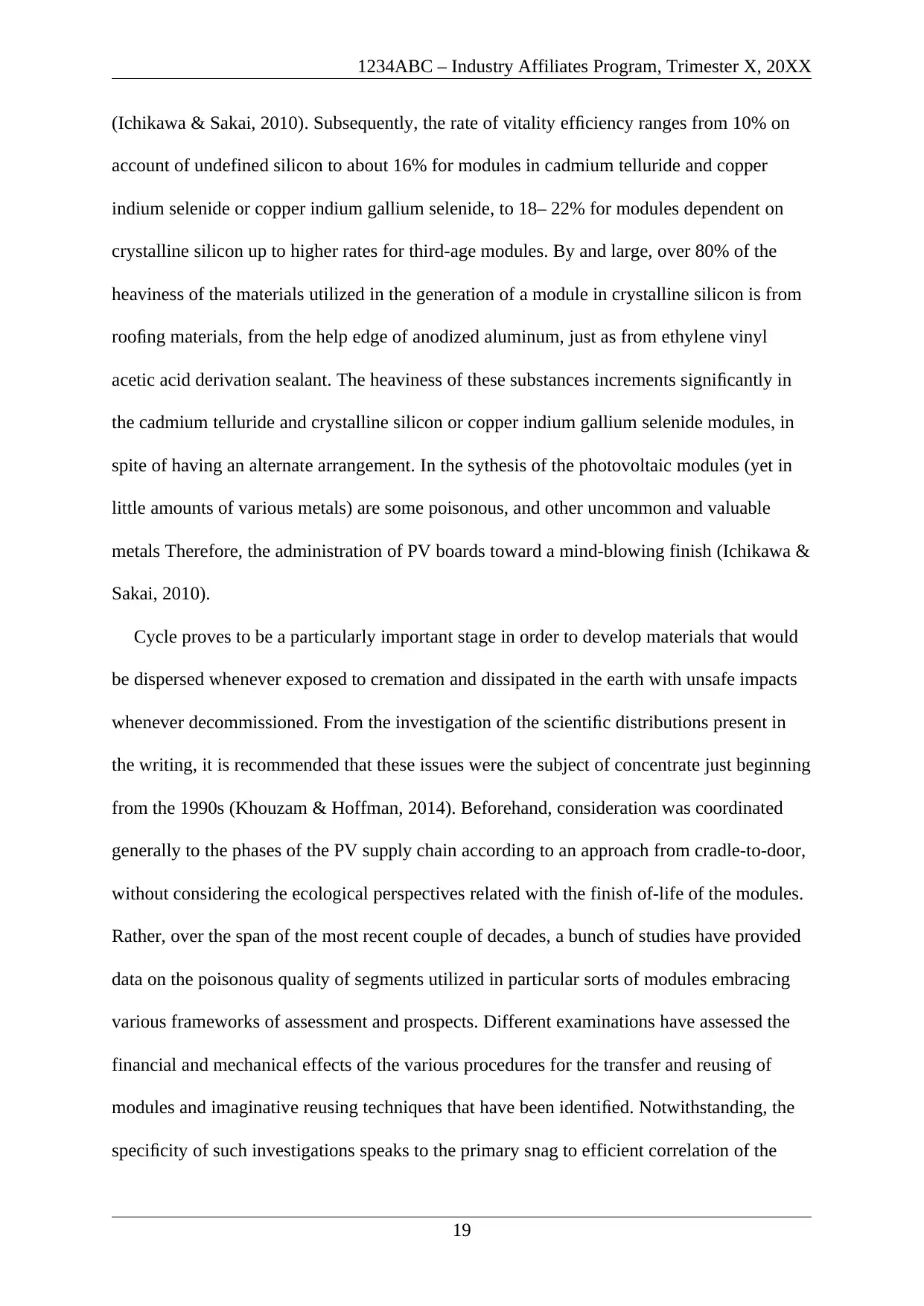
1234ABC – Industry Affiliates Program, Trimester X, 20XX
(Ichikawa & Sakai, 2010). Subsequently, the rate of vitality efficiency ranges from 10% on
account of undefined silicon to about 16% for modules in cadmium telluride and copper
indium selenide or copper indium gallium selenide, to 18– 22% for modules dependent on
crystalline silicon up to higher rates for third-age modules. By and large, over 80% of the
heaviness of the materials utilized in the generation of a module in crystalline silicon is from
roofing materials, from the help edge of anodized aluminum, just as from ethylene vinyl
acetic acid derivation sealant. The heaviness of these substances increments significantly in
the cadmium telluride and crystalline silicon or copper indium gallium selenide modules, in
spite of having an alternate arrangement. In the sythesis of the photovoltaic modules (yet in
little amounts of various metals) are some poisonous, and other uncommon and valuable
metals Therefore, the administration of PV boards toward a mind-blowing finish (Ichikawa &
Sakai, 2010).
Cycle proves to be a particularly important stage in order to develop materials that would
be dispersed whenever exposed to cremation and dissipated in the earth with unsafe impacts
whenever decommissioned. From the investigation of the scientific distributions present in
the writing, it is recommended that these issues were the subject of concentrate just beginning
from the 1990s (Khouzam & Hoffman, 2014). Beforehand, consideration was coordinated
generally to the phases of the PV supply chain according to an approach from cradle-to-door,
without considering the ecological perspectives related with the finish of-life of the modules.
Rather, over the span of the most recent couple of decades, a bunch of studies have provided
data on the poisonous quality of segments utilized in particular sorts of modules embracing
various frameworks of assessment and prospects. Different examinations have assessed the
financial and mechanical effects of the various procedures for the transfer and reusing of
modules and imaginative reusing techniques that have been identified. Notwithstanding, the
specificity of such investigations speaks to the primary snag to efficient correlation of the
19
(Ichikawa & Sakai, 2010). Subsequently, the rate of vitality efficiency ranges from 10% on
account of undefined silicon to about 16% for modules in cadmium telluride and copper
indium selenide or copper indium gallium selenide, to 18– 22% for modules dependent on
crystalline silicon up to higher rates for third-age modules. By and large, over 80% of the
heaviness of the materials utilized in the generation of a module in crystalline silicon is from
roofing materials, from the help edge of anodized aluminum, just as from ethylene vinyl
acetic acid derivation sealant. The heaviness of these substances increments significantly in
the cadmium telluride and crystalline silicon or copper indium gallium selenide modules, in
spite of having an alternate arrangement. In the sythesis of the photovoltaic modules (yet in
little amounts of various metals) are some poisonous, and other uncommon and valuable
metals Therefore, the administration of PV boards toward a mind-blowing finish (Ichikawa &
Sakai, 2010).
Cycle proves to be a particularly important stage in order to develop materials that would
be dispersed whenever exposed to cremation and dissipated in the earth with unsafe impacts
whenever decommissioned. From the investigation of the scientific distributions present in
the writing, it is recommended that these issues were the subject of concentrate just beginning
from the 1990s (Khouzam & Hoffman, 2014). Beforehand, consideration was coordinated
generally to the phases of the PV supply chain according to an approach from cradle-to-door,
without considering the ecological perspectives related with the finish of-life of the modules.
Rather, over the span of the most recent couple of decades, a bunch of studies have provided
data on the poisonous quality of segments utilized in particular sorts of modules embracing
various frameworks of assessment and prospects. Different examinations have assessed the
financial and mechanical effects of the various procedures for the transfer and reusing of
modules and imaginative reusing techniques that have been identified. Notwithstanding, the
specificity of such investigations speaks to the primary snag to efficient correlation of the
19
Paraphrase This Document
Need a fresh take? Get an instant paraphrase of this document with our AI Paraphraser
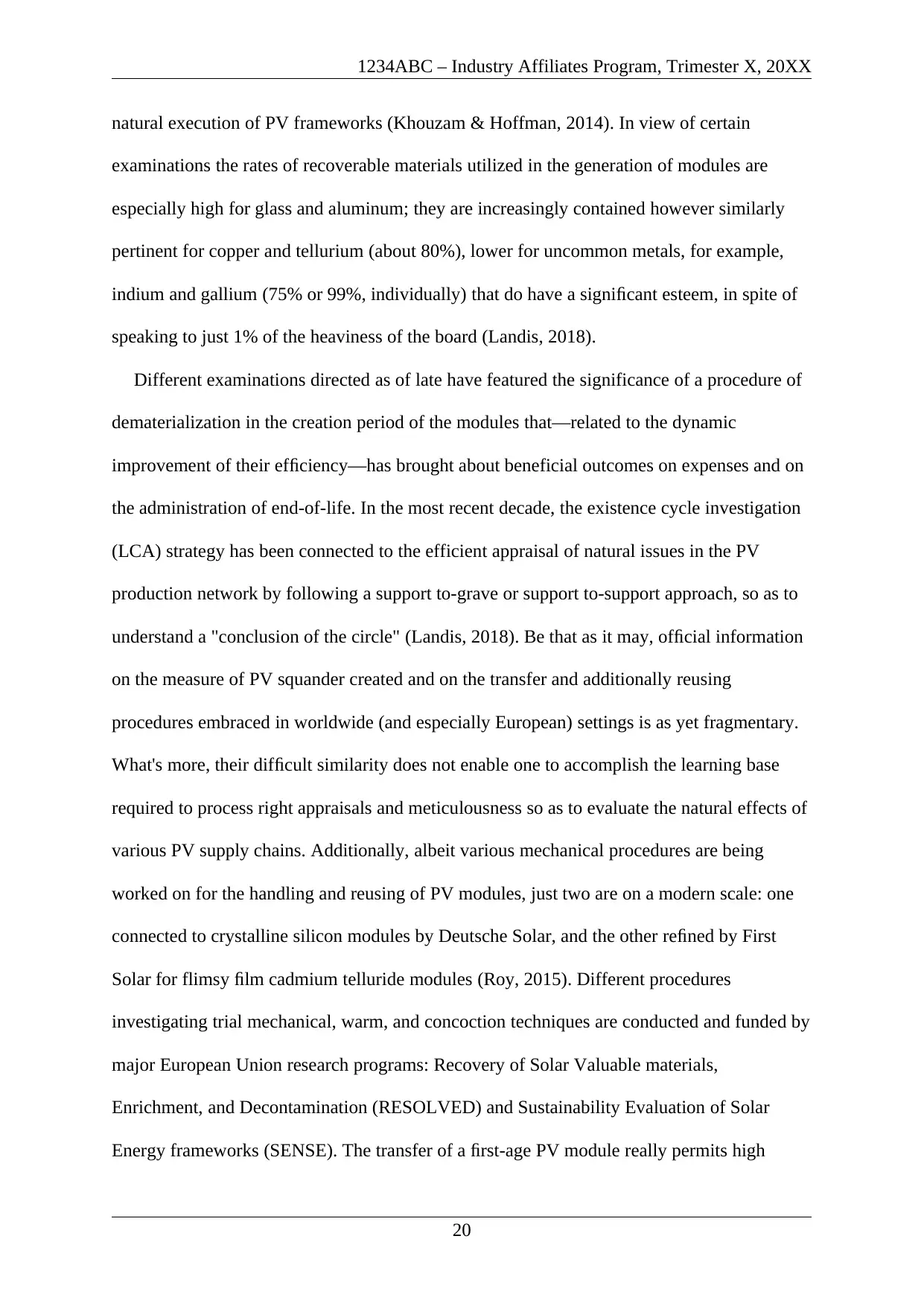
1234ABC – Industry Affiliates Program, Trimester X, 20XX
natural execution of PV frameworks (Khouzam & Hoffman, 2014). In view of certain
examinations the rates of recoverable materials utilized in the generation of modules are
especially high for glass and aluminum; they are increasingly contained however similarly
pertinent for copper and tellurium (about 80%), lower for uncommon metals, for example,
indium and gallium (75% or 99%, individually) that do have a significant esteem, in spite of
speaking to just 1% of the heaviness of the board (Landis, 2018).
Different examinations directed as of late have featured the significance of a procedure of
dematerialization in the creation period of the modules that—related to the dynamic
improvement of their efficiency—has brought about beneficial outcomes on expenses and on
the administration of end-of-life. In the most recent decade, the existence cycle investigation
(LCA) strategy has been connected to the efficient appraisal of natural issues in the PV
production network by following a support to-grave or support to-support approach, so as to
understand a "conclusion of the circle" (Landis, 2018). Be that as it may, official information
on the measure of PV squander created and on the transfer and additionally reusing
procedures embraced in worldwide (and especially European) settings is as yet fragmentary.
What's more, their difficult similarity does not enable one to accomplish the learning base
required to process right appraisals and meticulousness so as to evaluate the natural effects of
various PV supply chains. Additionally, albeit various mechanical procedures are being
worked on for the handling and reusing of PV modules, just two are on a modern scale: one
connected to crystalline silicon modules by Deutsche Solar, and the other refined by First
Solar for flimsy film cadmium telluride modules (Roy, 2015). Different procedures
investigating trial mechanical, warm, and concoction techniques are conducted and funded by
major European Union research programs: Recovery of Solar Valuable materials,
Enrichment, and Decontamination (RESOLVED) and Sustainability Evaluation of Solar
Energy frameworks (SENSE). The transfer of a first-age PV module really permits high
20
natural execution of PV frameworks (Khouzam & Hoffman, 2014). In view of certain
examinations the rates of recoverable materials utilized in the generation of modules are
especially high for glass and aluminum; they are increasingly contained however similarly
pertinent for copper and tellurium (about 80%), lower for uncommon metals, for example,
indium and gallium (75% or 99%, individually) that do have a significant esteem, in spite of
speaking to just 1% of the heaviness of the board (Landis, 2018).
Different examinations directed as of late have featured the significance of a procedure of
dematerialization in the creation period of the modules that—related to the dynamic
improvement of their efficiency—has brought about beneficial outcomes on expenses and on
the administration of end-of-life. In the most recent decade, the existence cycle investigation
(LCA) strategy has been connected to the efficient appraisal of natural issues in the PV
production network by following a support to-grave or support to-support approach, so as to
understand a "conclusion of the circle" (Landis, 2018). Be that as it may, official information
on the measure of PV squander created and on the transfer and additionally reusing
procedures embraced in worldwide (and especially European) settings is as yet fragmentary.
What's more, their difficult similarity does not enable one to accomplish the learning base
required to process right appraisals and meticulousness so as to evaluate the natural effects of
various PV supply chains. Additionally, albeit various mechanical procedures are being
worked on for the handling and reusing of PV modules, just two are on a modern scale: one
connected to crystalline silicon modules by Deutsche Solar, and the other refined by First
Solar for flimsy film cadmium telluride modules (Roy, 2015). Different procedures
investigating trial mechanical, warm, and concoction techniques are conducted and funded by
major European Union research programs: Recovery of Solar Valuable materials,
Enrichment, and Decontamination (RESOLVED) and Sustainability Evaluation of Solar
Energy frameworks (SENSE). The transfer of a first-age PV module really permits high
20
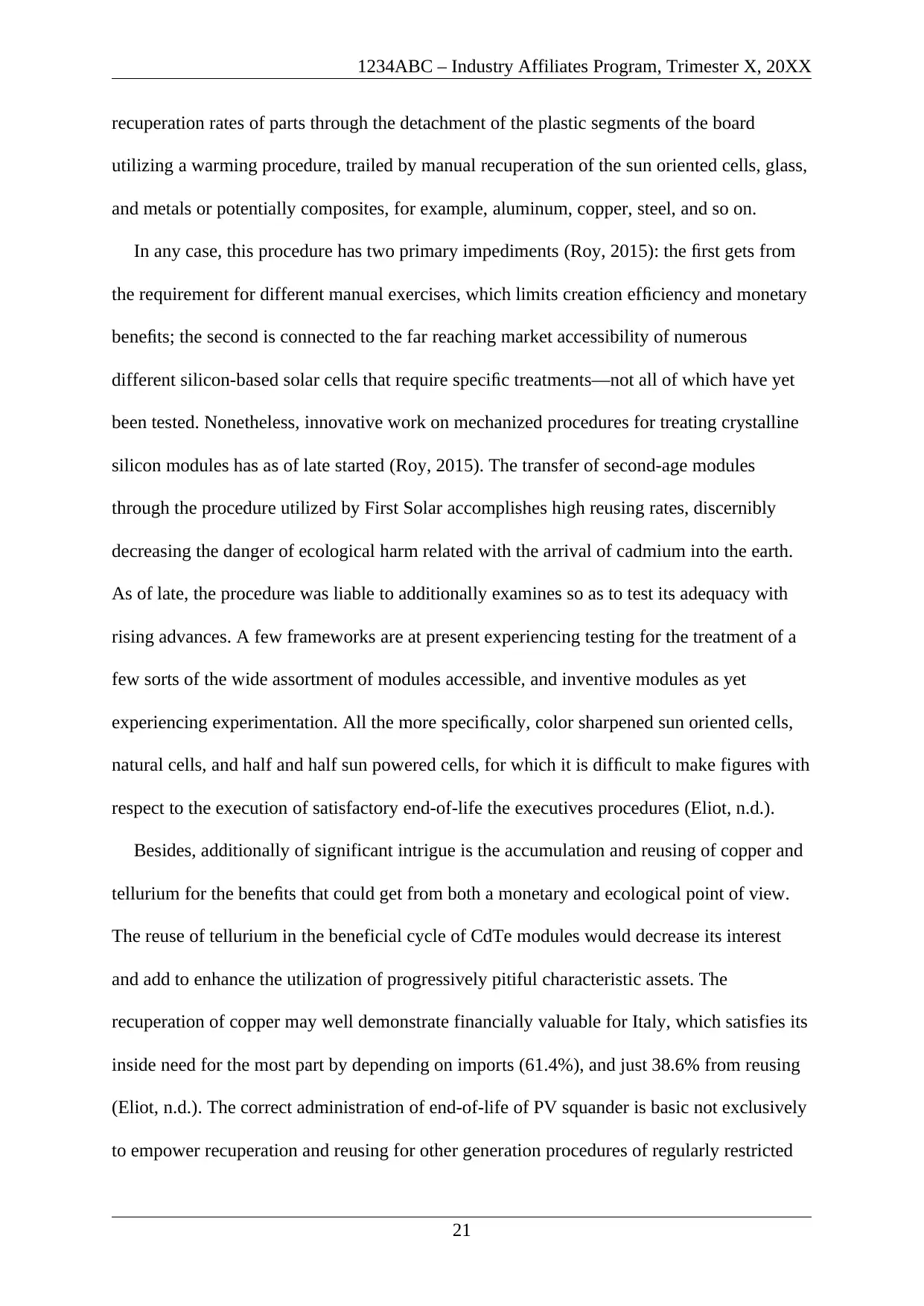
1234ABC – Industry Affiliates Program, Trimester X, 20XX
recuperation rates of parts through the detachment of the plastic segments of the board
utilizing a warming procedure, trailed by manual recuperation of the sun oriented cells, glass,
and metals or potentially composites, for example, aluminum, copper, steel, and so on.
In any case, this procedure has two primary impediments (Roy, 2015): the first gets from
the requirement for different manual exercises, which limits creation efficiency and monetary
benefits; the second is connected to the far reaching market accessibility of numerous
different silicon-based solar cells that require specific treatments—not all of which have yet
been tested. Nonetheless, innovative work on mechanized procedures for treating crystalline
silicon modules has as of late started (Roy, 2015). The transfer of second-age modules
through the procedure utilized by First Solar accomplishes high reusing rates, discernibly
decreasing the danger of ecological harm related with the arrival of cadmium into the earth.
As of late, the procedure was liable to additionally examines so as to test its adequacy with
rising advances. A few frameworks are at present experiencing testing for the treatment of a
few sorts of the wide assortment of modules accessible, and inventive modules as yet
experiencing experimentation. All the more specifically, color sharpened sun oriented cells,
natural cells, and half and half sun powered cells, for which it is difficult to make figures with
respect to the execution of satisfactory end-of-life the executives procedures (Eliot, n.d.).
Besides, additionally of significant intrigue is the accumulation and reusing of copper and
tellurium for the benefits that could get from both a monetary and ecological point of view.
The reuse of tellurium in the beneficial cycle of CdTe modules would decrease its interest
and add to enhance the utilization of progressively pitiful characteristic assets. The
recuperation of copper may well demonstrate financially valuable for Italy, which satisfies its
inside need for the most part by depending on imports (61.4%), and just 38.6% from reusing
(Eliot, n.d.). The correct administration of end-of-life of PV squander is basic not exclusively
to empower recuperation and reusing for other generation procedures of regularly restricted
21
recuperation rates of parts through the detachment of the plastic segments of the board
utilizing a warming procedure, trailed by manual recuperation of the sun oriented cells, glass,
and metals or potentially composites, for example, aluminum, copper, steel, and so on.
In any case, this procedure has two primary impediments (Roy, 2015): the first gets from
the requirement for different manual exercises, which limits creation efficiency and monetary
benefits; the second is connected to the far reaching market accessibility of numerous
different silicon-based solar cells that require specific treatments—not all of which have yet
been tested. Nonetheless, innovative work on mechanized procedures for treating crystalline
silicon modules has as of late started (Roy, 2015). The transfer of second-age modules
through the procedure utilized by First Solar accomplishes high reusing rates, discernibly
decreasing the danger of ecological harm related with the arrival of cadmium into the earth.
As of late, the procedure was liable to additionally examines so as to test its adequacy with
rising advances. A few frameworks are at present experiencing testing for the treatment of a
few sorts of the wide assortment of modules accessible, and inventive modules as yet
experiencing experimentation. All the more specifically, color sharpened sun oriented cells,
natural cells, and half and half sun powered cells, for which it is difficult to make figures with
respect to the execution of satisfactory end-of-life the executives procedures (Eliot, n.d.).
Besides, additionally of significant intrigue is the accumulation and reusing of copper and
tellurium for the benefits that could get from both a monetary and ecological point of view.
The reuse of tellurium in the beneficial cycle of CdTe modules would decrease its interest
and add to enhance the utilization of progressively pitiful characteristic assets. The
recuperation of copper may well demonstrate financially valuable for Italy, which satisfies its
inside need for the most part by depending on imports (61.4%), and just 38.6% from reusing
(Eliot, n.d.). The correct administration of end-of-life of PV squander is basic not exclusively
to empower recuperation and reusing for other generation procedures of regularly restricted
21
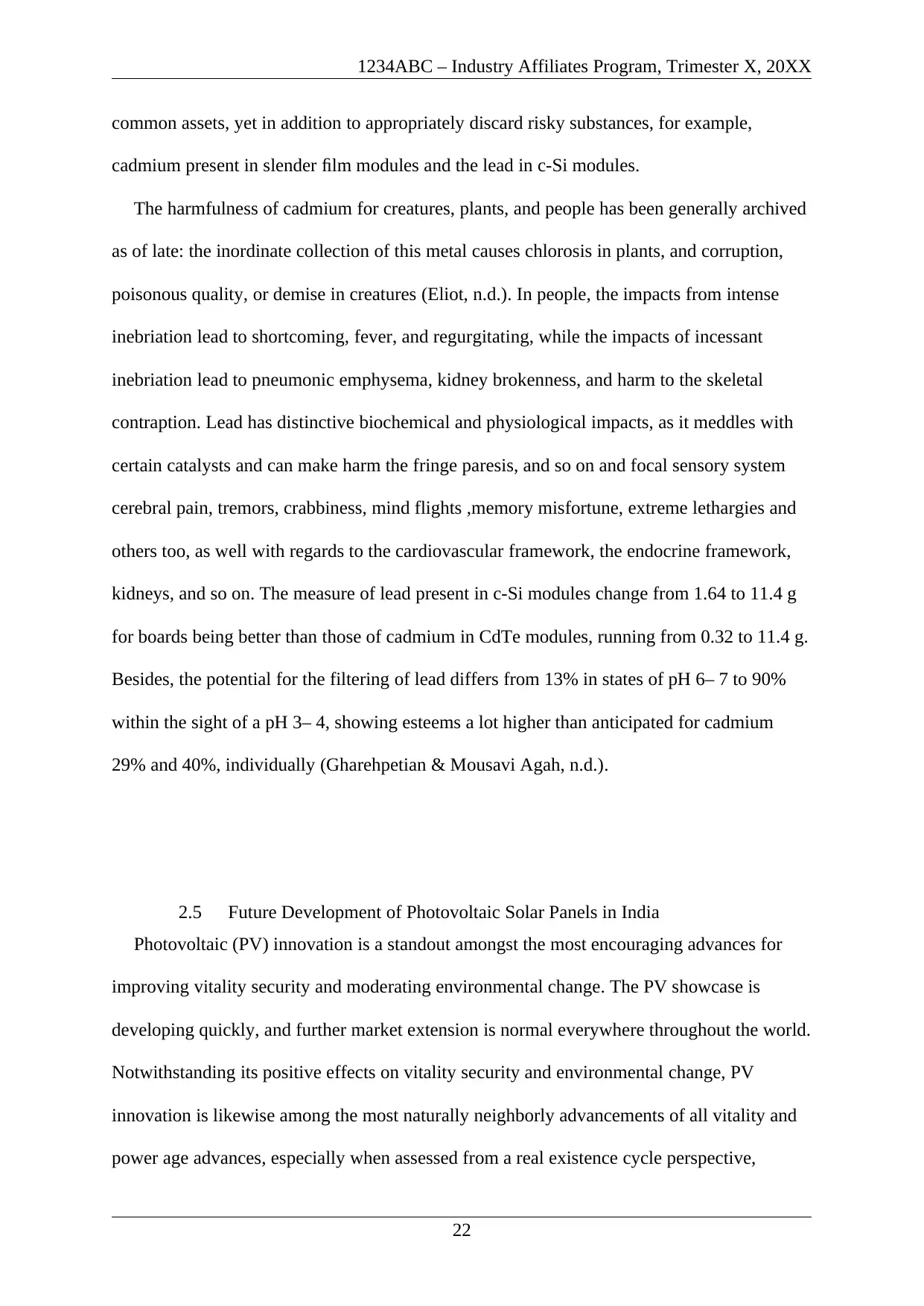
1234ABC – Industry Affiliates Program, Trimester X, 20XX
common assets, yet in addition to appropriately discard risky substances, for example,
cadmium present in slender film modules and the lead in c-Si modules.
The harmfulness of cadmium for creatures, plants, and people has been generally archived
as of late: the inordinate collection of this metal causes chlorosis in plants, and corruption,
poisonous quality, or demise in creatures (Eliot, n.d.). In people, the impacts from intense
inebriation lead to shortcoming, fever, and regurgitating, while the impacts of incessant
inebriation lead to pneumonic emphysema, kidney brokenness, and harm to the skeletal
contraption. Lead has distinctive biochemical and physiological impacts, as it meddles with
certain catalysts and can make harm the fringe paresis, and so on and focal sensory system
cerebral pain, tremors, crabbiness, mind flights ,memory misfortune, extreme lethargies and
others too, as well with regards to the cardiovascular framework, the endocrine framework,
kidneys, and so on. The measure of lead present in c-Si modules change from 1.64 to 11.4 g
for boards being better than those of cadmium in CdTe modules, running from 0.32 to 11.4 g.
Besides, the potential for the filtering of lead differs from 13% in states of pH 6– 7 to 90%
within the sight of a pH 3– 4, showing esteems a lot higher than anticipated for cadmium
29% and 40%, individually (Gharehpetian & Mousavi Agah, n.d.).
2.5 Future Development of Photovoltaic Solar Panels in India
Photovoltaic (PV) innovation is a standout amongst the most encouraging advances for
improving vitality security and moderating environmental change. The PV showcase is
developing quickly, and further market extension is normal everywhere throughout the world.
Notwithstanding its positive effects on vitality security and environmental change, PV
innovation is likewise among the most naturally neighborly advancements of all vitality and
power age advances, especially when assessed from a real existence cycle perspective,
22
common assets, yet in addition to appropriately discard risky substances, for example,
cadmium present in slender film modules and the lead in c-Si modules.
The harmfulness of cadmium for creatures, plants, and people has been generally archived
as of late: the inordinate collection of this metal causes chlorosis in plants, and corruption,
poisonous quality, or demise in creatures (Eliot, n.d.). In people, the impacts from intense
inebriation lead to shortcoming, fever, and regurgitating, while the impacts of incessant
inebriation lead to pneumonic emphysema, kidney brokenness, and harm to the skeletal
contraption. Lead has distinctive biochemical and physiological impacts, as it meddles with
certain catalysts and can make harm the fringe paresis, and so on and focal sensory system
cerebral pain, tremors, crabbiness, mind flights ,memory misfortune, extreme lethargies and
others too, as well with regards to the cardiovascular framework, the endocrine framework,
kidneys, and so on. The measure of lead present in c-Si modules change from 1.64 to 11.4 g
for boards being better than those of cadmium in CdTe modules, running from 0.32 to 11.4 g.
Besides, the potential for the filtering of lead differs from 13% in states of pH 6– 7 to 90%
within the sight of a pH 3– 4, showing esteems a lot higher than anticipated for cadmium
29% and 40%, individually (Gharehpetian & Mousavi Agah, n.d.).
2.5 Future Development of Photovoltaic Solar Panels in India
Photovoltaic (PV) innovation is a standout amongst the most encouraging advances for
improving vitality security and moderating environmental change. The PV showcase is
developing quickly, and further market extension is normal everywhere throughout the world.
Notwithstanding its positive effects on vitality security and environmental change, PV
innovation is likewise among the most naturally neighborly advancements of all vitality and
power age advances, especially when assessed from a real existence cycle perspective,
22
Secure Best Marks with AI Grader
Need help grading? Try our AI Grader for instant feedback on your assignments.
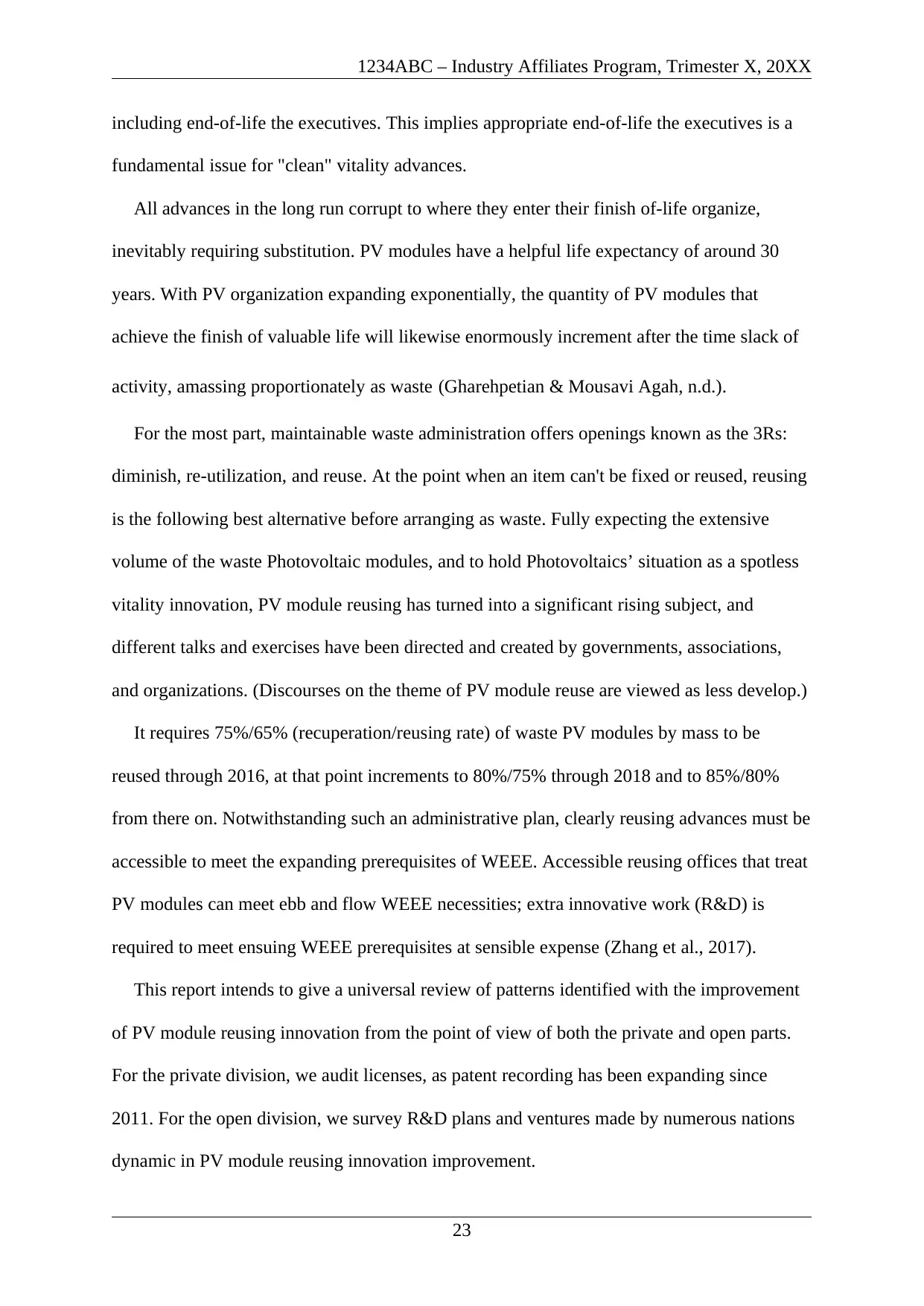
1234ABC – Industry Affiliates Program, Trimester X, 20XX
including end-of-life the executives. This implies appropriate end-of-life the executives is a
fundamental issue for "clean" vitality advances.
All advances in the long run corrupt to where they enter their finish of-life organize,
inevitably requiring substitution. PV modules have a helpful life expectancy of around 30
years. With PV organization expanding exponentially, the quantity of PV modules that
achieve the finish of valuable life will likewise enormously increment after the time slack of
activity, amassing proportionately as waste (Gharehpetian & Mousavi Agah, n.d.).
For the most part, maintainable waste administration offers openings known as the 3Rs:
diminish, re-utilization, and reuse. At the point when an item can't be fixed or reused, reusing
is the following best alternative before arranging as waste. Fully expecting the extensive
volume of the waste Photovoltaic modules, and to hold Photovoltaics’ situation as a spotless
vitality innovation, PV module reusing has turned into a significant rising subject, and
different talks and exercises have been directed and created by governments, associations,
and organizations. (Discourses on the theme of PV module reuse are viewed as less develop.)
It requires 75%/65% (recuperation/reusing rate) of waste PV modules by mass to be
reused through 2016, at that point increments to 80%/75% through 2018 and to 85%/80%
from there on. Notwithstanding such an administrative plan, clearly reusing advances must be
accessible to meet the expanding prerequisites of WEEE. Accessible reusing offices that treat
PV modules can meet ebb and flow WEEE necessities; extra innovative work (R&D) is
required to meet ensuing WEEE prerequisites at sensible expense (Zhang et al., 2017).
This report intends to give a universal review of patterns identified with the improvement
of PV module reusing innovation from the point of view of both the private and open parts.
For the private division, we audit licenses, as patent recording has been expanding since
2011. For the open division, we survey R&D plans and ventures made by numerous nations
dynamic in PV module reusing innovation improvement.
23
including end-of-life the executives. This implies appropriate end-of-life the executives is a
fundamental issue for "clean" vitality advances.
All advances in the long run corrupt to where they enter their finish of-life organize,
inevitably requiring substitution. PV modules have a helpful life expectancy of around 30
years. With PV organization expanding exponentially, the quantity of PV modules that
achieve the finish of valuable life will likewise enormously increment after the time slack of
activity, amassing proportionately as waste (Gharehpetian & Mousavi Agah, n.d.).
For the most part, maintainable waste administration offers openings known as the 3Rs:
diminish, re-utilization, and reuse. At the point when an item can't be fixed or reused, reusing
is the following best alternative before arranging as waste. Fully expecting the extensive
volume of the waste Photovoltaic modules, and to hold Photovoltaics’ situation as a spotless
vitality innovation, PV module reusing has turned into a significant rising subject, and
different talks and exercises have been directed and created by governments, associations,
and organizations. (Discourses on the theme of PV module reuse are viewed as less develop.)
It requires 75%/65% (recuperation/reusing rate) of waste PV modules by mass to be
reused through 2016, at that point increments to 80%/75% through 2018 and to 85%/80%
from there on. Notwithstanding such an administrative plan, clearly reusing advances must be
accessible to meet the expanding prerequisites of WEEE. Accessible reusing offices that treat
PV modules can meet ebb and flow WEEE necessities; extra innovative work (R&D) is
required to meet ensuing WEEE prerequisites at sensible expense (Zhang et al., 2017).
This report intends to give a universal review of patterns identified with the improvement
of PV module reusing innovation from the point of view of both the private and open parts.
For the private division, we audit licenses, as patent recording has been expanding since
2011. For the open division, we survey R&D plans and ventures made by numerous nations
dynamic in PV module reusing innovation improvement.
23
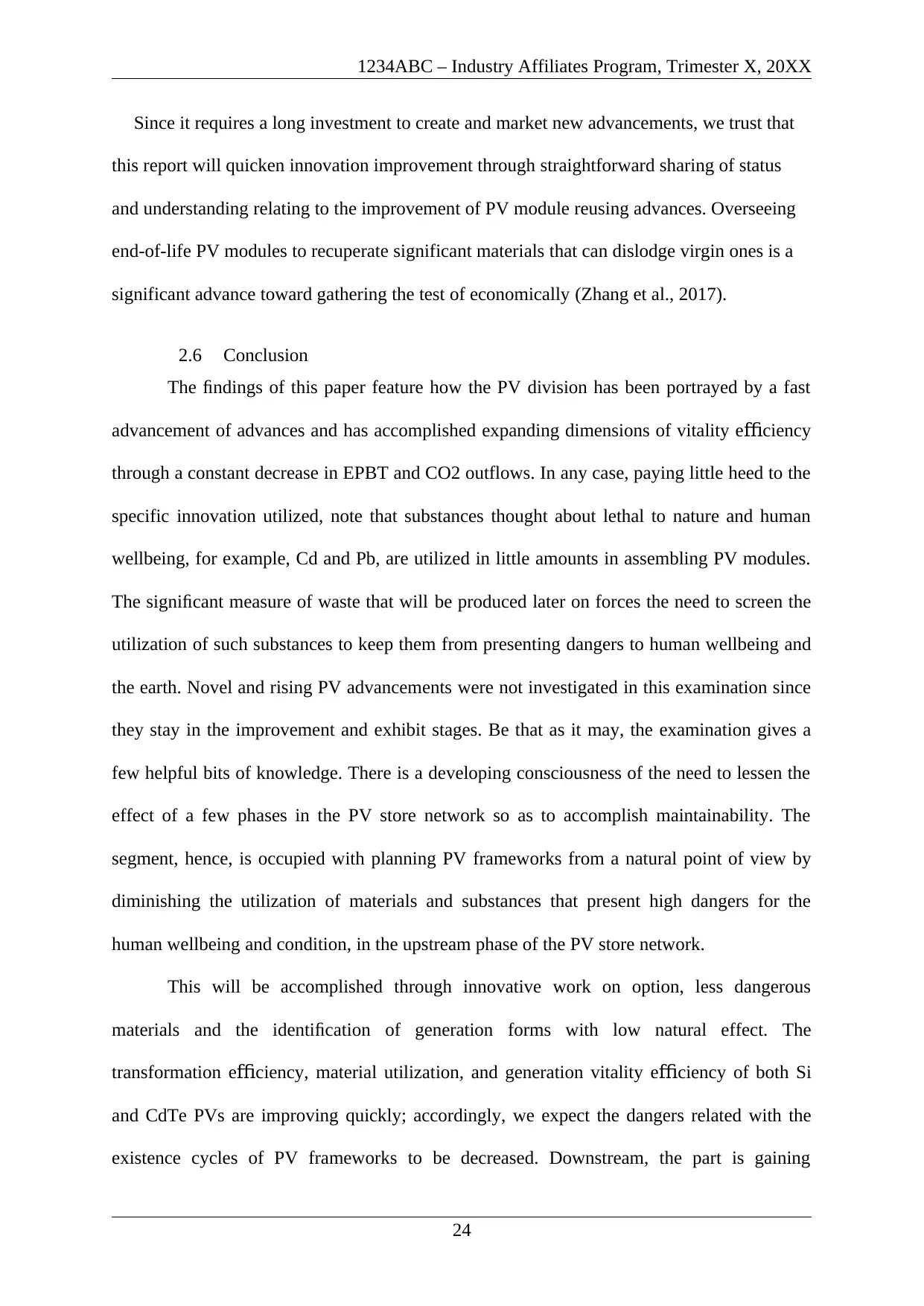
1234ABC – Industry Affiliates Program, Trimester X, 20XX
Since it requires a long investment to create and market new advancements, we trust that
this report will quicken innovation improvement through straightforward sharing of status
and understanding relating to the improvement of PV module reusing advances. Overseeing
end-of-life PV modules to recuperate significant materials that can dislodge virgin ones is a
significant advance toward gathering the test of economically (Zhang et al., 2017).
2.6 Conclusion
The findings of this paper feature how the PV division has been portrayed by a fast
advancement of advances and has accomplished expanding dimensions of vitality e ciencyffi
through a constant decrease in EPBT and CO2 outflows. In any case, paying little heed to the
specific innovation utilized, note that substances thought about lethal to nature and human
wellbeing, for example, Cd and Pb, are utilized in little amounts in assembling PV modules.
The significant measure of waste that will be produced later on forces the need to screen the
utilization of such substances to keep them from presenting dangers to human wellbeing and
the earth. Novel and rising PV advancements were not investigated in this examination since
they stay in the improvement and exhibit stages. Be that as it may, the examination gives a
few helpful bits of knowledge. There is a developing consciousness of the need to lessen the
effect of a few phases in the PV store network so as to accomplish maintainability. The
segment, hence, is occupied with planning PV frameworks from a natural point of view by
diminishing the utilization of materials and substances that present high dangers for the
human wellbeing and condition, in the upstream phase of the PV store network.
This will be accomplished through innovative work on option, less dangerous
materials and the identification of generation forms with low natural effect. The
transformation e ciency, material utilization, and generation vitality e ciency of both Siffi ffi
and CdTe PVs are improving quickly; accordingly, we expect the dangers related with the
existence cycles of PV frameworks to be decreased. Downstream, the part is gaining
24
Since it requires a long investment to create and market new advancements, we trust that
this report will quicken innovation improvement through straightforward sharing of status
and understanding relating to the improvement of PV module reusing advances. Overseeing
end-of-life PV modules to recuperate significant materials that can dislodge virgin ones is a
significant advance toward gathering the test of economically (Zhang et al., 2017).
2.6 Conclusion
The findings of this paper feature how the PV division has been portrayed by a fast
advancement of advances and has accomplished expanding dimensions of vitality e ciencyffi
through a constant decrease in EPBT and CO2 outflows. In any case, paying little heed to the
specific innovation utilized, note that substances thought about lethal to nature and human
wellbeing, for example, Cd and Pb, are utilized in little amounts in assembling PV modules.
The significant measure of waste that will be produced later on forces the need to screen the
utilization of such substances to keep them from presenting dangers to human wellbeing and
the earth. Novel and rising PV advancements were not investigated in this examination since
they stay in the improvement and exhibit stages. Be that as it may, the examination gives a
few helpful bits of knowledge. There is a developing consciousness of the need to lessen the
effect of a few phases in the PV store network so as to accomplish maintainability. The
segment, hence, is occupied with planning PV frameworks from a natural point of view by
diminishing the utilization of materials and substances that present high dangers for the
human wellbeing and condition, in the upstream phase of the PV store network.
This will be accomplished through innovative work on option, less dangerous
materials and the identification of generation forms with low natural effect. The
transformation e ciency, material utilization, and generation vitality e ciency of both Siffi ffi
and CdTe PVs are improving quickly; accordingly, we expect the dangers related with the
existence cycles of PV frameworks to be decreased. Downstream, the part is gaining
24
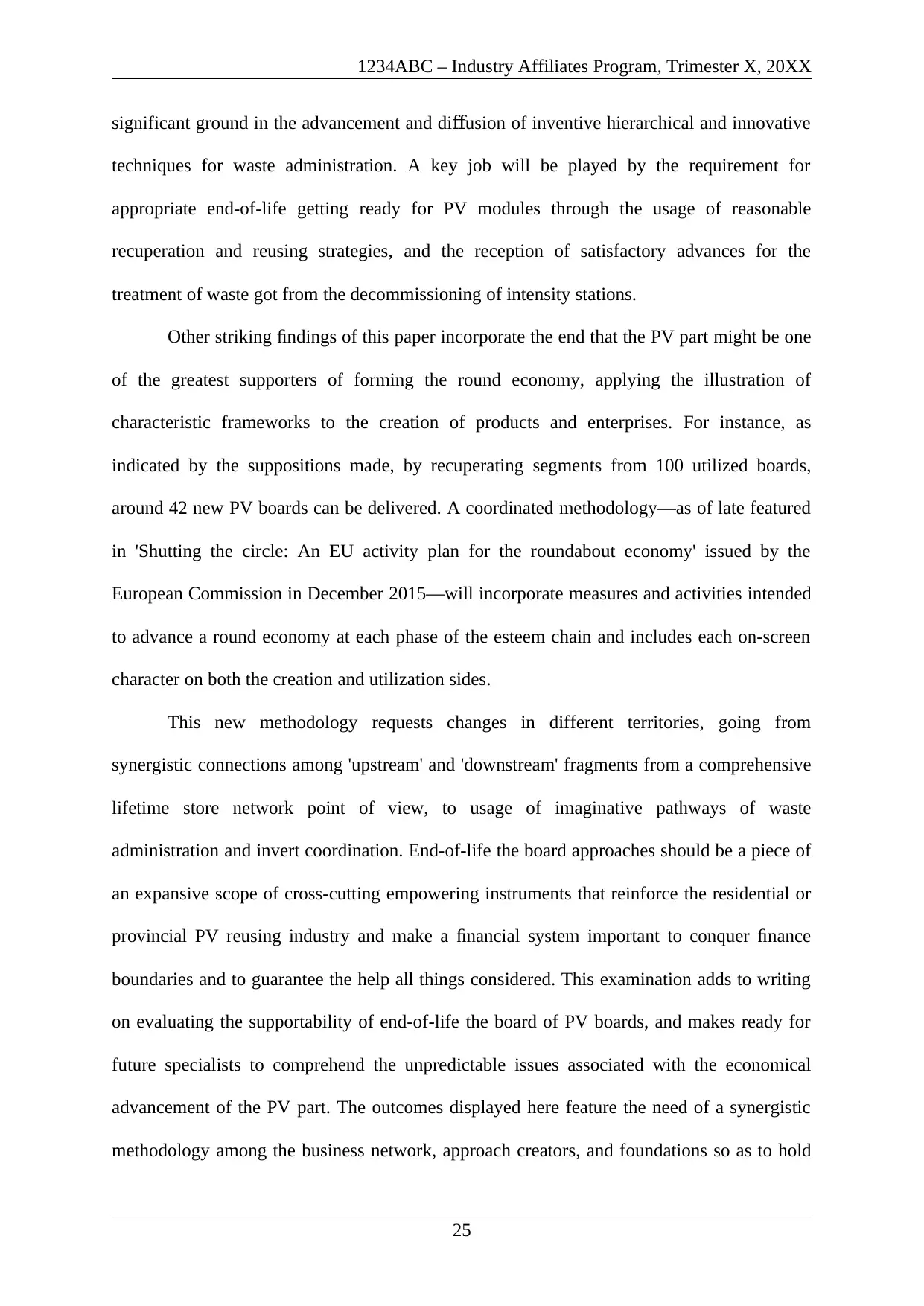
1234ABC – Industry Affiliates Program, Trimester X, 20XX
significant ground in the advancement and di usion of inventive hierarchical and innovativeff
techniques for waste administration. A key job will be played by the requirement for
appropriate end-of-life getting ready for PV modules through the usage of reasonable
recuperation and reusing strategies, and the reception of satisfactory advances for the
treatment of waste got from the decommissioning of intensity stations.
Other striking findings of this paper incorporate the end that the PV part might be one
of the greatest supporters of forming the round economy, applying the illustration of
characteristic frameworks to the creation of products and enterprises. For instance, as
indicated by the suppositions made, by recuperating segments from 100 utilized boards,
around 42 new PV boards can be delivered. A coordinated methodology—as of late featured
in 'Shutting the circle: An EU activity plan for the roundabout economy' issued by the
European Commission in December 2015—will incorporate measures and activities intended
to advance a round economy at each phase of the esteem chain and includes each on-screen
character on both the creation and utilization sides.
This new methodology requests changes in different territories, going from
synergistic connections among 'upstream' and 'downstream' fragments from a comprehensive
lifetime store network point of view, to usage of imaginative pathways of waste
administration and invert coordination. End-of-life the board approaches should be a piece of
an expansive scope of cross-cutting empowering instruments that reinforce the residential or
provincial PV reusing industry and make a financial system important to conquer finance
boundaries and to guarantee the help all things considered. This examination adds to writing
on evaluating the supportability of end-of-life the board of PV boards, and makes ready for
future specialists to comprehend the unpredictable issues associated with the economical
advancement of the PV part. The outcomes displayed here feature the need of a synergistic
methodology among the business network, approach creators, and foundations so as to hold
25
significant ground in the advancement and di usion of inventive hierarchical and innovativeff
techniques for waste administration. A key job will be played by the requirement for
appropriate end-of-life getting ready for PV modules through the usage of reasonable
recuperation and reusing strategies, and the reception of satisfactory advances for the
treatment of waste got from the decommissioning of intensity stations.
Other striking findings of this paper incorporate the end that the PV part might be one
of the greatest supporters of forming the round economy, applying the illustration of
characteristic frameworks to the creation of products and enterprises. For instance, as
indicated by the suppositions made, by recuperating segments from 100 utilized boards,
around 42 new PV boards can be delivered. A coordinated methodology—as of late featured
in 'Shutting the circle: An EU activity plan for the roundabout economy' issued by the
European Commission in December 2015—will incorporate measures and activities intended
to advance a round economy at each phase of the esteem chain and includes each on-screen
character on both the creation and utilization sides.
This new methodology requests changes in different territories, going from
synergistic connections among 'upstream' and 'downstream' fragments from a comprehensive
lifetime store network point of view, to usage of imaginative pathways of waste
administration and invert coordination. End-of-life the board approaches should be a piece of
an expansive scope of cross-cutting empowering instruments that reinforce the residential or
provincial PV reusing industry and make a financial system important to conquer finance
boundaries and to guarantee the help all things considered. This examination adds to writing
on evaluating the supportability of end-of-life the board of PV boards, and makes ready for
future specialists to comprehend the unpredictable issues associated with the economical
advancement of the PV part. The outcomes displayed here feature the need of a synergistic
methodology among the business network, approach creators, and foundations so as to hold
25
Paraphrase This Document
Need a fresh take? Get an instant paraphrase of this document with our AI Paraphraser
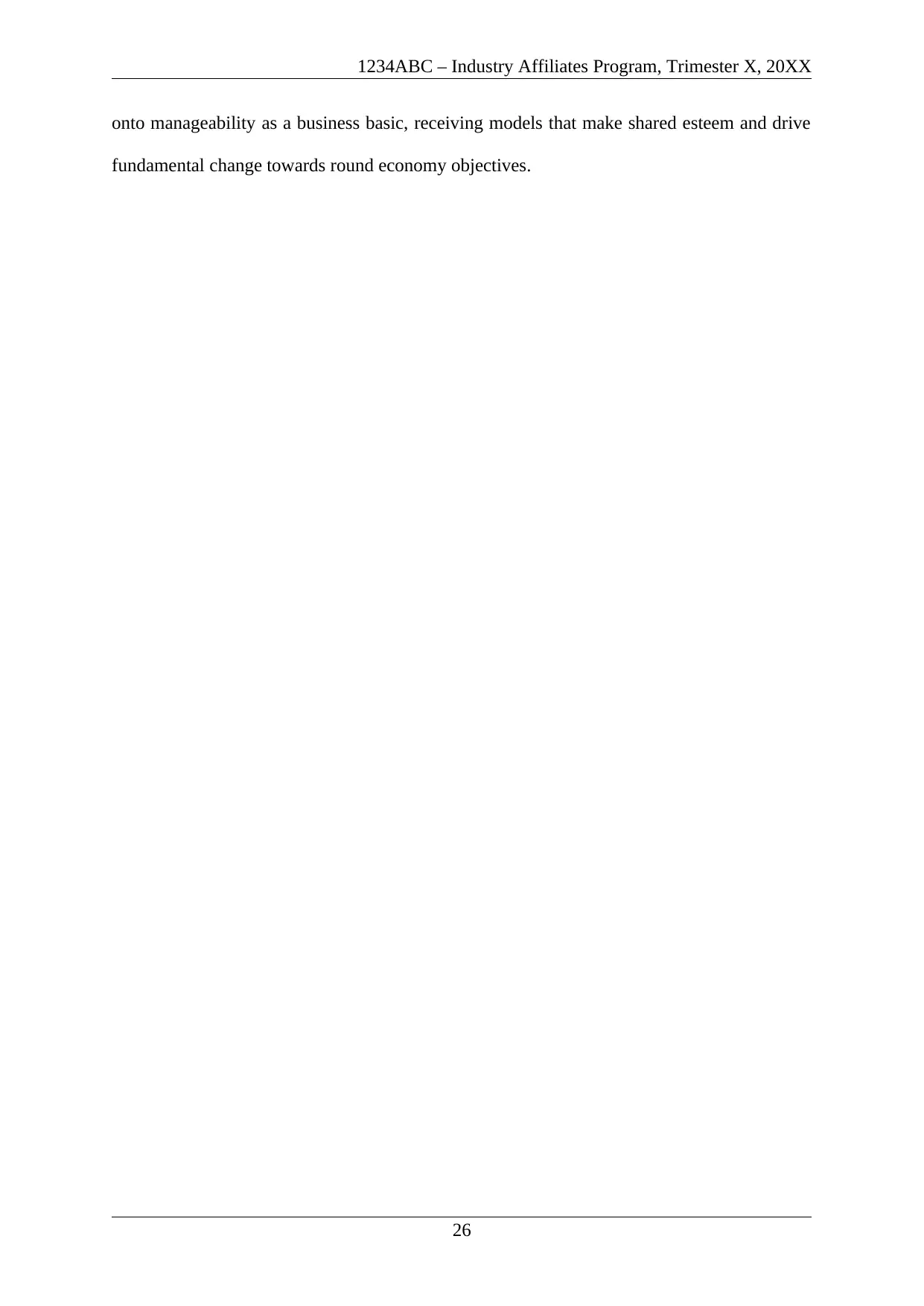
1234ABC – Industry Affiliates Program, Trimester X, 20XX
onto manageability as a business basic, receiving models that make shared esteem and drive
fundamental change towards round economy objectives.
26
onto manageability as a business basic, receiving models that make shared esteem and drive
fundamental change towards round economy objectives.
26
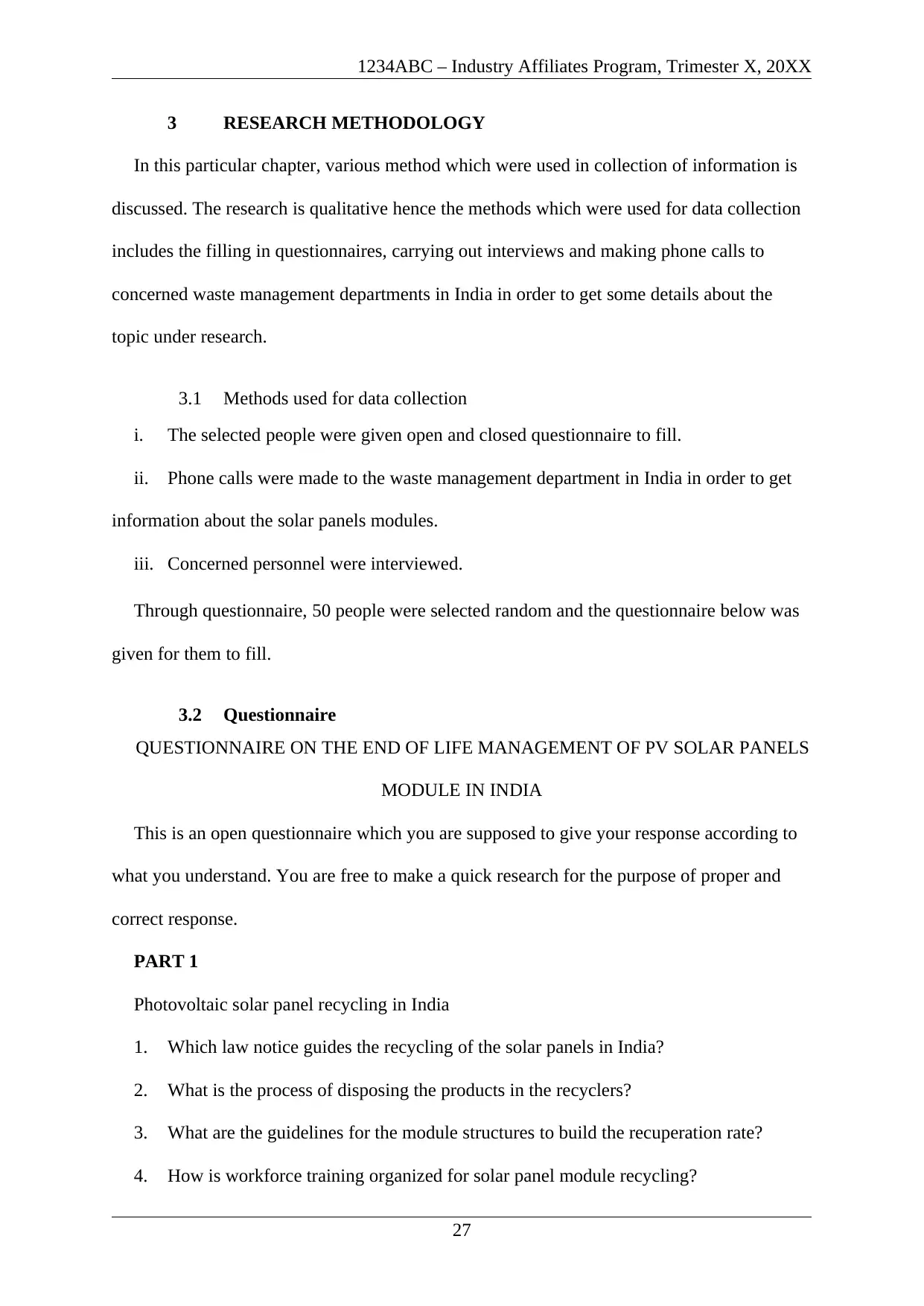
1234ABC – Industry Affiliates Program, Trimester X, 20XX
3 RESEARCH METHODOLOGY
In this particular chapter, various method which were used in collection of information is
discussed. The research is qualitative hence the methods which were used for data collection
includes the filling in questionnaires, carrying out interviews and making phone calls to
concerned waste management departments in India in order to get some details about the
topic under research.
3.1 Methods used for data collection
i. The selected people were given open and closed questionnaire to fill.
ii. Phone calls were made to the waste management department in India in order to get
information about the solar panels modules.
iii. Concerned personnel were interviewed.
Through questionnaire, 50 people were selected random and the questionnaire below was
given for them to fill.
3.2 Questionnaire
QUESTIONNAIRE ON THE END OF LIFE MANAGEMENT OF PV SOLAR PANELS
MODULE IN INDIA
This is an open questionnaire which you are supposed to give your response according to
what you understand. You are free to make a quick research for the purpose of proper and
correct response.
PART 1
Photovoltaic solar panel recycling in India
1. Which law notice guides the recycling of the solar panels in India?
2. What is the process of disposing the products in the recyclers?
3. What are the guidelines for the module structures to build the recuperation rate?
4. How is workforce training organized for solar panel module recycling?
27
3 RESEARCH METHODOLOGY
In this particular chapter, various method which were used in collection of information is
discussed. The research is qualitative hence the methods which were used for data collection
includes the filling in questionnaires, carrying out interviews and making phone calls to
concerned waste management departments in India in order to get some details about the
topic under research.
3.1 Methods used for data collection
i. The selected people were given open and closed questionnaire to fill.
ii. Phone calls were made to the waste management department in India in order to get
information about the solar panels modules.
iii. Concerned personnel were interviewed.
Through questionnaire, 50 people were selected random and the questionnaire below was
given for them to fill.
3.2 Questionnaire
QUESTIONNAIRE ON THE END OF LIFE MANAGEMENT OF PV SOLAR PANELS
MODULE IN INDIA
This is an open questionnaire which you are supposed to give your response according to
what you understand. You are free to make a quick research for the purpose of proper and
correct response.
PART 1
Photovoltaic solar panel recycling in India
1. Which law notice guides the recycling of the solar panels in India?
2. What is the process of disposing the products in the recyclers?
3. What are the guidelines for the module structures to build the recuperation rate?
4. How is workforce training organized for solar panel module recycling?
27
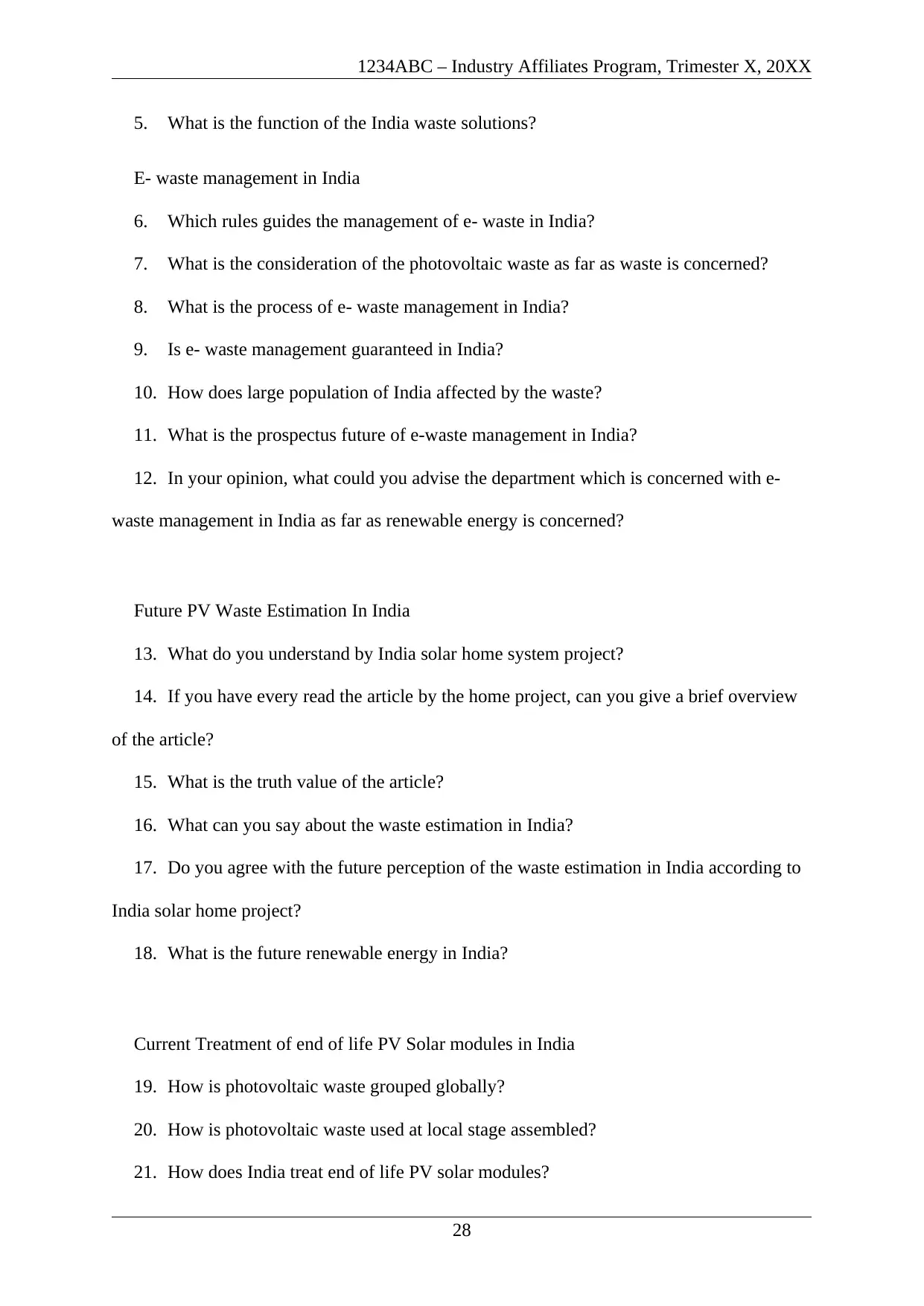
1234ABC – Industry Affiliates Program, Trimester X, 20XX
5. What is the function of the India waste solutions?
E- waste management in India
6. Which rules guides the management of e- waste in India?
7. What is the consideration of the photovoltaic waste as far as waste is concerned?
8. What is the process of e- waste management in India?
9. Is e- waste management guaranteed in India?
10. How does large population of India affected by the waste?
11. What is the prospectus future of e-waste management in India?
12. In your opinion, what could you advise the department which is concerned with e-
waste management in India as far as renewable energy is concerned?
Future PV Waste Estimation In India
13. What do you understand by India solar home system project?
14. If you have every read the article by the home project, can you give a brief overview
of the article?
15. What is the truth value of the article?
16. What can you say about the waste estimation in India?
17. Do you agree with the future perception of the waste estimation in India according to
India solar home project?
18. What is the future renewable energy in India?
Current Treatment of end of life PV Solar modules in India
19. How is photovoltaic waste grouped globally?
20. How is photovoltaic waste used at local stage assembled?
21. How does India treat end of life PV solar modules?
28
5. What is the function of the India waste solutions?
E- waste management in India
6. Which rules guides the management of e- waste in India?
7. What is the consideration of the photovoltaic waste as far as waste is concerned?
8. What is the process of e- waste management in India?
9. Is e- waste management guaranteed in India?
10. How does large population of India affected by the waste?
11. What is the prospectus future of e-waste management in India?
12. In your opinion, what could you advise the department which is concerned with e-
waste management in India as far as renewable energy is concerned?
Future PV Waste Estimation In India
13. What do you understand by India solar home system project?
14. If you have every read the article by the home project, can you give a brief overview
of the article?
15. What is the truth value of the article?
16. What can you say about the waste estimation in India?
17. Do you agree with the future perception of the waste estimation in India according to
India solar home project?
18. What is the future renewable energy in India?
Current Treatment of end of life PV Solar modules in India
19. How is photovoltaic waste grouped globally?
20. How is photovoltaic waste used at local stage assembled?
21. How does India treat end of life PV solar modules?
28
Secure Best Marks with AI Grader
Need help grading? Try our AI Grader for instant feedback on your assignments.
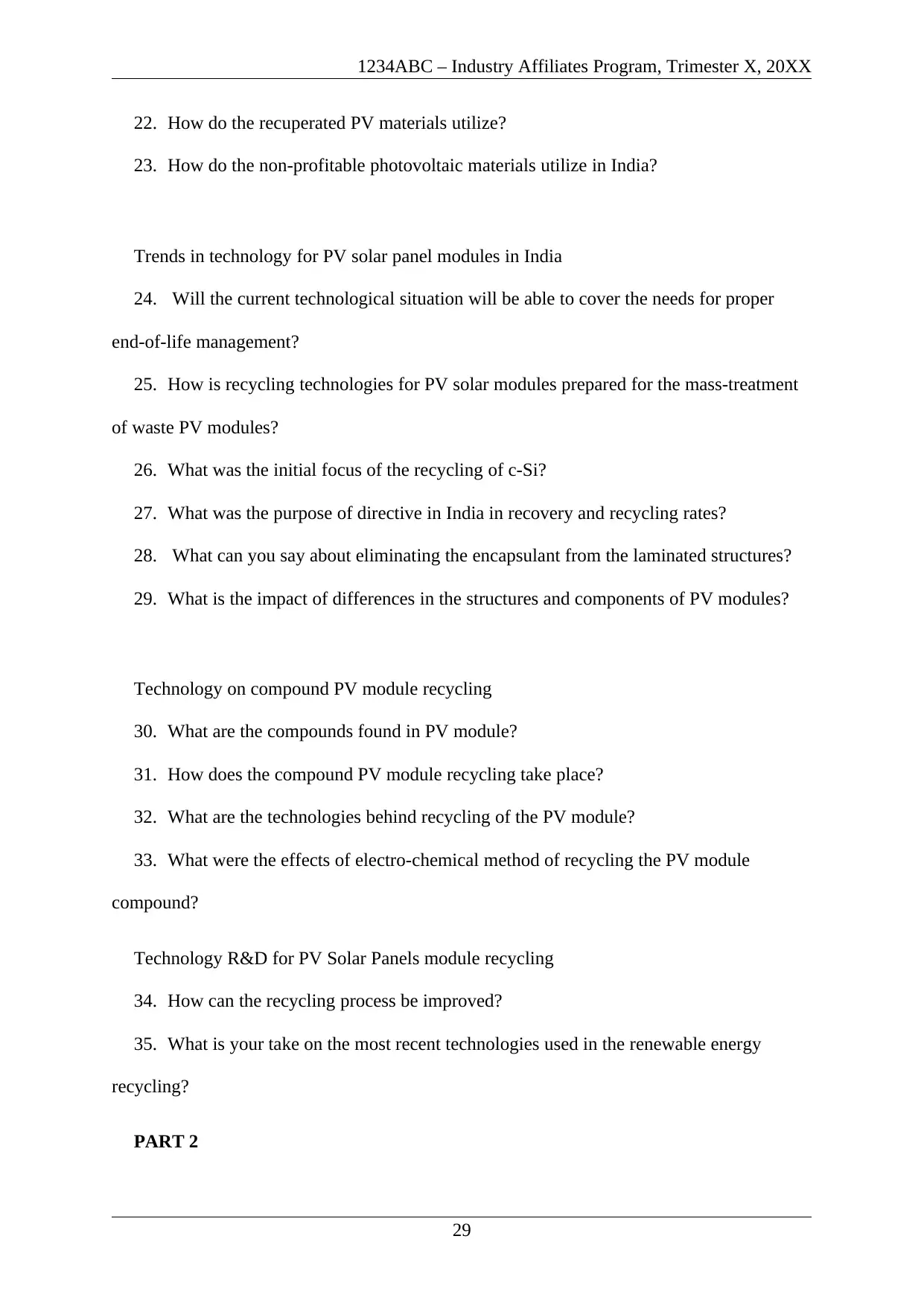
1234ABC – Industry Affiliates Program, Trimester X, 20XX
22. How do the recuperated PV materials utilize?
23. How do the non-profitable photovoltaic materials utilize in India?
Trends in technology for PV solar panel modules in India
24. Will the current technological situation will be able to cover the needs for proper
end-of-life management?
25. How is recycling technologies for PV solar modules prepared for the mass-treatment
of waste PV modules?
26. What was the initial focus of the recycling of c-Si?
27. What was the purpose of directive in India in recovery and recycling rates?
28. What can you say about eliminating the encapsulant from the laminated structures?
29. What is the impact of differences in the structures and components of PV modules?
Technology on compound PV module recycling
30. What are the compounds found in PV module?
31. How does the compound PV module recycling take place?
32. What are the technologies behind recycling of the PV module?
33. What were the effects of electro-chemical method of recycling the PV module
compound?
Technology R&D for PV Solar Panels module recycling
34. How can the recycling process be improved?
35. What is your take on the most recent technologies used in the renewable energy
recycling?
PART 2
29
22. How do the recuperated PV materials utilize?
23. How do the non-profitable photovoltaic materials utilize in India?
Trends in technology for PV solar panel modules in India
24. Will the current technological situation will be able to cover the needs for proper
end-of-life management?
25. How is recycling technologies for PV solar modules prepared for the mass-treatment
of waste PV modules?
26. What was the initial focus of the recycling of c-Si?
27. What was the purpose of directive in India in recovery and recycling rates?
28. What can you say about eliminating the encapsulant from the laminated structures?
29. What is the impact of differences in the structures and components of PV modules?
Technology on compound PV module recycling
30. What are the compounds found in PV module?
31. How does the compound PV module recycling take place?
32. What are the technologies behind recycling of the PV module?
33. What were the effects of electro-chemical method of recycling the PV module
compound?
Technology R&D for PV Solar Panels module recycling
34. How can the recycling process be improved?
35. What is your take on the most recent technologies used in the renewable energy
recycling?
PART 2
29
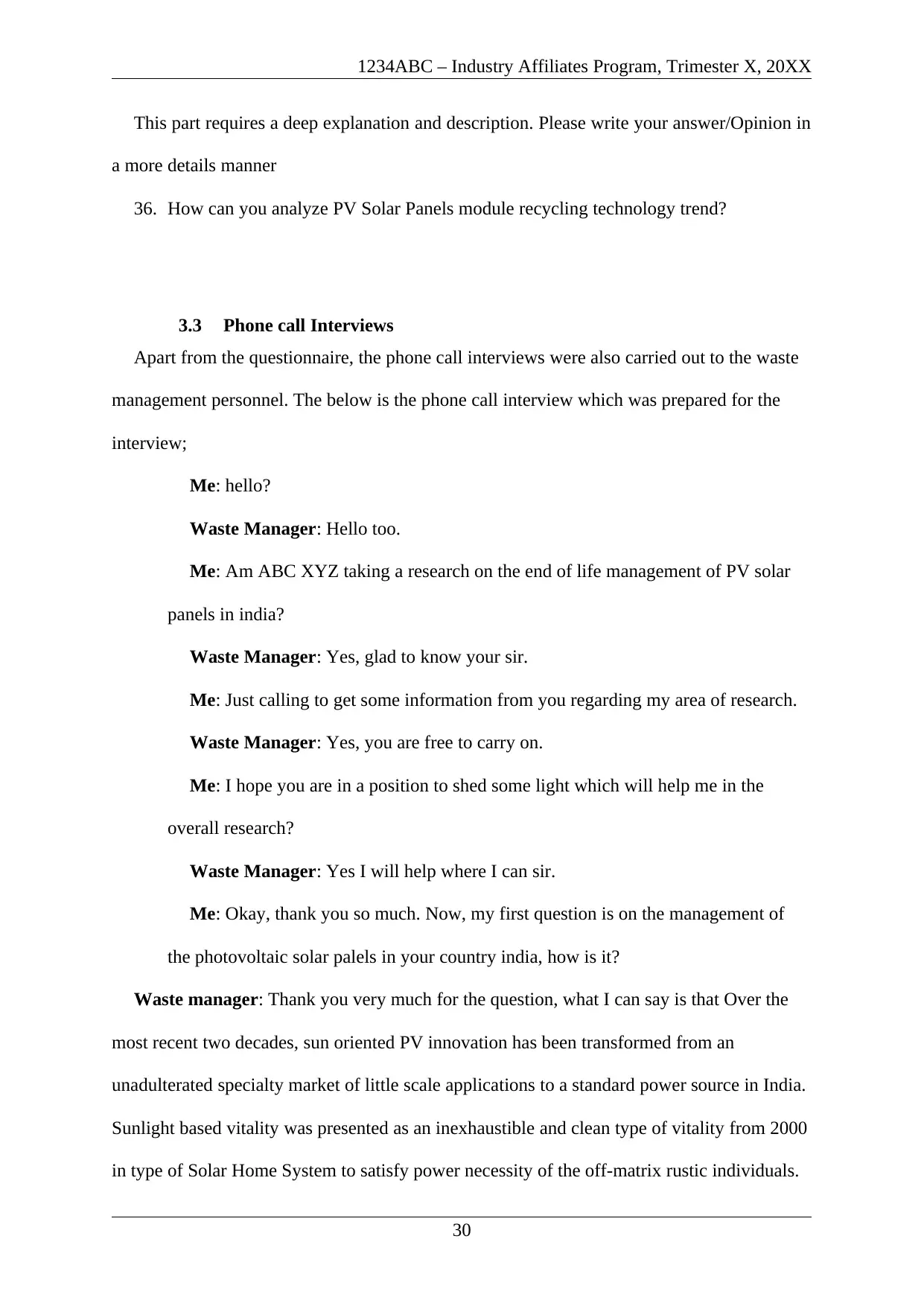
1234ABC – Industry Affiliates Program, Trimester X, 20XX
This part requires a deep explanation and description. Please write your answer/Opinion in
a more details manner
36. How can you analyze PV Solar Panels module recycling technology trend?
3.3 Phone call Interviews
Apart from the questionnaire, the phone call interviews were also carried out to the waste
management personnel. The below is the phone call interview which was prepared for the
interview;
Me: hello?
Waste Manager: Hello too.
Me: Am ABC XYZ taking a research on the end of life management of PV solar
panels in india?
Waste Manager: Yes, glad to know your sir.
Me: Just calling to get some information from you regarding my area of research.
Waste Manager: Yes, you are free to carry on.
Me: I hope you are in a position to shed some light which will help me in the
overall research?
Waste Manager: Yes I will help where I can sir.
Me: Okay, thank you so much. Now, my first question is on the management of
the photovoltaic solar palels in your country india, how is it?
Waste manager: Thank you very much for the question, what I can say is that Over the
most recent two decades, sun oriented PV innovation has been transformed from an
unadulterated specialty market of little scale applications to a standard power source in India.
Sunlight based vitality was presented as an inexhaustible and clean type of vitality from 2000
in type of Solar Home System to satisfy power necessity of the off-matrix rustic individuals.
30
This part requires a deep explanation and description. Please write your answer/Opinion in
a more details manner
36. How can you analyze PV Solar Panels module recycling technology trend?
3.3 Phone call Interviews
Apart from the questionnaire, the phone call interviews were also carried out to the waste
management personnel. The below is the phone call interview which was prepared for the
interview;
Me: hello?
Waste Manager: Hello too.
Me: Am ABC XYZ taking a research on the end of life management of PV solar
panels in india?
Waste Manager: Yes, glad to know your sir.
Me: Just calling to get some information from you regarding my area of research.
Waste Manager: Yes, you are free to carry on.
Me: I hope you are in a position to shed some light which will help me in the
overall research?
Waste Manager: Yes I will help where I can sir.
Me: Okay, thank you so much. Now, my first question is on the management of
the photovoltaic solar palels in your country india, how is it?
Waste manager: Thank you very much for the question, what I can say is that Over the
most recent two decades, sun oriented PV innovation has been transformed from an
unadulterated specialty market of little scale applications to a standard power source in India.
Sunlight based vitality was presented as an inexhaustible and clean type of vitality from 2000
in type of Solar Home System to satisfy power necessity of the off-matrix rustic individuals.
30
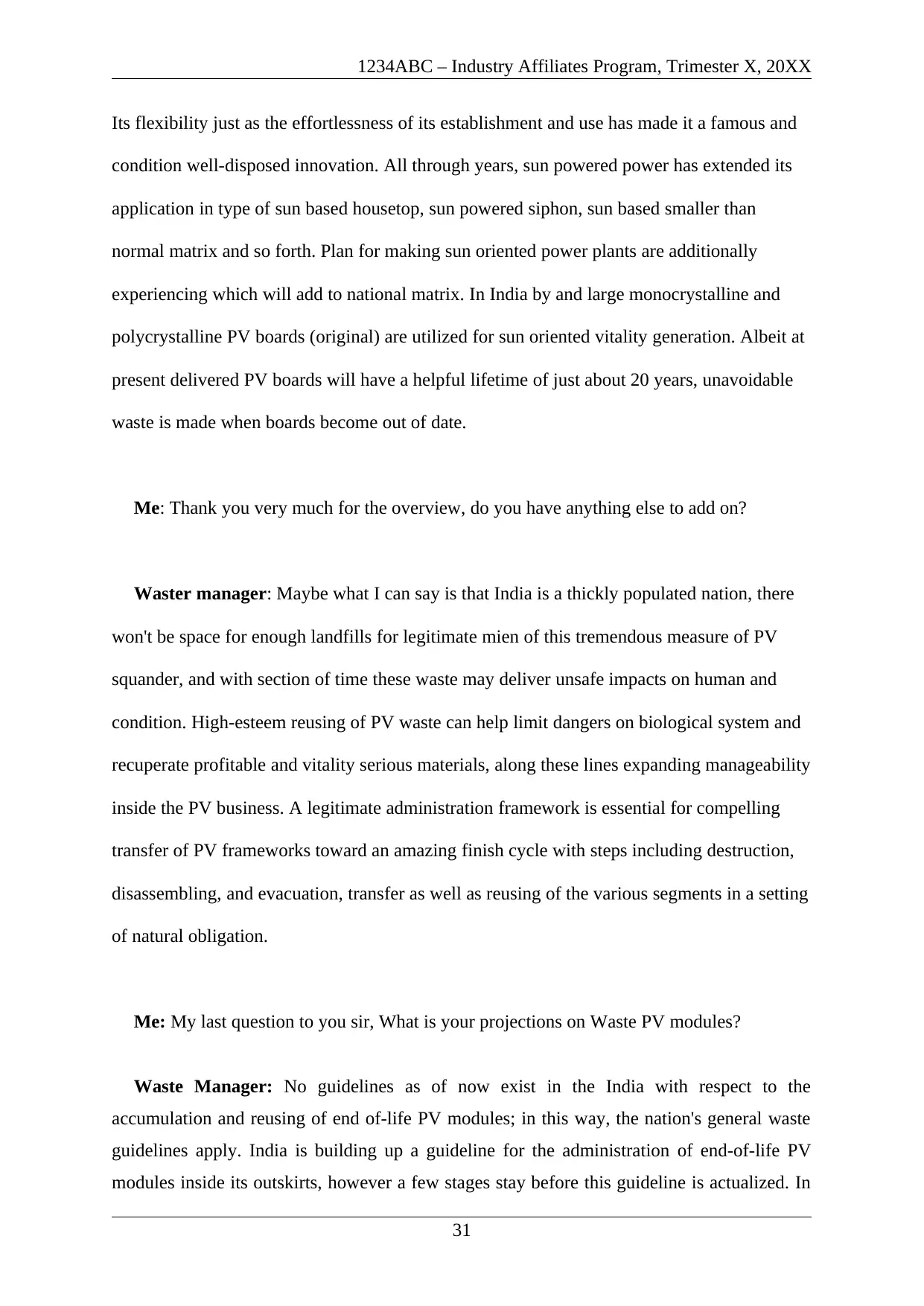
1234ABC – Industry Affiliates Program, Trimester X, 20XX
Its flexibility just as the effortlessness of its establishment and use has made it a famous and
condition well-disposed innovation. All through years, sun powered power has extended its
application in type of sun based housetop, sun powered siphon, sun based smaller than
normal matrix and so forth. Plan for making sun oriented power plants are additionally
experiencing which will add to national matrix. In India by and large monocrystalline and
polycrystalline PV boards (original) are utilized for sun oriented vitality generation. Albeit at
present delivered PV boards will have a helpful lifetime of just about 20 years, unavoidable
waste is made when boards become out of date.
Me: Thank you very much for the overview, do you have anything else to add on?
Waster manager: Maybe what I can say is that India is a thickly populated nation, there
won't be space for enough landfills for legitimate mien of this tremendous measure of PV
squander, and with section of time these waste may deliver unsafe impacts on human and
condition. High-esteem reusing of PV waste can help limit dangers on biological system and
recuperate profitable and vitality serious materials, along these lines expanding manageability
inside the PV business. A legitimate administration framework is essential for compelling
transfer of PV frameworks toward an amazing finish cycle with steps including destruction,
disassembling, and evacuation, transfer as well as reusing of the various segments in a setting
of natural obligation.
Me: My last question to you sir, What is your projections on Waste PV modules?
Waste Manager: No guidelines as of now exist in the India with respect to the
accumulation and reusing of end of-life PV modules; in this way, the nation's general waste
guidelines apply. India is building up a guideline for the administration of end-of-life PV
modules inside its outskirts, however a few stages stay before this guideline is actualized. In
31
Its flexibility just as the effortlessness of its establishment and use has made it a famous and
condition well-disposed innovation. All through years, sun powered power has extended its
application in type of sun based housetop, sun powered siphon, sun based smaller than
normal matrix and so forth. Plan for making sun oriented power plants are additionally
experiencing which will add to national matrix. In India by and large monocrystalline and
polycrystalline PV boards (original) are utilized for sun oriented vitality generation. Albeit at
present delivered PV boards will have a helpful lifetime of just about 20 years, unavoidable
waste is made when boards become out of date.
Me: Thank you very much for the overview, do you have anything else to add on?
Waster manager: Maybe what I can say is that India is a thickly populated nation, there
won't be space for enough landfills for legitimate mien of this tremendous measure of PV
squander, and with section of time these waste may deliver unsafe impacts on human and
condition. High-esteem reusing of PV waste can help limit dangers on biological system and
recuperate profitable and vitality serious materials, along these lines expanding manageability
inside the PV business. A legitimate administration framework is essential for compelling
transfer of PV frameworks toward an amazing finish cycle with steps including destruction,
disassembling, and evacuation, transfer as well as reusing of the various segments in a setting
of natural obligation.
Me: My last question to you sir, What is your projections on Waste PV modules?
Waste Manager: No guidelines as of now exist in the India with respect to the
accumulation and reusing of end of-life PV modules; in this way, the nation's general waste
guidelines apply. India is building up a guideline for the administration of end-of-life PV
modules inside its outskirts, however a few stages stay before this guideline is actualized. In
31
Paraphrase This Document
Need a fresh take? Get an instant paraphrase of this document with our AI Paraphraser
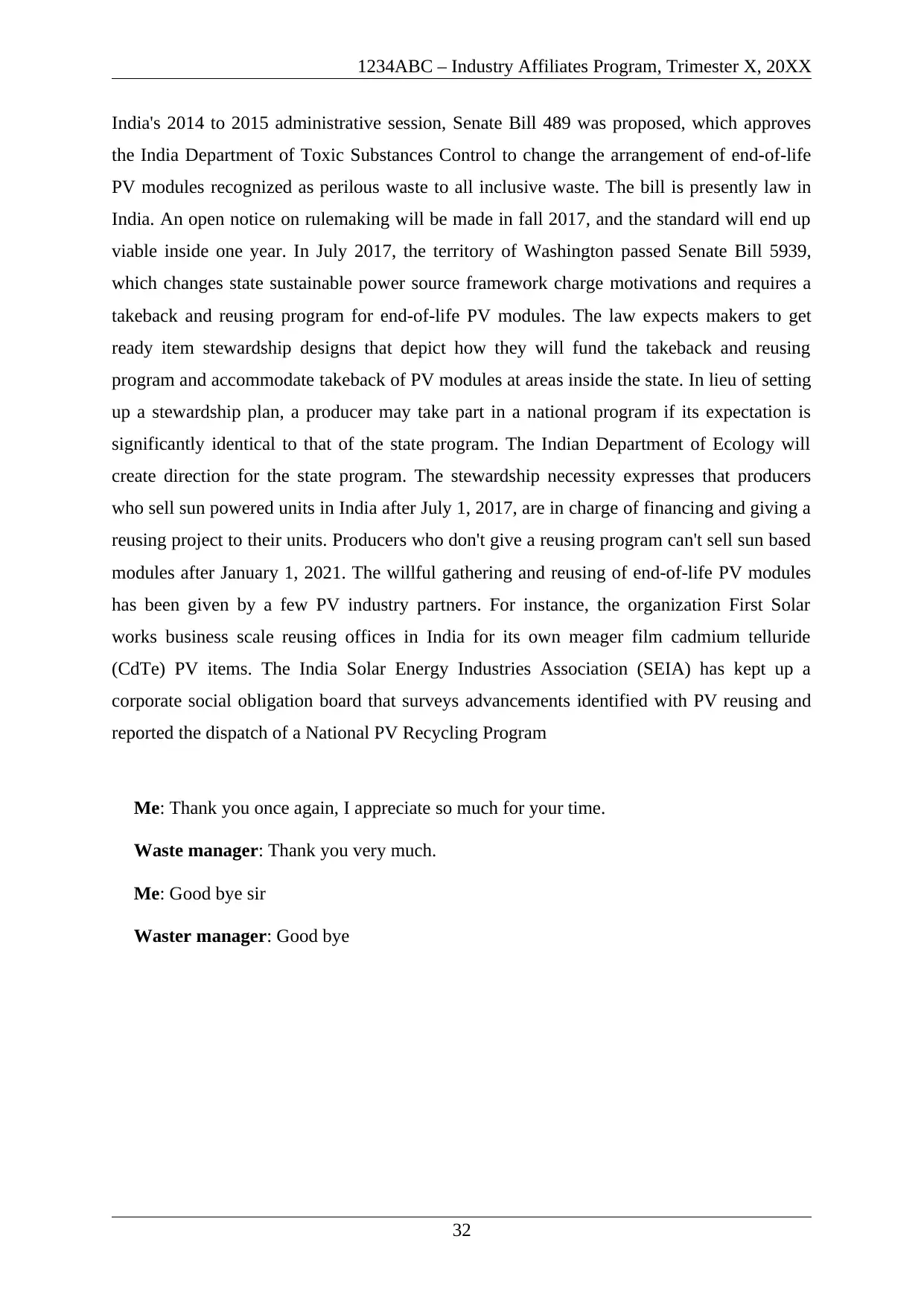
1234ABC – Industry Affiliates Program, Trimester X, 20XX
India's 2014 to 2015 administrative session, Senate Bill 489 was proposed, which approves
the India Department of Toxic Substances Control to change the arrangement of end-of-life
PV modules recognized as perilous waste to all inclusive waste. The bill is presently law in
India. An open notice on rulemaking will be made in fall 2017, and the standard will end up
viable inside one year. In July 2017, the territory of Washington passed Senate Bill 5939,
which changes state sustainable power source framework charge motivations and requires a
takeback and reusing program for end-of-life PV modules. The law expects makers to get
ready item stewardship designs that depict how they will fund the takeback and reusing
program and accommodate takeback of PV modules at areas inside the state. In lieu of setting
up a stewardship plan, a producer may take part in a national program if its expectation is
significantly identical to that of the state program. The Indian Department of Ecology will
create direction for the state program. The stewardship necessity expresses that producers
who sell sun powered units in India after July 1, 2017, are in charge of financing and giving a
reusing project to their units. Producers who don't give a reusing program can't sell sun based
modules after January 1, 2021. The willful gathering and reusing of end-of-life PV modules
has been given by a few PV industry partners. For instance, the organization First Solar
works business scale reusing offices in India for its own meager film cadmium telluride
(CdTe) PV items. The India Solar Energy Industries Association (SEIA) has kept up a
corporate social obligation board that surveys advancements identified with PV reusing and
reported the dispatch of a National PV Recycling Program
Me: Thank you once again, I appreciate so much for your time.
Waste manager: Thank you very much.
Me: Good bye sir
Waster manager: Good bye
32
India's 2014 to 2015 administrative session, Senate Bill 489 was proposed, which approves
the India Department of Toxic Substances Control to change the arrangement of end-of-life
PV modules recognized as perilous waste to all inclusive waste. The bill is presently law in
India. An open notice on rulemaking will be made in fall 2017, and the standard will end up
viable inside one year. In July 2017, the territory of Washington passed Senate Bill 5939,
which changes state sustainable power source framework charge motivations and requires a
takeback and reusing program for end-of-life PV modules. The law expects makers to get
ready item stewardship designs that depict how they will fund the takeback and reusing
program and accommodate takeback of PV modules at areas inside the state. In lieu of setting
up a stewardship plan, a producer may take part in a national program if its expectation is
significantly identical to that of the state program. The Indian Department of Ecology will
create direction for the state program. The stewardship necessity expresses that producers
who sell sun powered units in India after July 1, 2017, are in charge of financing and giving a
reusing project to their units. Producers who don't give a reusing program can't sell sun based
modules after January 1, 2021. The willful gathering and reusing of end-of-life PV modules
has been given by a few PV industry partners. For instance, the organization First Solar
works business scale reusing offices in India for its own meager film cadmium telluride
(CdTe) PV items. The India Solar Energy Industries Association (SEIA) has kept up a
corporate social obligation board that surveys advancements identified with PV reusing and
reported the dispatch of a National PV Recycling Program
Me: Thank you once again, I appreciate so much for your time.
Waste manager: Thank you very much.
Me: Good bye sir
Waster manager: Good bye
32
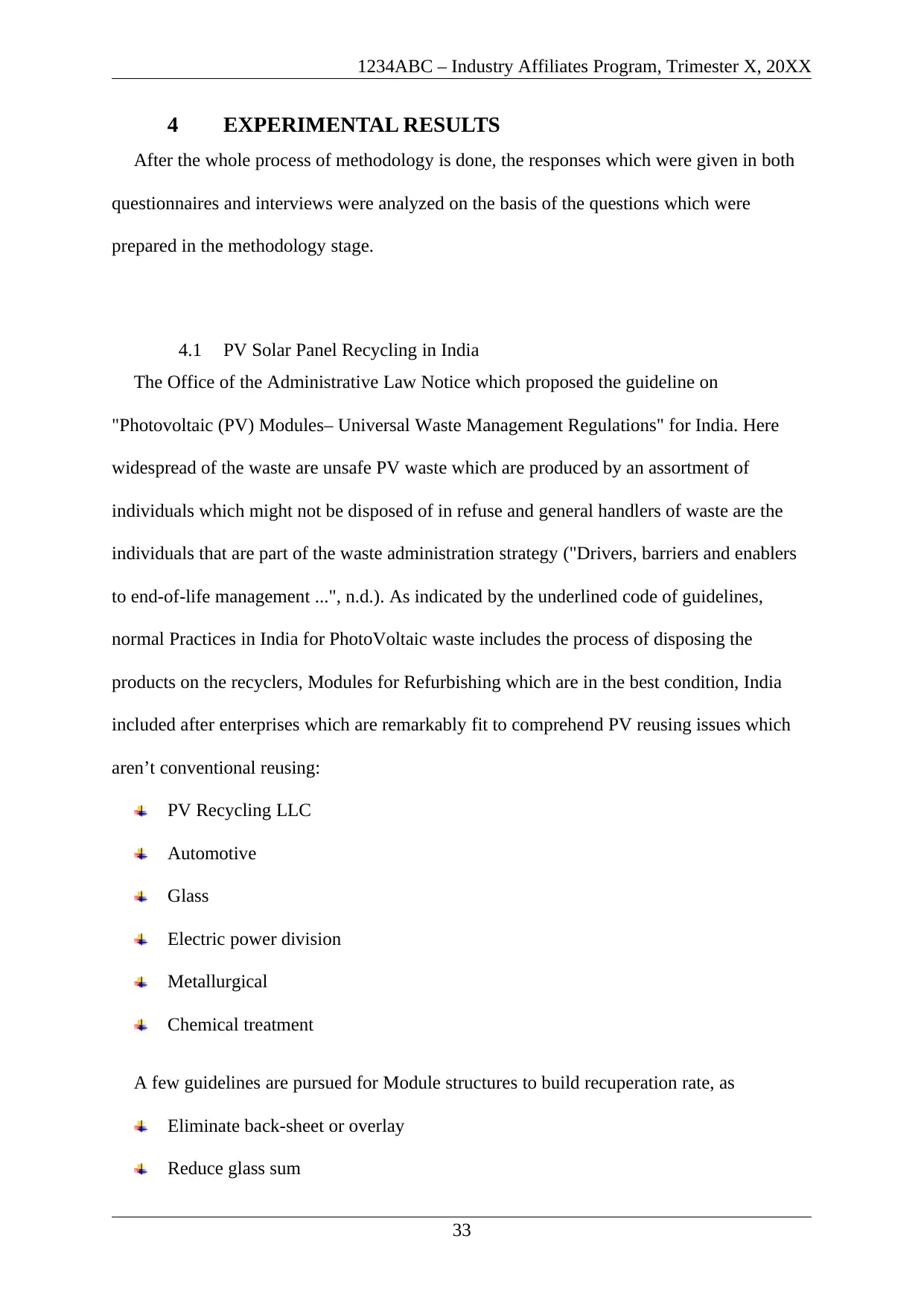
1234ABC – Industry Affiliates Program, Trimester X, 20XX
4 EXPERIMENTAL RESULTS
After the whole process of methodology is done, the responses which were given in both
questionnaires and interviews were analyzed on the basis of the questions which were
prepared in the methodology stage.
4.1 PV Solar Panel Recycling in India
The Office of the Administrative Law Notice which proposed the guideline on
"Photovoltaic (PV) Modules– Universal Waste Management Regulations" for India. Here
widespread of the waste are unsafe PV waste which are produced by an assortment of
individuals which might not be disposed of in refuse and general handlers of waste are the
individuals that are part of the waste administration strategy ("Drivers, barriers and enablers
to end-of-life management ...", n.d.). As indicated by the underlined code of guidelines,
normal Practices in India for PhotoVoltaic waste includes the process of disposing the
products on the recyclers, Modules for Refurbishing which are in the best condition, India
included after enterprises which are remarkably fit to comprehend PV reusing issues which
aren’t conventional reusing:
PV Recycling LLC
Automotive
Glass
Electric power division
Metallurgical
Chemical treatment
A few guidelines are pursued for Module structures to build recuperation rate, as
Eliminate back-sheet or overlay
Reduce glass sum
33
4 EXPERIMENTAL RESULTS
After the whole process of methodology is done, the responses which were given in both
questionnaires and interviews were analyzed on the basis of the questions which were
prepared in the methodology stage.
4.1 PV Solar Panel Recycling in India
The Office of the Administrative Law Notice which proposed the guideline on
"Photovoltaic (PV) Modules– Universal Waste Management Regulations" for India. Here
widespread of the waste are unsafe PV waste which are produced by an assortment of
individuals which might not be disposed of in refuse and general handlers of waste are the
individuals that are part of the waste administration strategy ("Drivers, barriers and enablers
to end-of-life management ...", n.d.). As indicated by the underlined code of guidelines,
normal Practices in India for PhotoVoltaic waste includes the process of disposing the
products on the recyclers, Modules for Refurbishing which are in the best condition, India
included after enterprises which are remarkably fit to comprehend PV reusing issues which
aren’t conventional reusing:
PV Recycling LLC
Automotive
Glass
Electric power division
Metallurgical
Chemical treatment
A few guidelines are pursued for Module structures to build recuperation rate, as
Eliminate back-sheet or overlay
Reduce glass sum
33
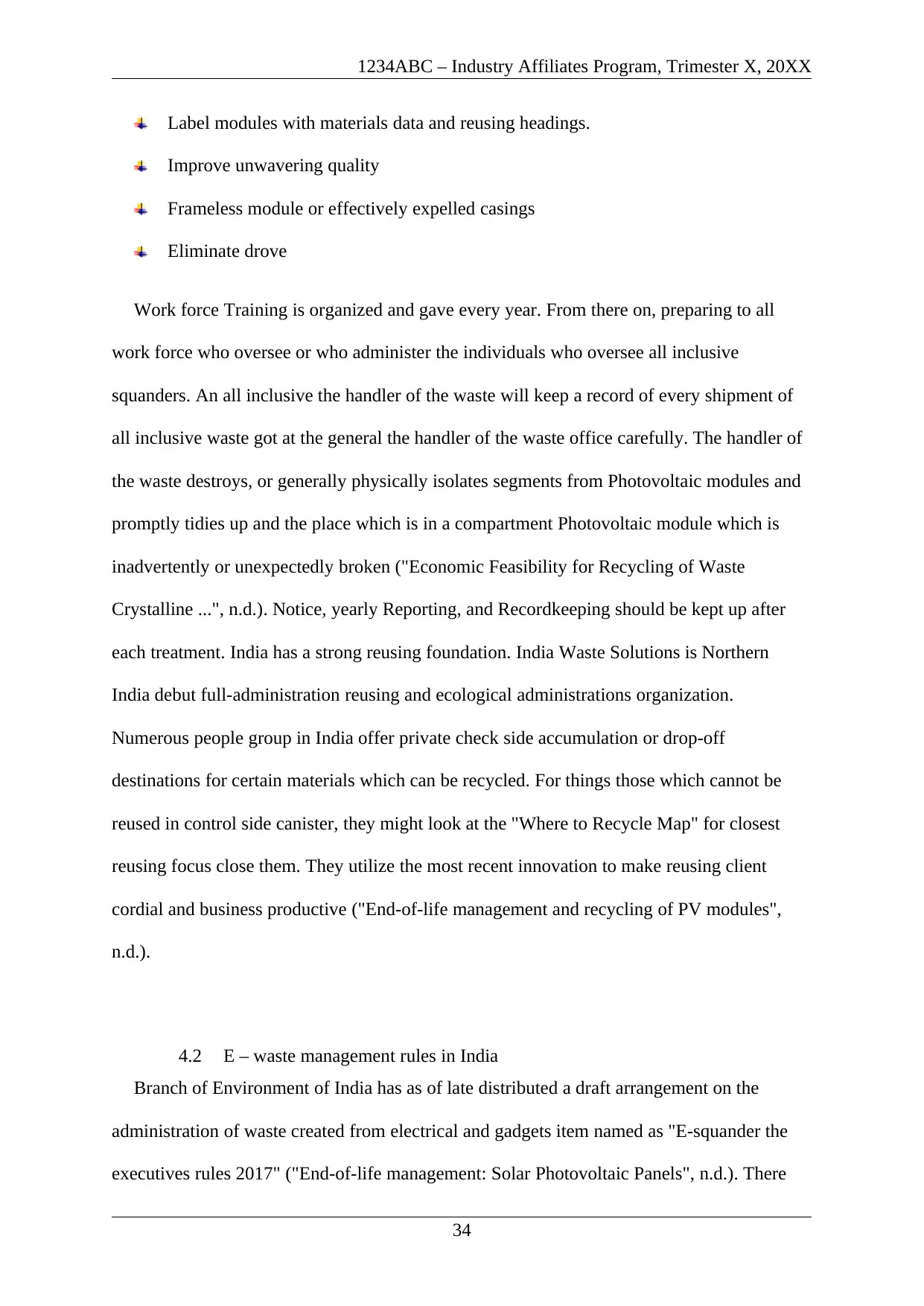
1234ABC – Industry Affiliates Program, Trimester X, 20XX
Label modules with materials data and reusing headings.
Improve unwavering quality
Frameless module or effectively expelled casings
Eliminate drove
Work force Training is organized and gave every year. From there on, preparing to all
work force who oversee or who administer the individuals who oversee all inclusive
squanders. An all inclusive the handler of the waste will keep a record of every shipment of
all inclusive waste got at the general the handler of the waste office carefully. The handler of
the waste destroys, or generally physically isolates segments from Photovoltaic modules and
promptly tidies up and the place which is in a compartment Photovoltaic module which is
inadvertently or unexpectedly broken ("Economic Feasibility for Recycling of Waste
Crystalline ...", n.d.). Notice, yearly Reporting, and Recordkeeping should be kept up after
each treatment. India has a strong reusing foundation. India Waste Solutions is Northern
India debut full-administration reusing and ecological administrations organization.
Numerous people group in India offer private check side accumulation or drop-off
destinations for certain materials which can be recycled. For things those which cannot be
reused in control side canister, they might look at the "Where to Recycle Map" for closest
reusing focus close them. They utilize the most recent innovation to make reusing client
cordial and business productive ("End-of-life management and recycling of PV modules",
n.d.).
4.2 E – waste management rules in India
Branch of Environment of India has as of late distributed a draft arrangement on the
administration of waste created from electrical and gadgets item named as "E-squander the
executives rules 2017" ("End-of-life management: Solar Photovoltaic Panels", n.d.). There
34
Label modules with materials data and reusing headings.
Improve unwavering quality
Frameless module or effectively expelled casings
Eliminate drove
Work force Training is organized and gave every year. From there on, preparing to all
work force who oversee or who administer the individuals who oversee all inclusive
squanders. An all inclusive the handler of the waste will keep a record of every shipment of
all inclusive waste got at the general the handler of the waste office carefully. The handler of
the waste destroys, or generally physically isolates segments from Photovoltaic modules and
promptly tidies up and the place which is in a compartment Photovoltaic module which is
inadvertently or unexpectedly broken ("Economic Feasibility for Recycling of Waste
Crystalline ...", n.d.). Notice, yearly Reporting, and Recordkeeping should be kept up after
each treatment. India has a strong reusing foundation. India Waste Solutions is Northern
India debut full-administration reusing and ecological administrations organization.
Numerous people group in India offer private check side accumulation or drop-off
destinations for certain materials which can be recycled. For things those which cannot be
reused in control side canister, they might look at the "Where to Recycle Map" for closest
reusing focus close them. They utilize the most recent innovation to make reusing client
cordial and business productive ("End-of-life management and recycling of PV modules",
n.d.).
4.2 E – waste management rules in India
Branch of Environment of India has as of late distributed a draft arrangement on the
administration of waste created from electrical and gadgets item named as "E-squander the
executives rules 2017" ("End-of-life management: Solar Photovoltaic Panels", n.d.). There
34
Secure Best Marks with AI Grader
Need help grading? Try our AI Grader for instant feedback on your assignments.
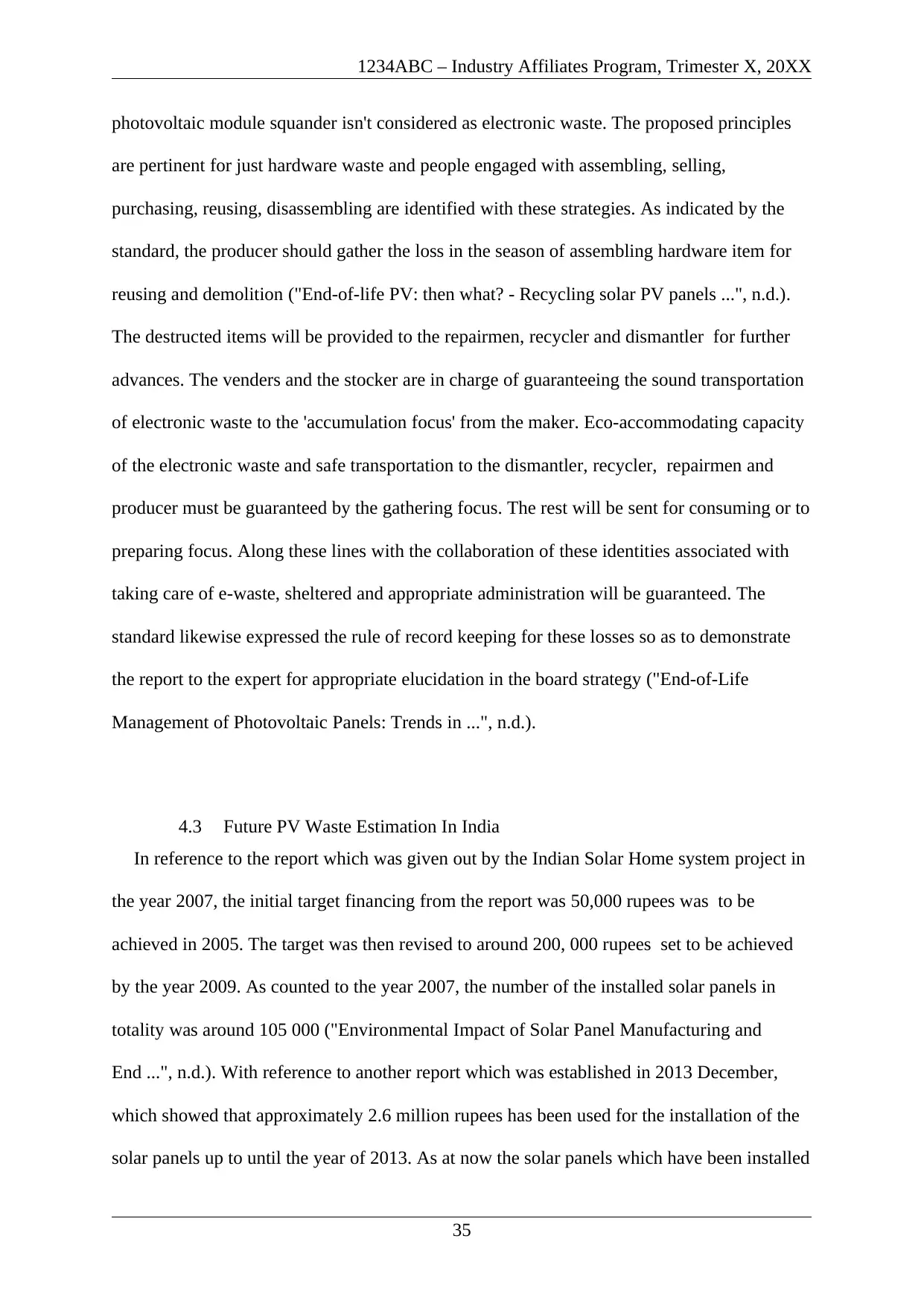
1234ABC – Industry Affiliates Program, Trimester X, 20XX
photovoltaic module squander isn't considered as electronic waste. The proposed principles
are pertinent for just hardware waste and people engaged with assembling, selling,
purchasing, reusing, disassembling are identified with these strategies. As indicated by the
standard, the producer should gather the loss in the season of assembling hardware item for
reusing and demolition ("End-of-life PV: then what? - Recycling solar PV panels ...", n.d.).
The destructed items will be provided to the repairmen, recycler and dismantler for further
advances. The venders and the stocker are in charge of guaranteeing the sound transportation
of electronic waste to the 'accumulation focus' from the maker. Eco-accommodating capacity
of the electronic waste and safe transportation to the dismantler, recycler, repairmen and
producer must be guaranteed by the gathering focus. The rest will be sent for consuming or to
preparing focus. Along these lines with the collaboration of these identities associated with
taking care of e-waste, sheltered and appropriate administration will be guaranteed. The
standard likewise expressed the rule of record keeping for these losses so as to demonstrate
the report to the expert for appropriate elucidation in the board strategy ("End‐of‐Life
Management of Photovoltaic Panels: Trends in ...", n.d.).
4.3 Future PV Waste Estimation In India
In reference to the report which was given out by the Indian Solar Home system project in
the year 2007, the initial target financing from the report was 50,000 rupees was to be
achieved in 2005. The target was then revised to around 200, 000 rupees set to be achieved
by the year 2009. As counted to the year 2007, the number of the installed solar panels in
totality was around 105 000 ("Environmental Impact of Solar Panel Manufacturing and
End ...", n.d.). With reference to another report which was established in 2013 December,
which showed that approximately 2.6 million rupees has been used for the installation of the
solar panels up to until the year of 2013. As at now the solar panels which have been installed
35
photovoltaic module squander isn't considered as electronic waste. The proposed principles
are pertinent for just hardware waste and people engaged with assembling, selling,
purchasing, reusing, disassembling are identified with these strategies. As indicated by the
standard, the producer should gather the loss in the season of assembling hardware item for
reusing and demolition ("End-of-life PV: then what? - Recycling solar PV panels ...", n.d.).
The destructed items will be provided to the repairmen, recycler and dismantler for further
advances. The venders and the stocker are in charge of guaranteeing the sound transportation
of electronic waste to the 'accumulation focus' from the maker. Eco-accommodating capacity
of the electronic waste and safe transportation to the dismantler, recycler, repairmen and
producer must be guaranteed by the gathering focus. The rest will be sent for consuming or to
preparing focus. Along these lines with the collaboration of these identities associated with
taking care of e-waste, sheltered and appropriate administration will be guaranteed. The
standard likewise expressed the rule of record keeping for these losses so as to demonstrate
the report to the expert for appropriate elucidation in the board strategy ("End‐of‐Life
Management of Photovoltaic Panels: Trends in ...", n.d.).
4.3 Future PV Waste Estimation In India
In reference to the report which was given out by the Indian Solar Home system project in
the year 2007, the initial target financing from the report was 50,000 rupees was to be
achieved in 2005. The target was then revised to around 200, 000 rupees set to be achieved
by the year 2009. As counted to the year 2007, the number of the installed solar panels in
totality was around 105 000 ("Environmental Impact of Solar Panel Manufacturing and
End ...", n.d.). With reference to another report which was established in 2013 December,
which showed that approximately 2.6 million rupees has been used for the installation of the
solar panels up to until the year of 2013. As at now the solar panels which have been installed
35
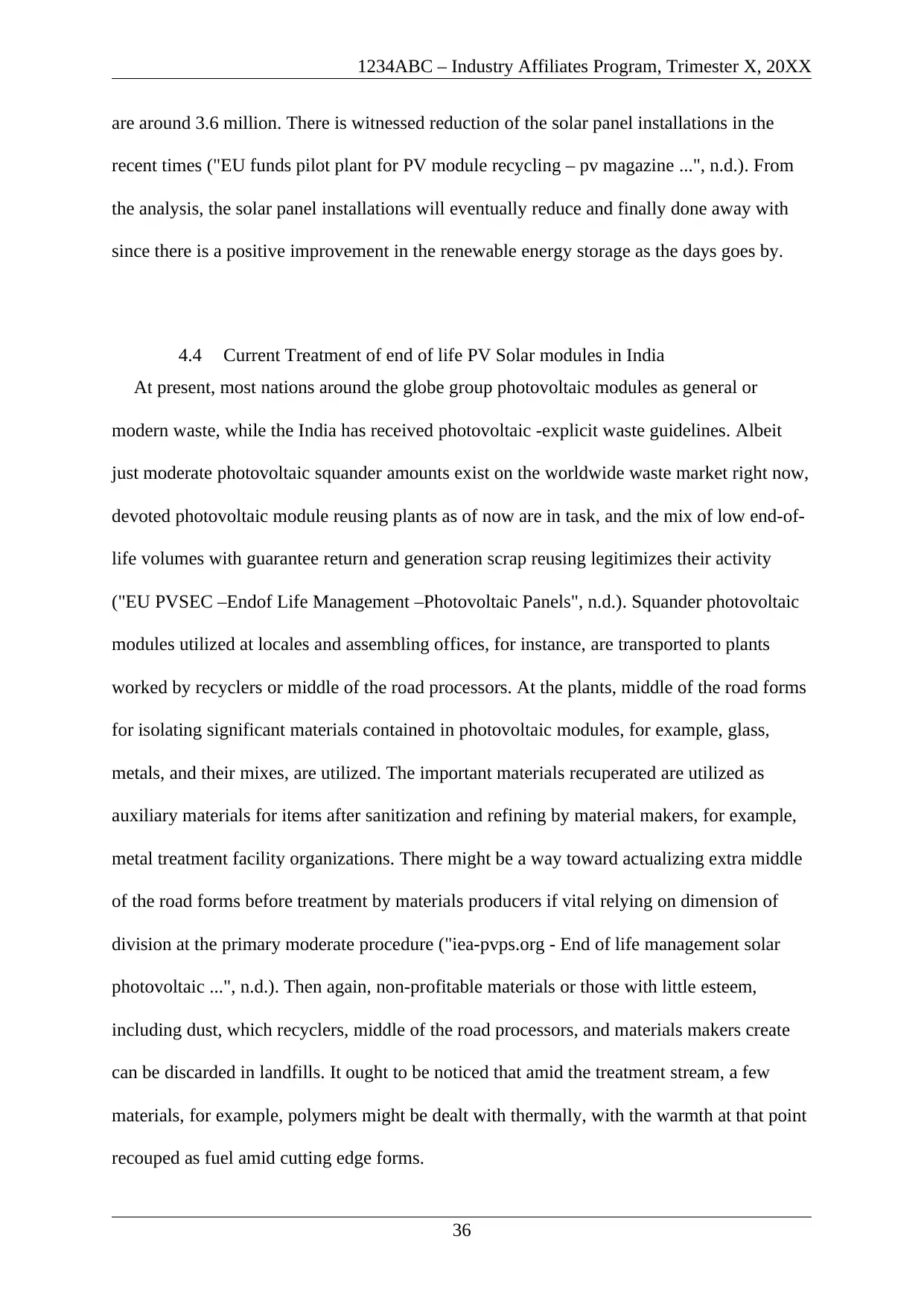
1234ABC – Industry Affiliates Program, Trimester X, 20XX
are around 3.6 million. There is witnessed reduction of the solar panel installations in the
recent times ("EU funds pilot plant for PV module recycling – pv magazine ...", n.d.). From
the analysis, the solar panel installations will eventually reduce and finally done away with
since there is a positive improvement in the renewable energy storage as the days goes by.
4.4 Current Treatment of end of life PV Solar modules in India
At present, most nations around the globe group photovoltaic modules as general or
modern waste, while the India has received photovoltaic -explicit waste guidelines. Albeit
just moderate photovoltaic squander amounts exist on the worldwide waste market right now,
devoted photovoltaic module reusing plants as of now are in task, and the mix of low end-of-
life volumes with guarantee return and generation scrap reusing legitimizes their activity
("EU PVSEC –Endof Life Management –Photovoltaic Panels", n.d.). Squander photovoltaic
modules utilized at locales and assembling offices, for instance, are transported to plants
worked by recyclers or middle of the road processors. At the plants, middle of the road forms
for isolating significant materials contained in photovoltaic modules, for example, glass,
metals, and their mixes, are utilized. The important materials recuperated are utilized as
auxiliary materials for items after sanitization and refining by material makers, for example,
metal treatment facility organizations. There might be a way toward actualizing extra middle
of the road forms before treatment by materials producers if vital relying on dimension of
division at the primary moderate procedure ("iea-pvps.org - End of life management solar
photovoltaic ...", n.d.). Then again, non-profitable materials or those with little esteem,
including dust, which recyclers, middle of the road processors, and materials makers create
can be discarded in landfills. It ought to be noticed that amid the treatment stream, a few
materials, for example, polymers might be dealt with thermally, with the warmth at that point
recouped as fuel amid cutting edge forms.
36
are around 3.6 million. There is witnessed reduction of the solar panel installations in the
recent times ("EU funds pilot plant for PV module recycling – pv magazine ...", n.d.). From
the analysis, the solar panel installations will eventually reduce and finally done away with
since there is a positive improvement in the renewable energy storage as the days goes by.
4.4 Current Treatment of end of life PV Solar modules in India
At present, most nations around the globe group photovoltaic modules as general or
modern waste, while the India has received photovoltaic -explicit waste guidelines. Albeit
just moderate photovoltaic squander amounts exist on the worldwide waste market right now,
devoted photovoltaic module reusing plants as of now are in task, and the mix of low end-of-
life volumes with guarantee return and generation scrap reusing legitimizes their activity
("EU PVSEC –Endof Life Management –Photovoltaic Panels", n.d.). Squander photovoltaic
modules utilized at locales and assembling offices, for instance, are transported to plants
worked by recyclers or middle of the road processors. At the plants, middle of the road forms
for isolating significant materials contained in photovoltaic modules, for example, glass,
metals, and their mixes, are utilized. The important materials recuperated are utilized as
auxiliary materials for items after sanitization and refining by material makers, for example,
metal treatment facility organizations. There might be a way toward actualizing extra middle
of the road forms before treatment by materials producers if vital relying on dimension of
division at the primary moderate procedure ("iea-pvps.org - End of life management solar
photovoltaic ...", n.d.). Then again, non-profitable materials or those with little esteem,
including dust, which recyclers, middle of the road processors, and materials makers create
can be discarded in landfills. It ought to be noticed that amid the treatment stream, a few
materials, for example, polymers might be dealt with thermally, with the warmth at that point
recouped as fuel amid cutting edge forms.
36
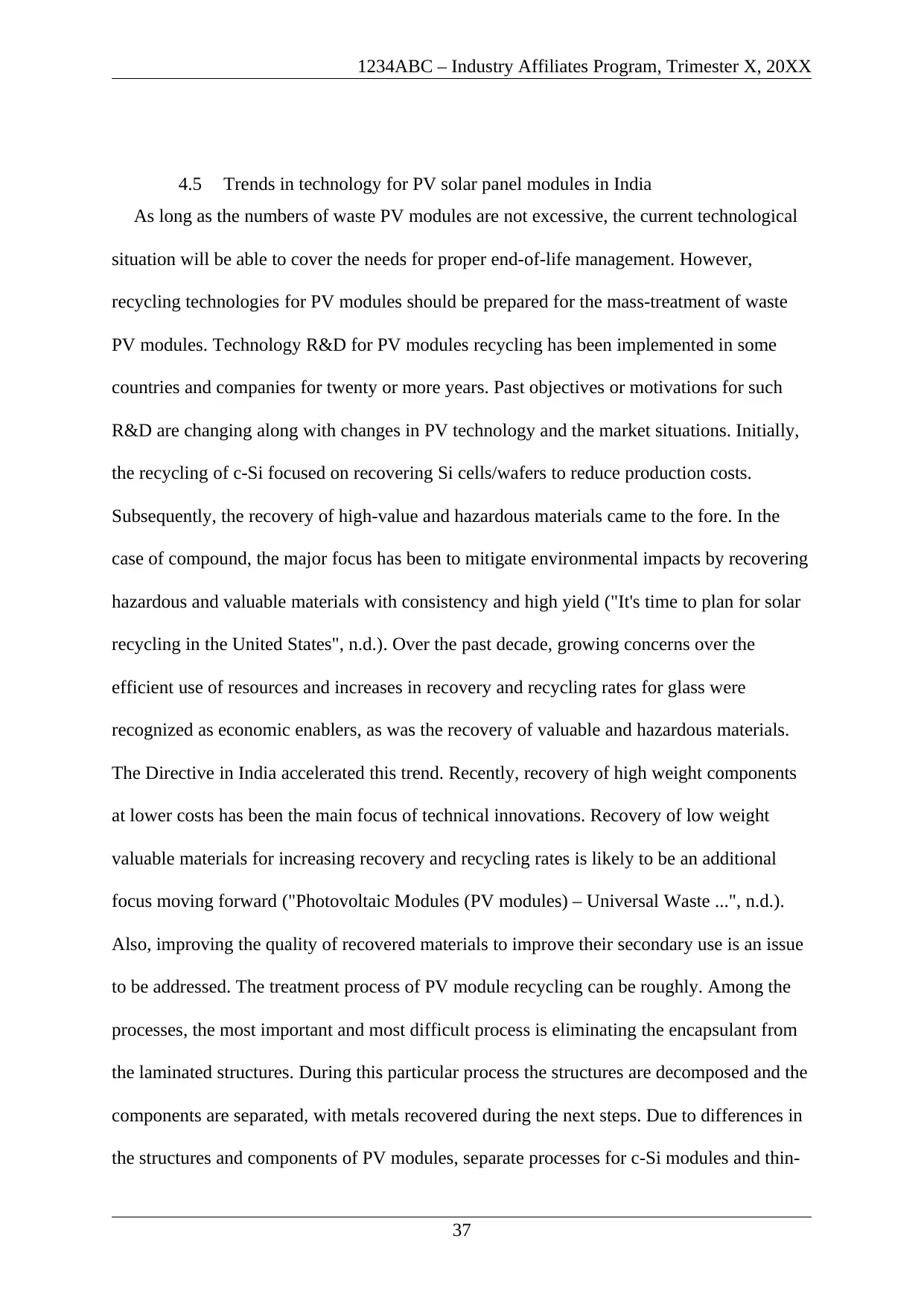
1234ABC – Industry Affiliates Program, Trimester X, 20XX
4.5 Trends in technology for PV solar panel modules in India
As long as the numbers of waste PV modules are not excessive, the current technological
situation will be able to cover the needs for proper end-of-life management. However,
recycling technologies for PV modules should be prepared for the mass-treatment of waste
PV modules. Technology R&D for PV modules recycling has been implemented in some
countries and companies for twenty or more years. Past objectives or motivations for such
R&D are changing along with changes in PV technology and the market situations. Initially,
the recycling of c-Si focused on recovering Si cells/wafers to reduce production costs.
Subsequently, the recovery of high-value and hazardous materials came to the fore. In the
case of compound, the major focus has been to mitigate environmental impacts by recovering
hazardous and valuable materials with consistency and high yield ("It's time to plan for solar
recycling in the United States", n.d.). Over the past decade, growing concerns over the
efficient use of resources and increases in recovery and recycling rates for glass were
recognized as economic enablers, as was the recovery of valuable and hazardous materials.
The Directive in India accelerated this trend. Recently, recovery of high weight components
at lower costs has been the main focus of technical innovations. Recovery of low weight
valuable materials for increasing recovery and recycling rates is likely to be an additional
focus moving forward ("Photovoltaic Modules (PV modules) – Universal Waste ...", n.d.).
Also, improving the quality of recovered materials to improve their secondary use is an issue
to be addressed. The treatment process of PV module recycling can be roughly. Among the
processes, the most important and most difficult process is eliminating the encapsulant from
the laminated structures. During this particular process the structures are decomposed and the
components are separated, with metals recovered during the next steps. Due to differences in
the structures and components of PV modules, separate processes for c-Si modules and thin-
37
4.5 Trends in technology for PV solar panel modules in India
As long as the numbers of waste PV modules are not excessive, the current technological
situation will be able to cover the needs for proper end-of-life management. However,
recycling technologies for PV modules should be prepared for the mass-treatment of waste
PV modules. Technology R&D for PV modules recycling has been implemented in some
countries and companies for twenty or more years. Past objectives or motivations for such
R&D are changing along with changes in PV technology and the market situations. Initially,
the recycling of c-Si focused on recovering Si cells/wafers to reduce production costs.
Subsequently, the recovery of high-value and hazardous materials came to the fore. In the
case of compound, the major focus has been to mitigate environmental impacts by recovering
hazardous and valuable materials with consistency and high yield ("It's time to plan for solar
recycling in the United States", n.d.). Over the past decade, growing concerns over the
efficient use of resources and increases in recovery and recycling rates for glass were
recognized as economic enablers, as was the recovery of valuable and hazardous materials.
The Directive in India accelerated this trend. Recently, recovery of high weight components
at lower costs has been the main focus of technical innovations. Recovery of low weight
valuable materials for increasing recovery and recycling rates is likely to be an additional
focus moving forward ("Photovoltaic Modules (PV modules) – Universal Waste ...", n.d.).
Also, improving the quality of recovered materials to improve their secondary use is an issue
to be addressed. The treatment process of PV module recycling can be roughly. Among the
processes, the most important and most difficult process is eliminating the encapsulant from
the laminated structures. During this particular process the structures are decomposed and the
components are separated, with metals recovered during the next steps. Due to differences in
the structures and components of PV modules, separate processes for c-Si modules and thin-
37
Paraphrase This Document
Need a fresh take? Get an instant paraphrase of this document with our AI Paraphraser
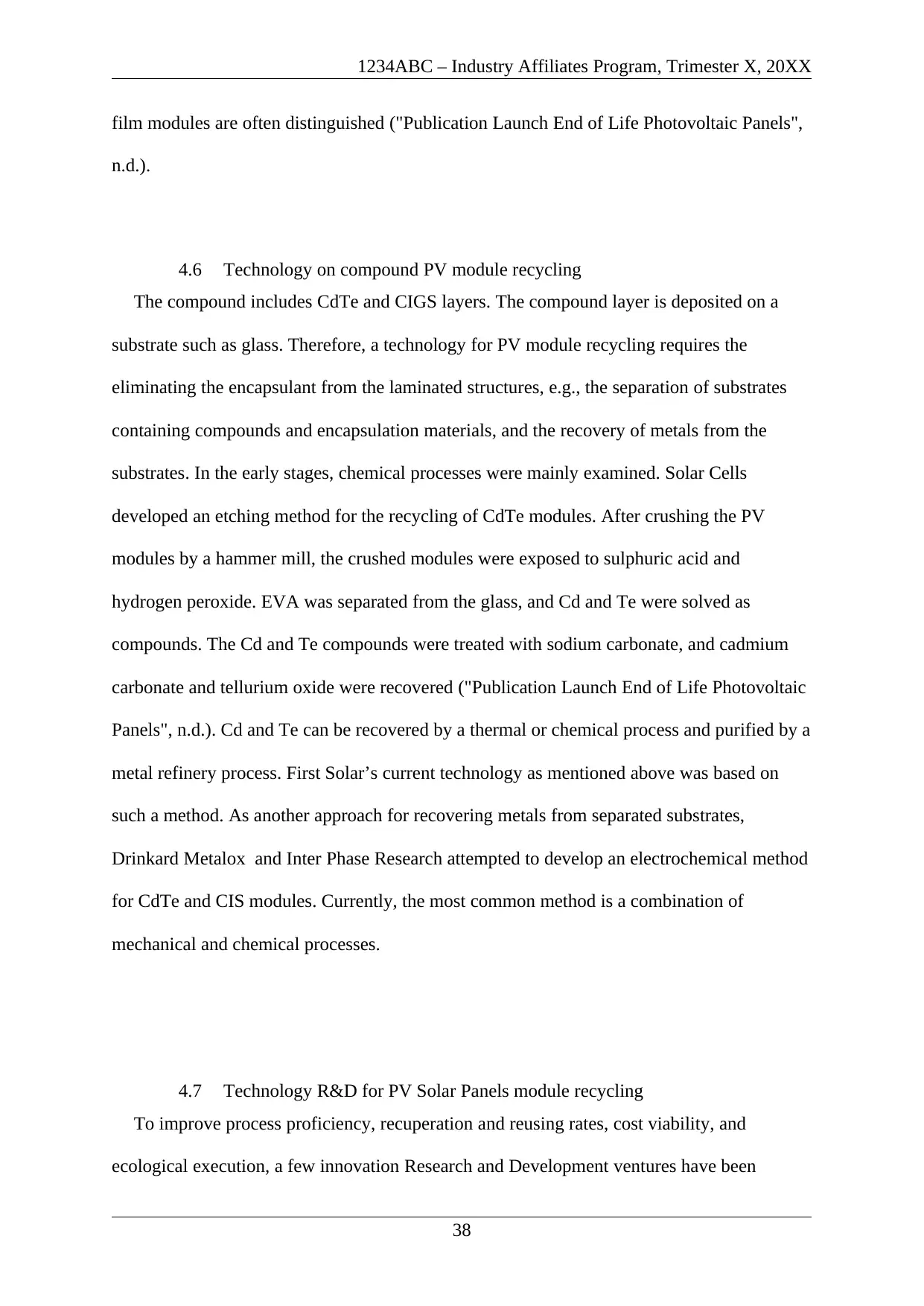
1234ABC – Industry Affiliates Program, Trimester X, 20XX
film modules are often distinguished ("Publication Launch End of Life Photovoltaic Panels",
n.d.).
4.6 Technology on compound PV module recycling
The compound includes CdTe and CIGS layers. The compound layer is deposited on a
substrate such as glass. Therefore, a technology for PV module recycling requires the
eliminating the encapsulant from the laminated structures, e.g., the separation of substrates
containing compounds and encapsulation materials, and the recovery of metals from the
substrates. In the early stages, chemical processes were mainly examined. Solar Cells
developed an etching method for the recycling of CdTe modules. After crushing the PV
modules by a hammer mill, the crushed modules were exposed to sulphuric acid and
hydrogen peroxide. EVA was separated from the glass, and Cd and Te were solved as
compounds. The Cd and Te compounds were treated with sodium carbonate, and cadmium
carbonate and tellurium oxide were recovered ("Publication Launch End of Life Photovoltaic
Panels", n.d.). Cd and Te can be recovered by a thermal or chemical process and purified by a
metal refinery process. First Solar’s current technology as mentioned above was based on
such a method. As another approach for recovering metals from separated substrates,
Drinkard Metalox and Inter Phase Research attempted to develop an electrochemical method
for CdTe and CIS modules. Currently, the most common method is a combination of
mechanical and chemical processes.
4.7 Technology R&D for PV Solar Panels module recycling
To improve process proficiency, recuperation and reusing rates, cost viability, and
ecological execution, a few innovation Research and Development ventures have been
38
film modules are often distinguished ("Publication Launch End of Life Photovoltaic Panels",
n.d.).
4.6 Technology on compound PV module recycling
The compound includes CdTe and CIGS layers. The compound layer is deposited on a
substrate such as glass. Therefore, a technology for PV module recycling requires the
eliminating the encapsulant from the laminated structures, e.g., the separation of substrates
containing compounds and encapsulation materials, and the recovery of metals from the
substrates. In the early stages, chemical processes were mainly examined. Solar Cells
developed an etching method for the recycling of CdTe modules. After crushing the PV
modules by a hammer mill, the crushed modules were exposed to sulphuric acid and
hydrogen peroxide. EVA was separated from the glass, and Cd and Te were solved as
compounds. The Cd and Te compounds were treated with sodium carbonate, and cadmium
carbonate and tellurium oxide were recovered ("Publication Launch End of Life Photovoltaic
Panels", n.d.). Cd and Te can be recovered by a thermal or chemical process and purified by a
metal refinery process. First Solar’s current technology as mentioned above was based on
such a method. As another approach for recovering metals from separated substrates,
Drinkard Metalox and Inter Phase Research attempted to develop an electrochemical method
for CdTe and CIS modules. Currently, the most common method is a combination of
mechanical and chemical processes.
4.7 Technology R&D for PV Solar Panels module recycling
To improve process proficiency, recuperation and reusing rates, cost viability, and
ecological execution, a few innovation Research and Development ventures have been
38
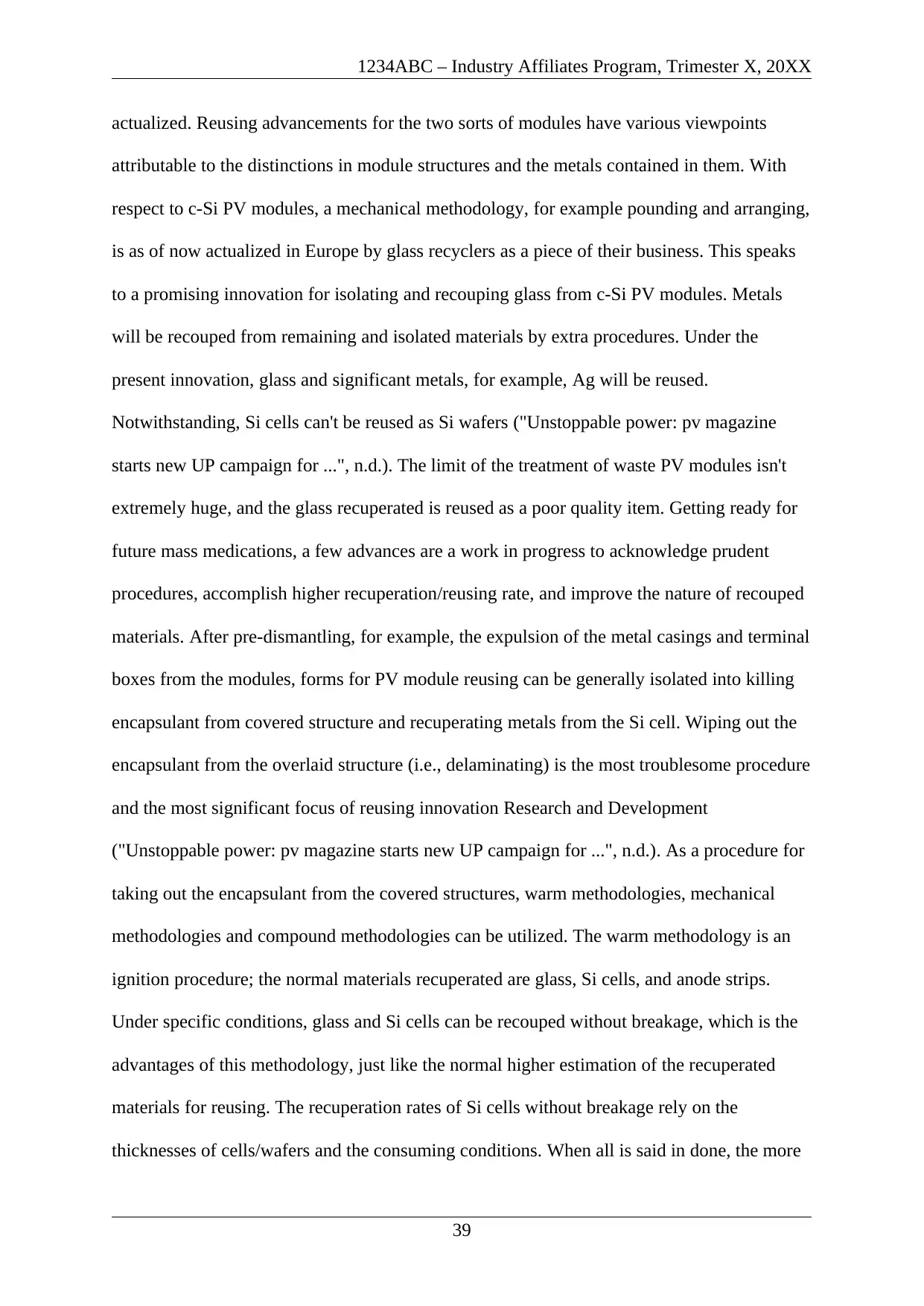
1234ABC – Industry Affiliates Program, Trimester X, 20XX
actualized. Reusing advancements for the two sorts of modules have various viewpoints
attributable to the distinctions in module structures and the metals contained in them. With
respect to c-Si PV modules, a mechanical methodology, for example pounding and arranging,
is as of now actualized in Europe by glass recyclers as a piece of their business. This speaks
to a promising innovation for isolating and recouping glass from c-Si PV modules. Metals
will be recouped from remaining and isolated materials by extra procedures. Under the
present innovation, glass and significant metals, for example, Ag will be reused.
Notwithstanding, Si cells can't be reused as Si wafers ("Unstoppable power: pv magazine
starts new UP campaign for ...", n.d.). The limit of the treatment of waste PV modules isn't
extremely huge, and the glass recuperated is reused as a poor quality item. Getting ready for
future mass medications, a few advances are a work in progress to acknowledge prudent
procedures, accomplish higher recuperation/reusing rate, and improve the nature of recouped
materials. After pre-dismantling, for example, the expulsion of the metal casings and terminal
boxes from the modules, forms for PV module reusing can be generally isolated into killing
encapsulant from covered structure and recuperating metals from the Si cell. Wiping out the
encapsulant from the overlaid structure (i.e., delaminating) is the most troublesome procedure
and the most significant focus of reusing innovation Research and Development
("Unstoppable power: pv magazine starts new UP campaign for ...", n.d.). As a procedure for
taking out the encapsulant from the covered structures, warm methodologies, mechanical
methodologies and compound methodologies can be utilized. The warm methodology is an
ignition procedure; the normal materials recuperated are glass, Si cells, and anode strips.
Under specific conditions, glass and Si cells can be recouped without breakage, which is the
advantages of this methodology, just like the normal higher estimation of the recuperated
materials for reusing. The recuperation rates of Si cells without breakage rely on the
thicknesses of cells/wafers and the consuming conditions. When all is said in done, the more
39
actualized. Reusing advancements for the two sorts of modules have various viewpoints
attributable to the distinctions in module structures and the metals contained in them. With
respect to c-Si PV modules, a mechanical methodology, for example pounding and arranging,
is as of now actualized in Europe by glass recyclers as a piece of their business. This speaks
to a promising innovation for isolating and recouping glass from c-Si PV modules. Metals
will be recouped from remaining and isolated materials by extra procedures. Under the
present innovation, glass and significant metals, for example, Ag will be reused.
Notwithstanding, Si cells can't be reused as Si wafers ("Unstoppable power: pv magazine
starts new UP campaign for ...", n.d.). The limit of the treatment of waste PV modules isn't
extremely huge, and the glass recuperated is reused as a poor quality item. Getting ready for
future mass medications, a few advances are a work in progress to acknowledge prudent
procedures, accomplish higher recuperation/reusing rate, and improve the nature of recouped
materials. After pre-dismantling, for example, the expulsion of the metal casings and terminal
boxes from the modules, forms for PV module reusing can be generally isolated into killing
encapsulant from covered structure and recuperating metals from the Si cell. Wiping out the
encapsulant from the overlaid structure (i.e., delaminating) is the most troublesome procedure
and the most significant focus of reusing innovation Research and Development
("Unstoppable power: pv magazine starts new UP campaign for ...", n.d.). As a procedure for
taking out the encapsulant from the covered structures, warm methodologies, mechanical
methodologies and compound methodologies can be utilized. The warm methodology is an
ignition procedure; the normal materials recuperated are glass, Si cells, and anode strips.
Under specific conditions, glass and Si cells can be recouped without breakage, which is the
advantages of this methodology, just like the normal higher estimation of the recuperated
materials for reusing. The recuperation rates of Si cells without breakage rely on the
thicknesses of cells/wafers and the consuming conditions. When all is said in done, the more
39
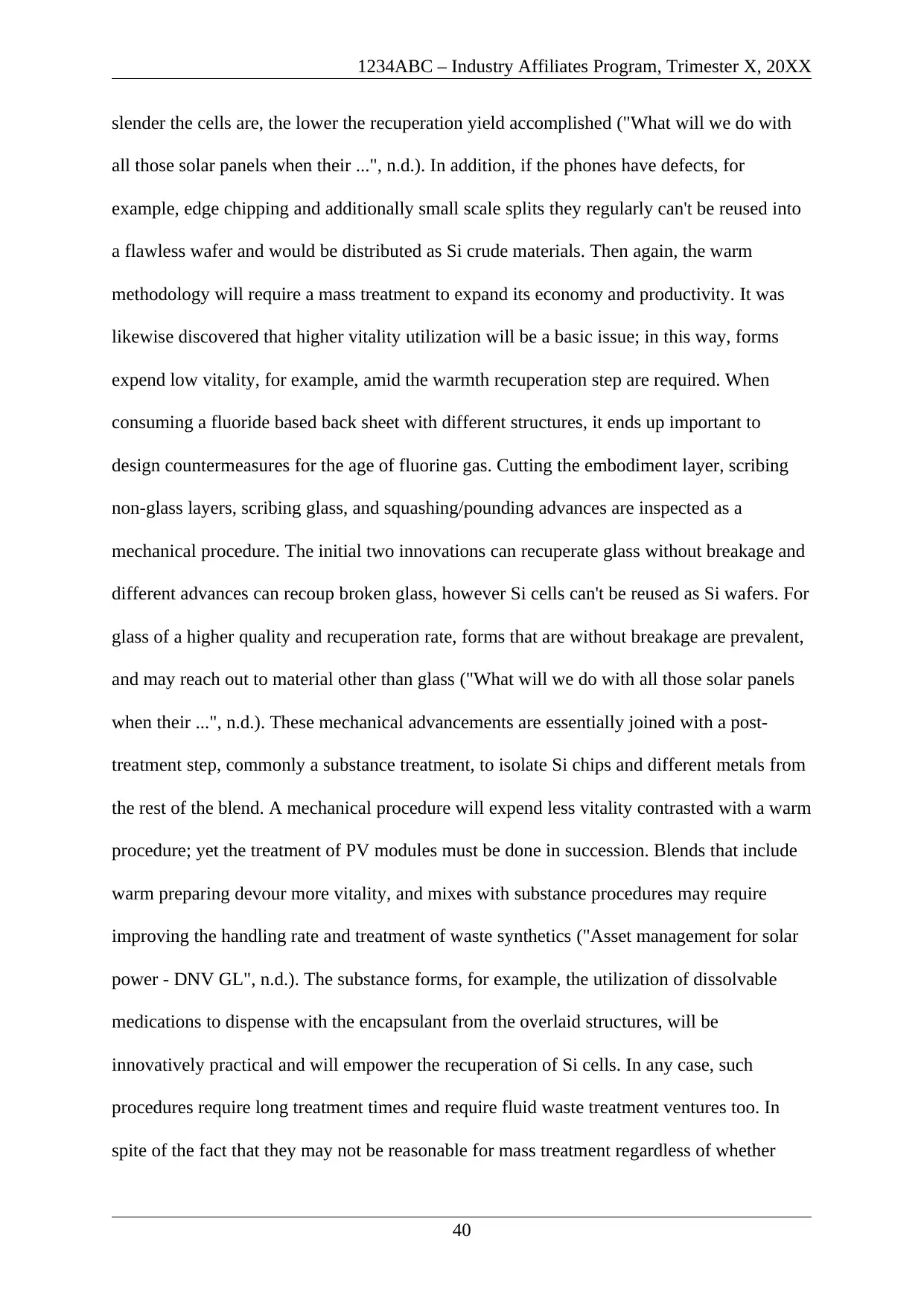
1234ABC – Industry Affiliates Program, Trimester X, 20XX
slender the cells are, the lower the recuperation yield accomplished ("What will we do with
all those solar panels when their ...", n.d.). In addition, if the phones have defects, for
example, edge chipping and additionally small scale splits they regularly can't be reused into
a flawless wafer and would be distributed as Si crude materials. Then again, the warm
methodology will require a mass treatment to expand its economy and productivity. It was
likewise discovered that higher vitality utilization will be a basic issue; in this way, forms
expend low vitality, for example, amid the warmth recuperation step are required. When
consuming a fluoride based back sheet with different structures, it ends up important to
design countermeasures for the age of fluorine gas. Cutting the embodiment layer, scribing
non-glass layers, scribing glass, and squashing/pounding advances are inspected as a
mechanical procedure. The initial two innovations can recuperate glass without breakage and
different advances can recoup broken glass, however Si cells can't be reused as Si wafers. For
glass of a higher quality and recuperation rate, forms that are without breakage are prevalent,
and may reach out to material other than glass ("What will we do with all those solar panels
when their ...", n.d.). These mechanical advancements are essentially joined with a post-
treatment step, commonly a substance treatment, to isolate Si chips and different metals from
the rest of the blend. A mechanical procedure will expend less vitality contrasted with a warm
procedure; yet the treatment of PV modules must be done in succession. Blends that include
warm preparing devour more vitality, and mixes with substance procedures may require
improving the handling rate and treatment of waste synthetics ("Asset management for solar
power - DNV GL", n.d.). The substance forms, for example, the utilization of dissolvable
medications to dispense with the encapsulant from the overlaid structures, will be
innovatively practical and will empower the recuperation of Si cells. In any case, such
procedures require long treatment times and require fluid waste treatment ventures too. In
spite of the fact that they may not be reasonable for mass treatment regardless of whether
40
slender the cells are, the lower the recuperation yield accomplished ("What will we do with
all those solar panels when their ...", n.d.). In addition, if the phones have defects, for
example, edge chipping and additionally small scale splits they regularly can't be reused into
a flawless wafer and would be distributed as Si crude materials. Then again, the warm
methodology will require a mass treatment to expand its economy and productivity. It was
likewise discovered that higher vitality utilization will be a basic issue; in this way, forms
expend low vitality, for example, amid the warmth recuperation step are required. When
consuming a fluoride based back sheet with different structures, it ends up important to
design countermeasures for the age of fluorine gas. Cutting the embodiment layer, scribing
non-glass layers, scribing glass, and squashing/pounding advances are inspected as a
mechanical procedure. The initial two innovations can recuperate glass without breakage and
different advances can recoup broken glass, however Si cells can't be reused as Si wafers. For
glass of a higher quality and recuperation rate, forms that are without breakage are prevalent,
and may reach out to material other than glass ("What will we do with all those solar panels
when their ...", n.d.). These mechanical advancements are essentially joined with a post-
treatment step, commonly a substance treatment, to isolate Si chips and different metals from
the rest of the blend. A mechanical procedure will expend less vitality contrasted with a warm
procedure; yet the treatment of PV modules must be done in succession. Blends that include
warm preparing devour more vitality, and mixes with substance procedures may require
improving the handling rate and treatment of waste synthetics ("Asset management for solar
power - DNV GL", n.d.). The substance forms, for example, the utilization of dissolvable
medications to dispense with the encapsulant from the overlaid structures, will be
innovatively practical and will empower the recuperation of Si cells. In any case, such
procedures require long treatment times and require fluid waste treatment ventures too. In
spite of the fact that they may not be reasonable for mass treatment regardless of whether
40
Secure Best Marks with AI Grader
Need help grading? Try our AI Grader for instant feedback on your assignments.
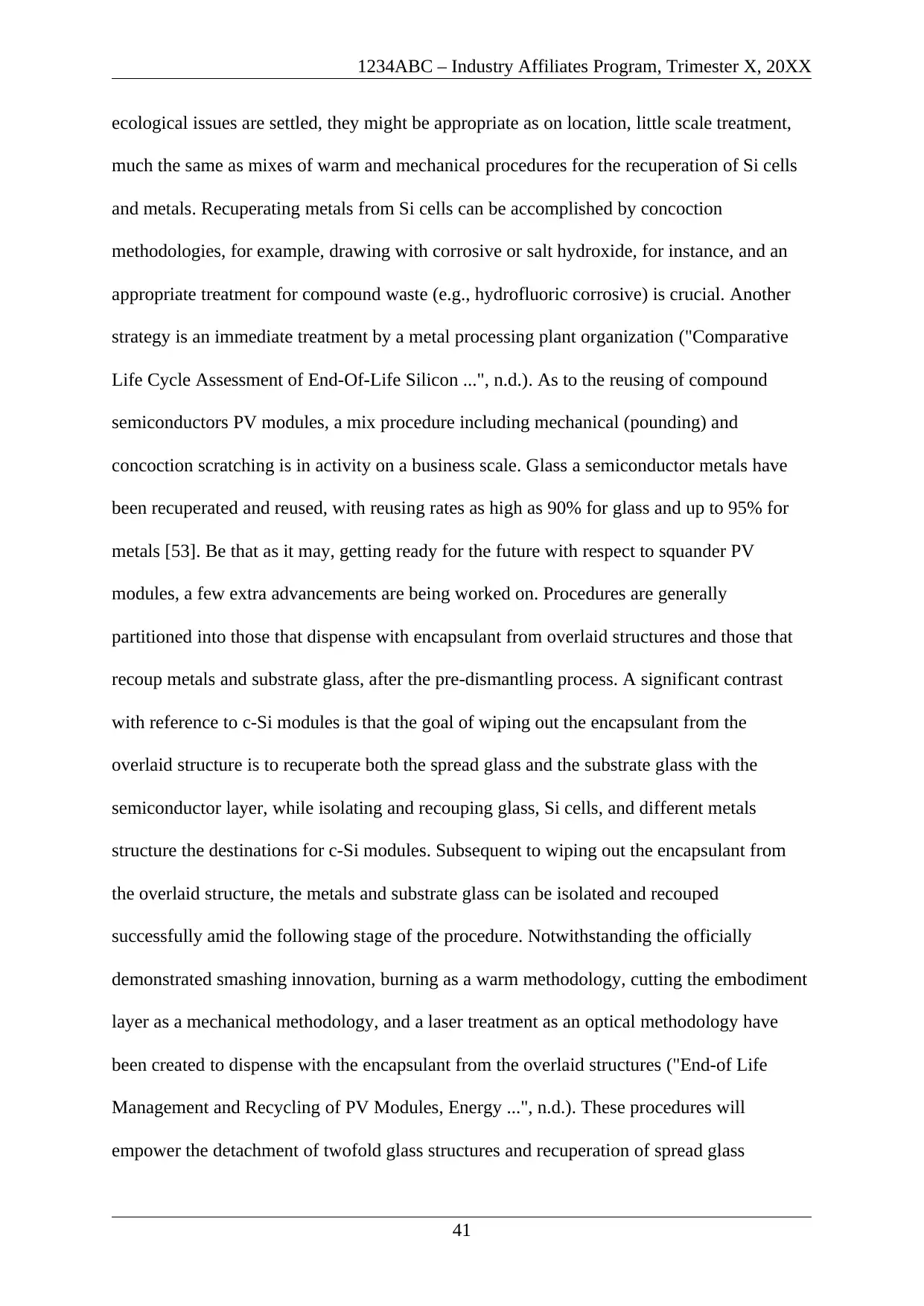
1234ABC – Industry Affiliates Program, Trimester X, 20XX
ecological issues are settled, they might be appropriate as on location, little scale treatment,
much the same as mixes of warm and mechanical procedures for the recuperation of Si cells
and metals. Recuperating metals from Si cells can be accomplished by concoction
methodologies, for example, drawing with corrosive or salt hydroxide, for instance, and an
appropriate treatment for compound waste (e.g., hydrofluoric corrosive) is crucial. Another
strategy is an immediate treatment by a metal processing plant organization ("Comparative
Life Cycle Assessment of End-Of-Life Silicon ...", n.d.). As to the reusing of compound
semiconductors PV modules, a mix procedure including mechanical (pounding) and
concoction scratching is in activity on a business scale. Glass a semiconductor metals have
been recuperated and reused, with reusing rates as high as 90% for glass and up to 95% for
metals [53]. Be that as it may, getting ready for the future with respect to squander PV
modules, a few extra advancements are being worked on. Procedures are generally
partitioned into those that dispense with encapsulant from overlaid structures and those that
recoup metals and substrate glass, after the pre-dismantling process. A significant contrast
with reference to c-Si modules is that the goal of wiping out the encapsulant from the
overlaid structure is to recuperate both the spread glass and the substrate glass with the
semiconductor layer, while isolating and recouping glass, Si cells, and different metals
structure the destinations for c-Si modules. Subsequent to wiping out the encapsulant from
the overlaid structure, the metals and substrate glass can be isolated and recouped
successfully amid the following stage of the procedure. Notwithstanding the officially
demonstrated smashing innovation, burning as a warm methodology, cutting the embodiment
layer as a mechanical methodology, and a laser treatment as an optical methodology have
been created to dispense with the encapsulant from the overlaid structures ("End-of Life
Management and Recycling of PV Modules, Energy ...", n.d.). These procedures will
empower the detachment of twofold glass structures and recuperation of spread glass
41
ecological issues are settled, they might be appropriate as on location, little scale treatment,
much the same as mixes of warm and mechanical procedures for the recuperation of Si cells
and metals. Recuperating metals from Si cells can be accomplished by concoction
methodologies, for example, drawing with corrosive or salt hydroxide, for instance, and an
appropriate treatment for compound waste (e.g., hydrofluoric corrosive) is crucial. Another
strategy is an immediate treatment by a metal processing plant organization ("Comparative
Life Cycle Assessment of End-Of-Life Silicon ...", n.d.). As to the reusing of compound
semiconductors PV modules, a mix procedure including mechanical (pounding) and
concoction scratching is in activity on a business scale. Glass a semiconductor metals have
been recuperated and reused, with reusing rates as high as 90% for glass and up to 95% for
metals [53]. Be that as it may, getting ready for the future with respect to squander PV
modules, a few extra advancements are being worked on. Procedures are generally
partitioned into those that dispense with encapsulant from overlaid structures and those that
recoup metals and substrate glass, after the pre-dismantling process. A significant contrast
with reference to c-Si modules is that the goal of wiping out the encapsulant from the
overlaid structure is to recuperate both the spread glass and the substrate glass with the
semiconductor layer, while isolating and recouping glass, Si cells, and different metals
structure the destinations for c-Si modules. Subsequent to wiping out the encapsulant from
the overlaid structure, the metals and substrate glass can be isolated and recouped
successfully amid the following stage of the procedure. Notwithstanding the officially
demonstrated smashing innovation, burning as a warm methodology, cutting the embodiment
layer as a mechanical methodology, and a laser treatment as an optical methodology have
been created to dispense with the encapsulant from the overlaid structures ("End-of Life
Management and Recycling of PV Modules, Energy ...", n.d.). These procedures will
empower the detachment of twofold glass structures and recuperation of spread glass
41
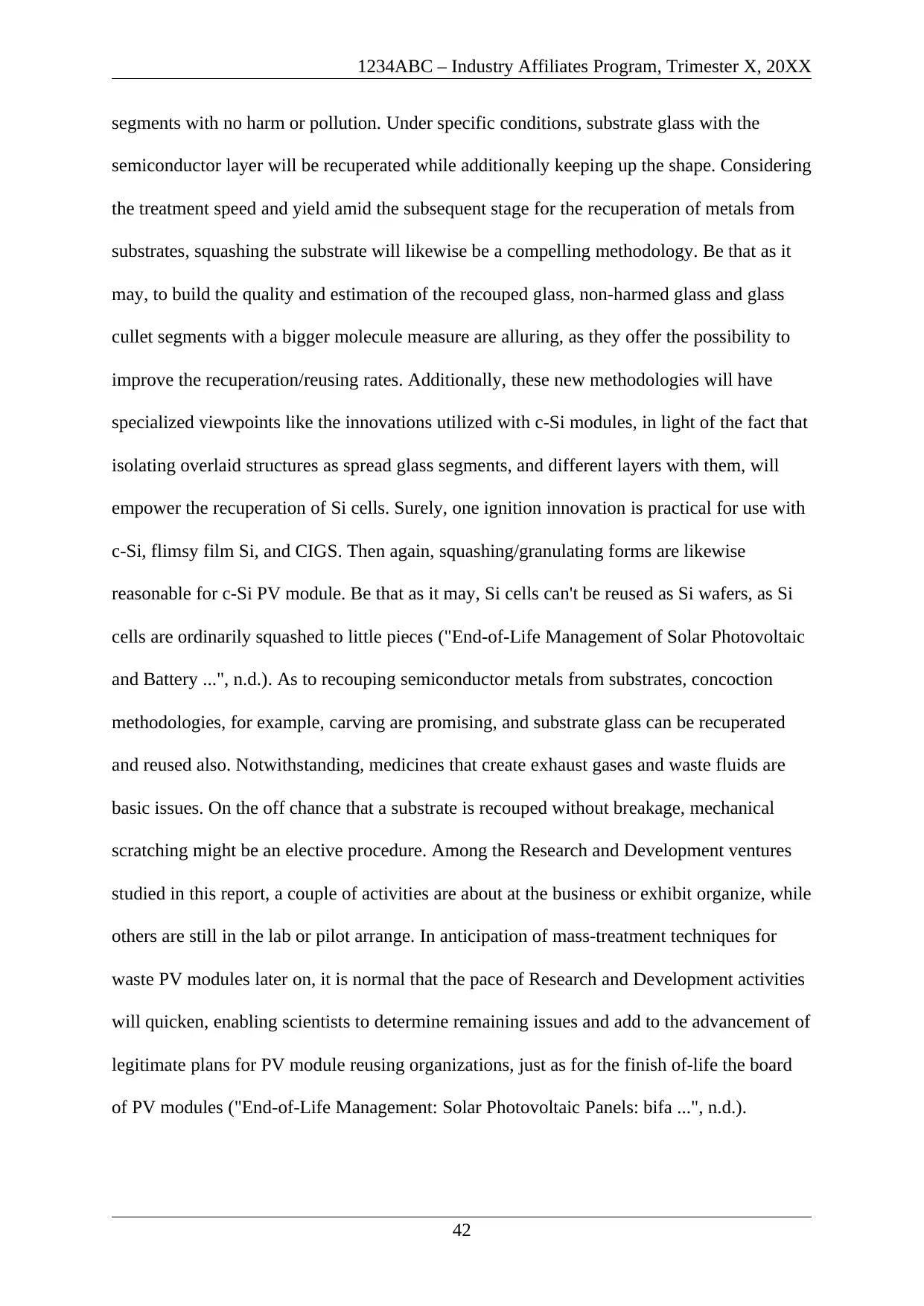
1234ABC – Industry Affiliates Program, Trimester X, 20XX
segments with no harm or pollution. Under specific conditions, substrate glass with the
semiconductor layer will be recuperated while additionally keeping up the shape. Considering
the treatment speed and yield amid the subsequent stage for the recuperation of metals from
substrates, squashing the substrate will likewise be a compelling methodology. Be that as it
may, to build the quality and estimation of the recouped glass, non-harmed glass and glass
cullet segments with a bigger molecule measure are alluring, as they offer the possibility to
improve the recuperation/reusing rates. Additionally, these new methodologies will have
specialized viewpoints like the innovations utilized with c-Si modules, in light of the fact that
isolating overlaid structures as spread glass segments, and different layers with them, will
empower the recuperation of Si cells. Surely, one ignition innovation is practical for use with
c-Si, flimsy film Si, and CIGS. Then again, squashing/granulating forms are likewise
reasonable for c-Si PV module. Be that as it may, Si cells can't be reused as Si wafers, as Si
cells are ordinarily squashed to little pieces ("End-of-Life Management of Solar Photovoltaic
and Battery ...", n.d.). As to recouping semiconductor metals from substrates, concoction
methodologies, for example, carving are promising, and substrate glass can be recuperated
and reused also. Notwithstanding, medicines that create exhaust gases and waste fluids are
basic issues. On the off chance that a substrate is recouped without breakage, mechanical
scratching might be an elective procedure. Among the Research and Development ventures
studied in this report, a couple of activities are about at the business or exhibit organize, while
others are still in the lab or pilot arrange. In anticipation of mass-treatment techniques for
waste PV modules later on, it is normal that the pace of Research and Development activities
will quicken, enabling scientists to determine remaining issues and add to the advancement of
legitimate plans for PV module reusing organizations, just as for the finish of-life the board
of PV modules ("End-of-Life Management: Solar Photovoltaic Panels: bifa ...", n.d.).
42
segments with no harm or pollution. Under specific conditions, substrate glass with the
semiconductor layer will be recuperated while additionally keeping up the shape. Considering
the treatment speed and yield amid the subsequent stage for the recuperation of metals from
substrates, squashing the substrate will likewise be a compelling methodology. Be that as it
may, to build the quality and estimation of the recouped glass, non-harmed glass and glass
cullet segments with a bigger molecule measure are alluring, as they offer the possibility to
improve the recuperation/reusing rates. Additionally, these new methodologies will have
specialized viewpoints like the innovations utilized with c-Si modules, in light of the fact that
isolating overlaid structures as spread glass segments, and different layers with them, will
empower the recuperation of Si cells. Surely, one ignition innovation is practical for use with
c-Si, flimsy film Si, and CIGS. Then again, squashing/granulating forms are likewise
reasonable for c-Si PV module. Be that as it may, Si cells can't be reused as Si wafers, as Si
cells are ordinarily squashed to little pieces ("End-of-Life Management of Solar Photovoltaic
and Battery ...", n.d.). As to recouping semiconductor metals from substrates, concoction
methodologies, for example, carving are promising, and substrate glass can be recuperated
and reused also. Notwithstanding, medicines that create exhaust gases and waste fluids are
basic issues. On the off chance that a substrate is recouped without breakage, mechanical
scratching might be an elective procedure. Among the Research and Development ventures
studied in this report, a couple of activities are about at the business or exhibit organize, while
others are still in the lab or pilot arrange. In anticipation of mass-treatment techniques for
waste PV modules later on, it is normal that the pace of Research and Development activities
will quicken, enabling scientists to determine remaining issues and add to the advancement of
legitimate plans for PV module reusing organizations, just as for the finish of-life the board
of PV modules ("End-of-Life Management: Solar Photovoltaic Panels: bifa ...", n.d.).
42
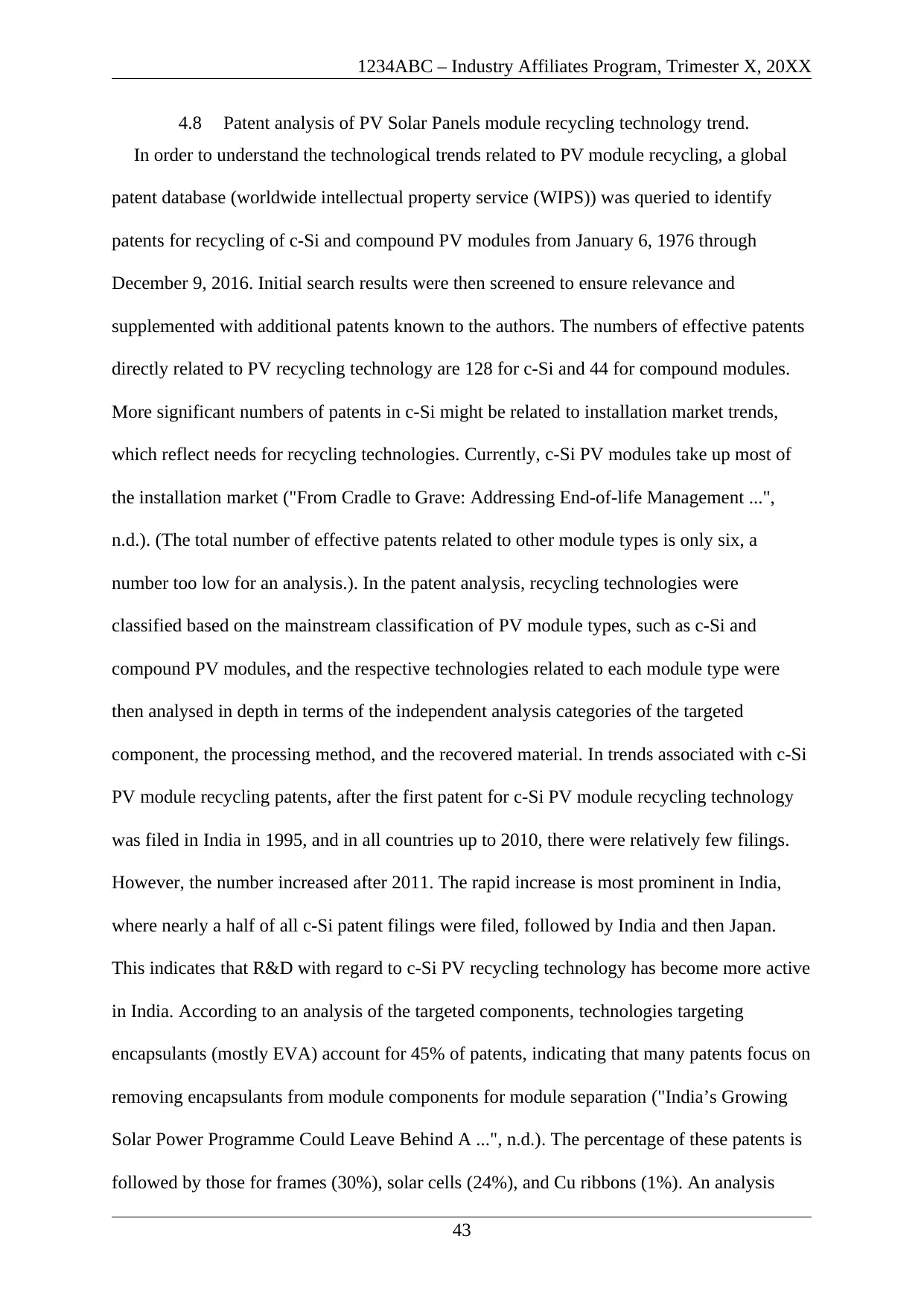
1234ABC – Industry Affiliates Program, Trimester X, 20XX
4.8 Patent analysis of PV Solar Panels module recycling technology trend.
In order to understand the technological trends related to PV module recycling, a global
patent database (worldwide intellectual property service (WIPS)) was queried to identify
patents for recycling of c-Si and compound PV modules from January 6, 1976 through
December 9, 2016. Initial search results were then screened to ensure relevance and
supplemented with additional patents known to the authors. The numbers of effective patents
directly related to PV recycling technology are 128 for c-Si and 44 for compound modules.
More significant numbers of patents in c-Si might be related to installation market trends,
which reflect needs for recycling technologies. Currently, c-Si PV modules take up most of
the installation market ("From Cradle to Grave: Addressing End-of-life Management ...",
n.d.). (The total number of effective patents related to other module types is only six, a
number too low for an analysis.). In the patent analysis, recycling technologies were
classified based on the mainstream classification of PV module types, such as c-Si and
compound PV modules, and the respective technologies related to each module type were
then analysed in depth in terms of the independent analysis categories of the targeted
component, the processing method, and the recovered material. In trends associated with c-Si
PV module recycling patents, after the first patent for c-Si PV module recycling technology
was filed in India in 1995, and in all countries up to 2010, there were relatively few filings.
However, the number increased after 2011. The rapid increase is most prominent in India,
where nearly a half of all c-Si patent filings were filed, followed by India and then Japan.
This indicates that R&D with regard to c-Si PV recycling technology has become more active
in India. According to an analysis of the targeted components, technologies targeting
encapsulants (mostly EVA) account for 45% of patents, indicating that many patents focus on
removing encapsulants from module components for module separation ("India’s Growing
Solar Power Programme Could Leave Behind A ...", n.d.). The percentage of these patents is
followed by those for frames (30%), solar cells (24%), and Cu ribbons (1%). An analysis
43
4.8 Patent analysis of PV Solar Panels module recycling technology trend.
In order to understand the technological trends related to PV module recycling, a global
patent database (worldwide intellectual property service (WIPS)) was queried to identify
patents for recycling of c-Si and compound PV modules from January 6, 1976 through
December 9, 2016. Initial search results were then screened to ensure relevance and
supplemented with additional patents known to the authors. The numbers of effective patents
directly related to PV recycling technology are 128 for c-Si and 44 for compound modules.
More significant numbers of patents in c-Si might be related to installation market trends,
which reflect needs for recycling technologies. Currently, c-Si PV modules take up most of
the installation market ("From Cradle to Grave: Addressing End-of-life Management ...",
n.d.). (The total number of effective patents related to other module types is only six, a
number too low for an analysis.). In the patent analysis, recycling technologies were
classified based on the mainstream classification of PV module types, such as c-Si and
compound PV modules, and the respective technologies related to each module type were
then analysed in depth in terms of the independent analysis categories of the targeted
component, the processing method, and the recovered material. In trends associated with c-Si
PV module recycling patents, after the first patent for c-Si PV module recycling technology
was filed in India in 1995, and in all countries up to 2010, there were relatively few filings.
However, the number increased after 2011. The rapid increase is most prominent in India,
where nearly a half of all c-Si patent filings were filed, followed by India and then Japan.
This indicates that R&D with regard to c-Si PV recycling technology has become more active
in India. According to an analysis of the targeted components, technologies targeting
encapsulants (mostly EVA) account for 45% of patents, indicating that many patents focus on
removing encapsulants from module components for module separation ("India’s Growing
Solar Power Programme Could Leave Behind A ...", n.d.). The percentage of these patents is
followed by those for frames (30%), solar cells (24%), and Cu ribbons (1%). An analysis
43
Paraphrase This Document
Need a fresh take? Get an instant paraphrase of this document with our AI Paraphraser
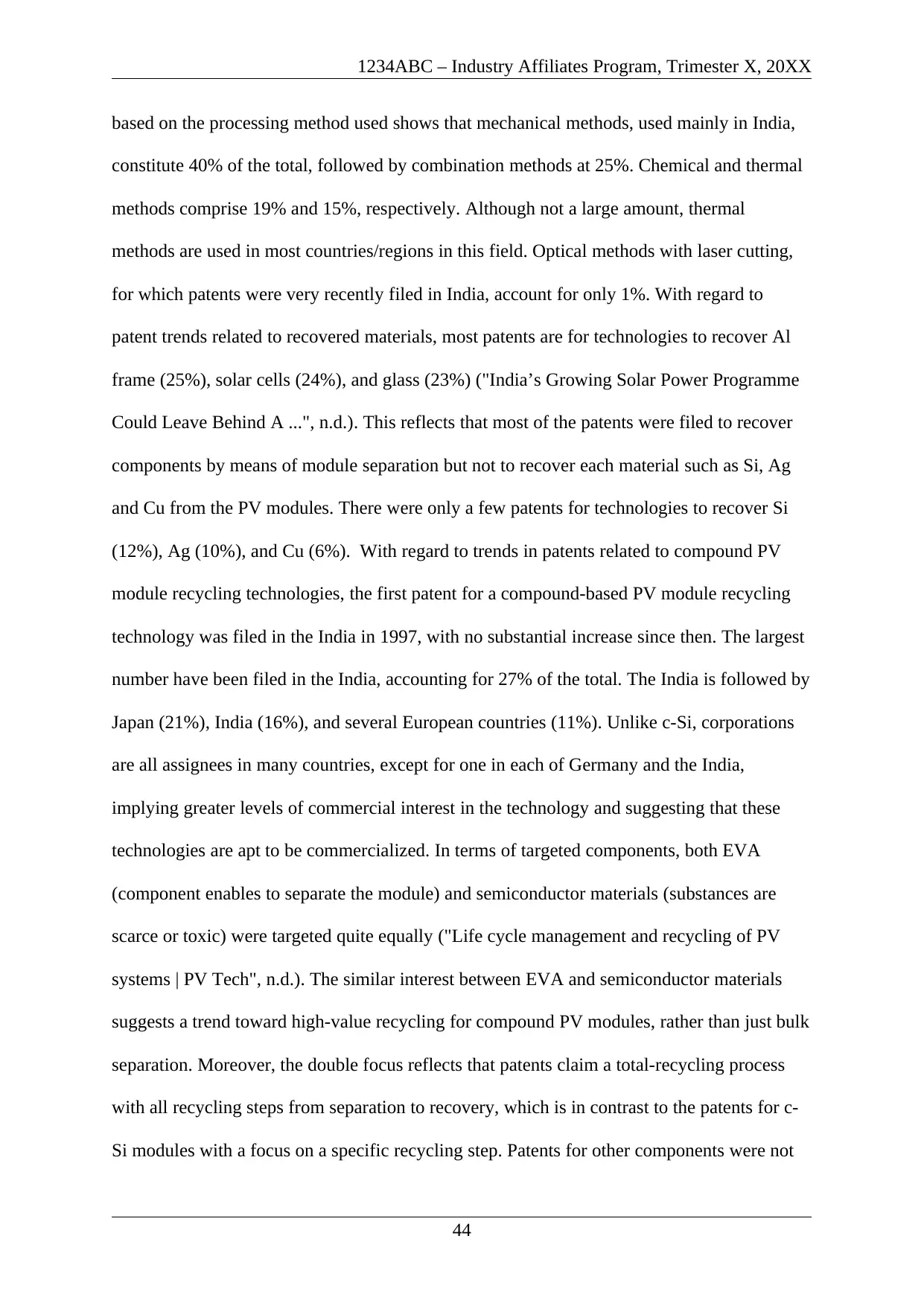
1234ABC – Industry Affiliates Program, Trimester X, 20XX
based on the processing method used shows that mechanical methods, used mainly in India,
constitute 40% of the total, followed by combination methods at 25%. Chemical and thermal
methods comprise 19% and 15%, respectively. Although not a large amount, thermal
methods are used in most countries/regions in this field. Optical methods with laser cutting,
for which patents were very recently filed in India, account for only 1%. With regard to
patent trends related to recovered materials, most patents are for technologies to recover Al
frame (25%), solar cells (24%), and glass (23%) ("India’s Growing Solar Power Programme
Could Leave Behind A ...", n.d.). This reflects that most of the patents were filed to recover
components by means of module separation but not to recover each material such as Si, Ag
and Cu from the PV modules. There were only a few patents for technologies to recover Si
(12%), Ag (10%), and Cu (6%). With regard to trends in patents related to compound PV
module recycling technologies, the first patent for a compound-based PV module recycling
technology was filed in the India in 1997, with no substantial increase since then. The largest
number have been filed in the India, accounting for 27% of the total. The India is followed by
Japan (21%), India (16%), and several European countries (11%). Unlike c-Si, corporations
are all assignees in many countries, except for one in each of Germany and the India,
implying greater levels of commercial interest in the technology and suggesting that these
technologies are apt to be commercialized. In terms of targeted components, both EVA
(component enables to separate the module) and semiconductor materials (substances are
scarce or toxic) were targeted quite equally ("Life cycle management and recycling of PV
systems | PV Tech", n.d.). The similar interest between EVA and semiconductor materials
suggests a trend toward high-value recycling for compound PV modules, rather than just bulk
separation. Moreover, the double focus reflects that patents claim a total-recycling process
with all recycling steps from separation to recovery, which is in contrast to the patents for c-
Si modules with a focus on a specific recycling step. Patents for other components were not
44
based on the processing method used shows that mechanical methods, used mainly in India,
constitute 40% of the total, followed by combination methods at 25%. Chemical and thermal
methods comprise 19% and 15%, respectively. Although not a large amount, thermal
methods are used in most countries/regions in this field. Optical methods with laser cutting,
for which patents were very recently filed in India, account for only 1%. With regard to
patent trends related to recovered materials, most patents are for technologies to recover Al
frame (25%), solar cells (24%), and glass (23%) ("India’s Growing Solar Power Programme
Could Leave Behind A ...", n.d.). This reflects that most of the patents were filed to recover
components by means of module separation but not to recover each material such as Si, Ag
and Cu from the PV modules. There were only a few patents for technologies to recover Si
(12%), Ag (10%), and Cu (6%). With regard to trends in patents related to compound PV
module recycling technologies, the first patent for a compound-based PV module recycling
technology was filed in the India in 1997, with no substantial increase since then. The largest
number have been filed in the India, accounting for 27% of the total. The India is followed by
Japan (21%), India (16%), and several European countries (11%). Unlike c-Si, corporations
are all assignees in many countries, except for one in each of Germany and the India,
implying greater levels of commercial interest in the technology and suggesting that these
technologies are apt to be commercialized. In terms of targeted components, both EVA
(component enables to separate the module) and semiconductor materials (substances are
scarce or toxic) were targeted quite equally ("Life cycle management and recycling of PV
systems | PV Tech", n.d.). The similar interest between EVA and semiconductor materials
suggests a trend toward high-value recycling for compound PV modules, rather than just bulk
separation. Moreover, the double focus reflects that patents claim a total-recycling process
with all recycling steps from separation to recovery, which is in contrast to the patents for c-
Si modules with a focus on a specific recycling step. Patents for other components were not
44
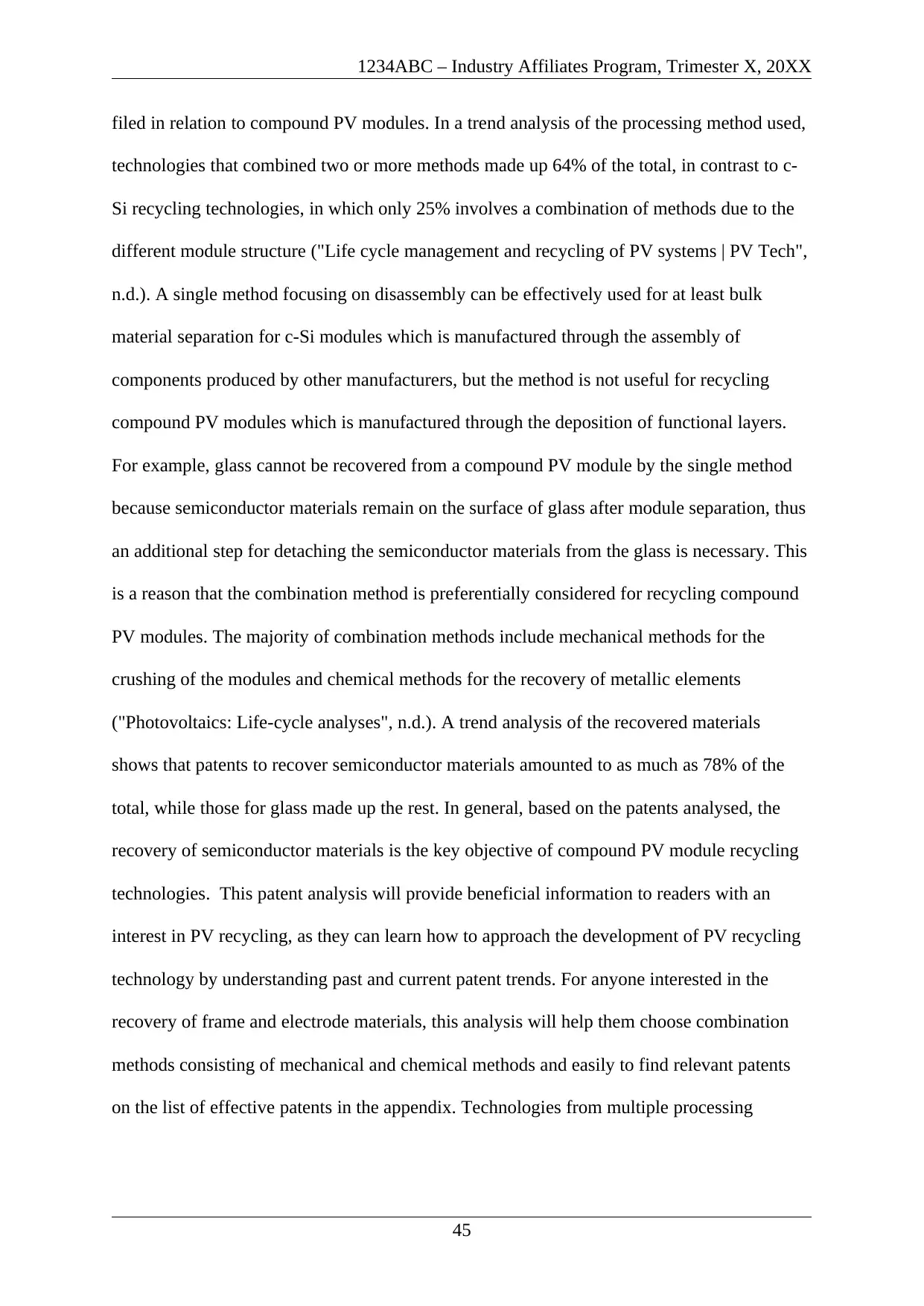
1234ABC – Industry Affiliates Program, Trimester X, 20XX
filed in relation to compound PV modules. In a trend analysis of the processing method used,
technologies that combined two or more methods made up 64% of the total, in contrast to c-
Si recycling technologies, in which only 25% involves a combination of methods due to the
different module structure ("Life cycle management and recycling of PV systems | PV Tech",
n.d.). A single method focusing on disassembly can be effectively used for at least bulk
material separation for c-Si modules which is manufactured through the assembly of
components produced by other manufacturers, but the method is not useful for recycling
compound PV modules which is manufactured through the deposition of functional layers.
For example, glass cannot be recovered from a compound PV module by the single method
because semiconductor materials remain on the surface of glass after module separation, thus
an additional step for detaching the semiconductor materials from the glass is necessary. This
is a reason that the combination method is preferentially considered for recycling compound
PV modules. The majority of combination methods include mechanical methods for the
crushing of the modules and chemical methods for the recovery of metallic elements
("Photovoltaics: Life-cycle analyses", n.d.). A trend analysis of the recovered materials
shows that patents to recover semiconductor materials amounted to as much as 78% of the
total, while those for glass made up the rest. In general, based on the patents analysed, the
recovery of semiconductor materials is the key objective of compound PV module recycling
technologies. This patent analysis will provide beneficial information to readers with an
interest in PV recycling, as they can learn how to approach the development of PV recycling
technology by understanding past and current patent trends. For anyone interested in the
recovery of frame and electrode materials, this analysis will help them choose combination
methods consisting of mechanical and chemical methods and easily to find relevant patents
on the list of effective patents in the appendix. Technologies from multiple processing
45
filed in relation to compound PV modules. In a trend analysis of the processing method used,
technologies that combined two or more methods made up 64% of the total, in contrast to c-
Si recycling technologies, in which only 25% involves a combination of methods due to the
different module structure ("Life cycle management and recycling of PV systems | PV Tech",
n.d.). A single method focusing on disassembly can be effectively used for at least bulk
material separation for c-Si modules which is manufactured through the assembly of
components produced by other manufacturers, but the method is not useful for recycling
compound PV modules which is manufactured through the deposition of functional layers.
For example, glass cannot be recovered from a compound PV module by the single method
because semiconductor materials remain on the surface of glass after module separation, thus
an additional step for detaching the semiconductor materials from the glass is necessary. This
is a reason that the combination method is preferentially considered for recycling compound
PV modules. The majority of combination methods include mechanical methods for the
crushing of the modules and chemical methods for the recovery of metallic elements
("Photovoltaics: Life-cycle analyses", n.d.). A trend analysis of the recovered materials
shows that patents to recover semiconductor materials amounted to as much as 78% of the
total, while those for glass made up the rest. In general, based on the patents analysed, the
recovery of semiconductor materials is the key objective of compound PV module recycling
technologies. This patent analysis will provide beneficial information to readers with an
interest in PV recycling, as they can learn how to approach the development of PV recycling
technology by understanding past and current patent trends. For anyone interested in the
recovery of frame and electrode materials, this analysis will help them choose combination
methods consisting of mechanical and chemical methods and easily to find relevant patents
on the list of effective patents in the appendix. Technologies from multiple processing
45
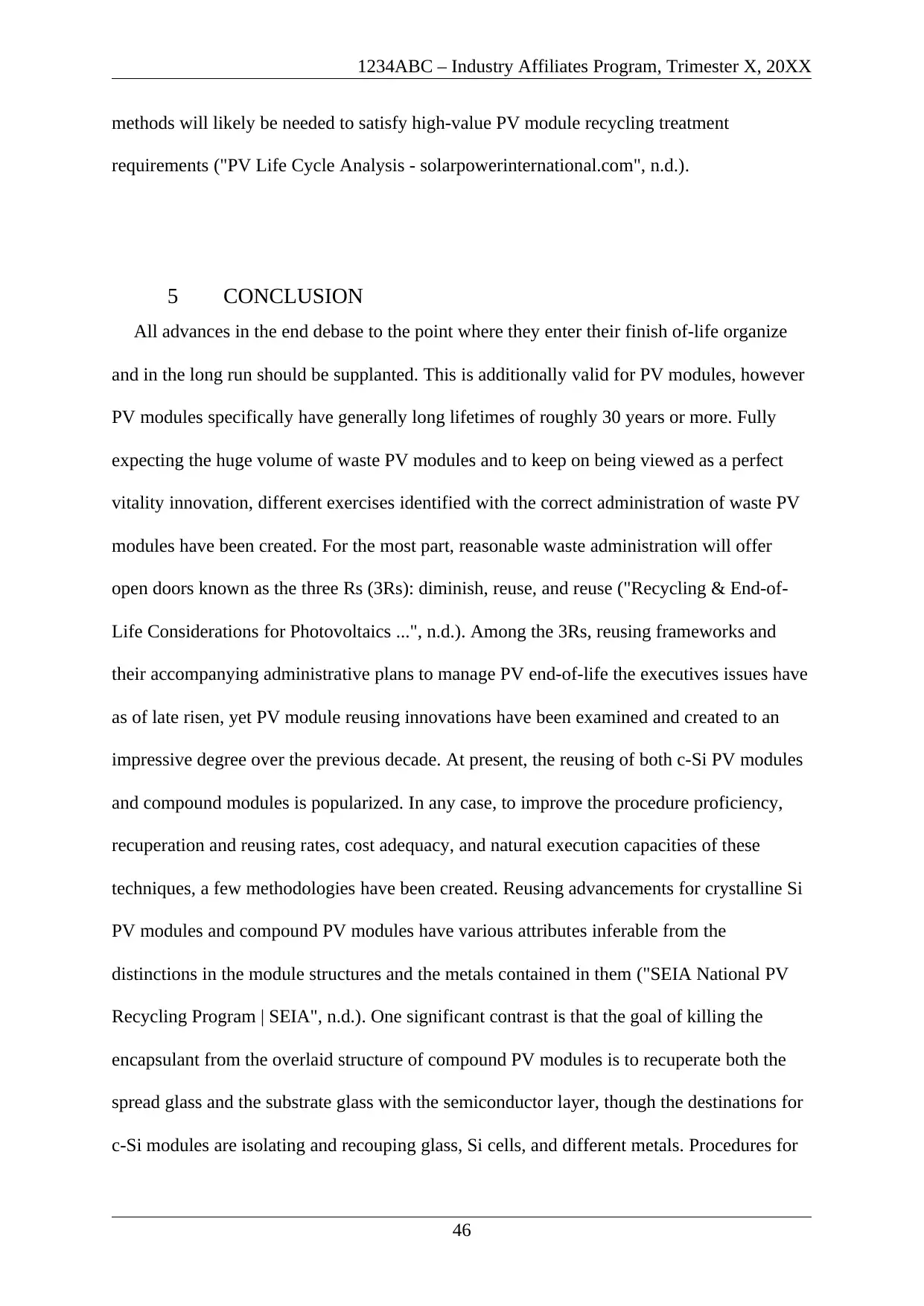
1234ABC – Industry Affiliates Program, Trimester X, 20XX
methods will likely be needed to satisfy high-value PV module recycling treatment
requirements ("PV Life Cycle Analysis - solarpowerinternational.com", n.d.).
5 CONCLUSION
All advances in the end debase to the point where they enter their finish of-life organize
and in the long run should be supplanted. This is additionally valid for PV modules, however
PV modules specifically have generally long lifetimes of roughly 30 years or more. Fully
expecting the huge volume of waste PV modules and to keep on being viewed as a perfect
vitality innovation, different exercises identified with the correct administration of waste PV
modules have been created. For the most part, reasonable waste administration will offer
open doors known as the three Rs (3Rs): diminish, reuse, and reuse ("Recycling & End-of-
Life Considerations for Photovoltaics ...", n.d.). Among the 3Rs, reusing frameworks and
their accompanying administrative plans to manage PV end-of-life the executives issues have
as of late risen, yet PV module reusing innovations have been examined and created to an
impressive degree over the previous decade. At present, the reusing of both c-Si PV modules
and compound modules is popularized. In any case, to improve the procedure proficiency,
recuperation and reusing rates, cost adequacy, and natural execution capacities of these
techniques, a few methodologies have been created. Reusing advancements for crystalline Si
PV modules and compound PV modules have various attributes inferable from the
distinctions in the module structures and the metals contained in them ("SEIA National PV
Recycling Program | SEIA", n.d.). One significant contrast is that the goal of killing the
encapsulant from the overlaid structure of compound PV modules is to recuperate both the
spread glass and the substrate glass with the semiconductor layer, though the destinations for
c-Si modules are isolating and recouping glass, Si cells, and different metals. Procedures for
46
methods will likely be needed to satisfy high-value PV module recycling treatment
requirements ("PV Life Cycle Analysis - solarpowerinternational.com", n.d.).
5 CONCLUSION
All advances in the end debase to the point where they enter their finish of-life organize
and in the long run should be supplanted. This is additionally valid for PV modules, however
PV modules specifically have generally long lifetimes of roughly 30 years or more. Fully
expecting the huge volume of waste PV modules and to keep on being viewed as a perfect
vitality innovation, different exercises identified with the correct administration of waste PV
modules have been created. For the most part, reasonable waste administration will offer
open doors known as the three Rs (3Rs): diminish, reuse, and reuse ("Recycling & End-of-
Life Considerations for Photovoltaics ...", n.d.). Among the 3Rs, reusing frameworks and
their accompanying administrative plans to manage PV end-of-life the executives issues have
as of late risen, yet PV module reusing innovations have been examined and created to an
impressive degree over the previous decade. At present, the reusing of both c-Si PV modules
and compound modules is popularized. In any case, to improve the procedure proficiency,
recuperation and reusing rates, cost adequacy, and natural execution capacities of these
techniques, a few methodologies have been created. Reusing advancements for crystalline Si
PV modules and compound PV modules have various attributes inferable from the
distinctions in the module structures and the metals contained in them ("SEIA National PV
Recycling Program | SEIA", n.d.). One significant contrast is that the goal of killing the
encapsulant from the overlaid structure of compound PV modules is to recuperate both the
spread glass and the substrate glass with the semiconductor layer, though the destinations for
c-Si modules are isolating and recouping glass, Si cells, and different metals. Procedures for
46
Secure Best Marks with AI Grader
Need help grading? Try our AI Grader for instant feedback on your assignments.
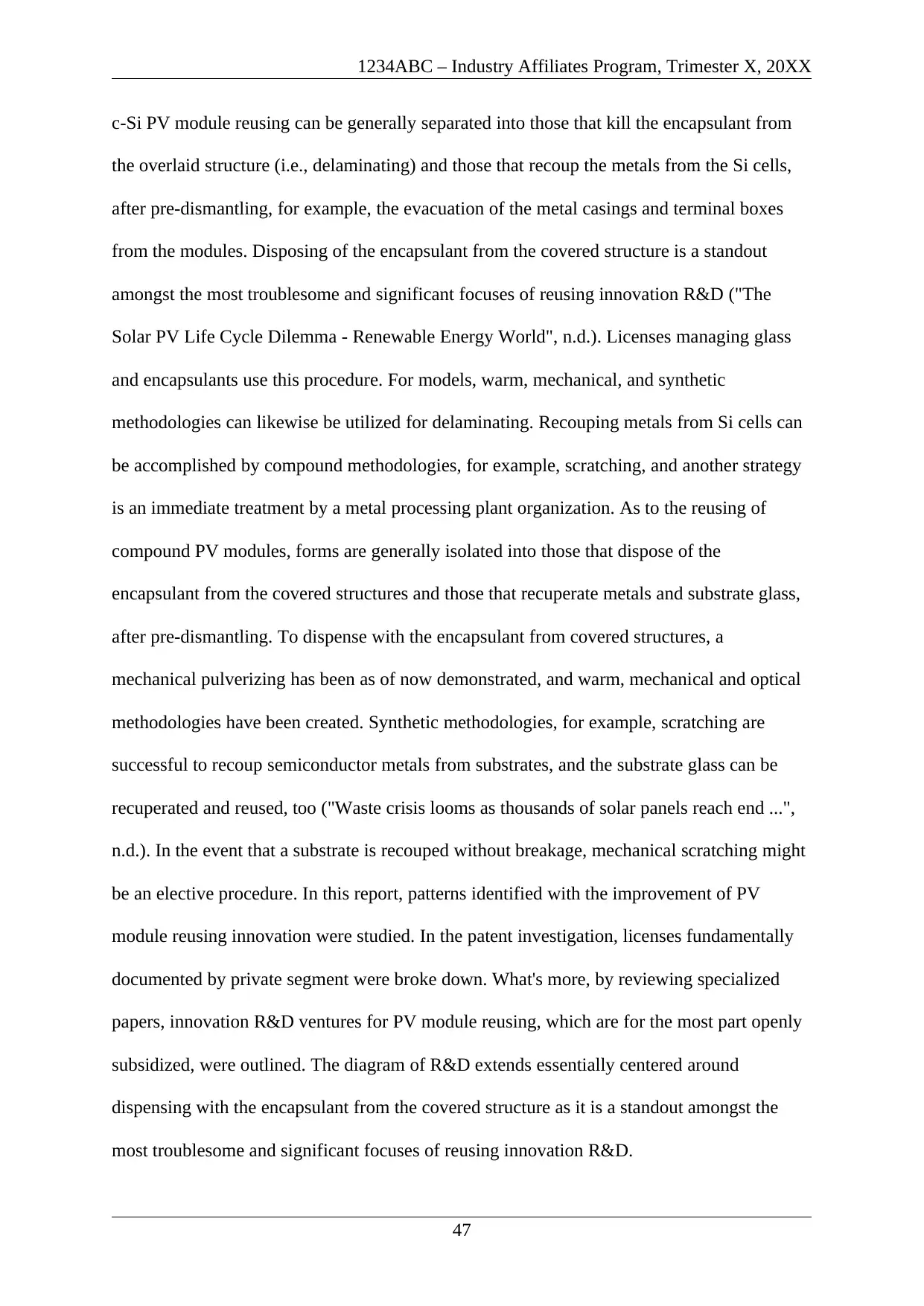
1234ABC – Industry Affiliates Program, Trimester X, 20XX
c-Si PV module reusing can be generally separated into those that kill the encapsulant from
the overlaid structure (i.e., delaminating) and those that recoup the metals from the Si cells,
after pre-dismantling, for example, the evacuation of the metal casings and terminal boxes
from the modules. Disposing of the encapsulant from the covered structure is a standout
amongst the most troublesome and significant focuses of reusing innovation R&D ("The
Solar PV Life Cycle Dilemma - Renewable Energy World", n.d.). Licenses managing glass
and encapsulants use this procedure. For models, warm, mechanical, and synthetic
methodologies can likewise be utilized for delaminating. Recouping metals from Si cells can
be accomplished by compound methodologies, for example, scratching, and another strategy
is an immediate treatment by a metal processing plant organization. As to the reusing of
compound PV modules, forms are generally isolated into those that dispose of the
encapsulant from the covered structures and those that recuperate metals and substrate glass,
after pre-dismantling. To dispense with the encapsulant from covered structures, a
mechanical pulverizing has been as of now demonstrated, and warm, mechanical and optical
methodologies have been created. Synthetic methodologies, for example, scratching are
successful to recoup semiconductor metals from substrates, and the substrate glass can be
recuperated and reused, too ("Waste crisis looms as thousands of solar panels reach end ...",
n.d.). In the event that a substrate is recouped without breakage, mechanical scratching might
be an elective procedure. In this report, patterns identified with the improvement of PV
module reusing innovation were studied. In the patent investigation, licenses fundamentally
documented by private segment were broke down. What's more, by reviewing specialized
papers, innovation R&D ventures for PV module reusing, which are for the most part openly
subsidized, were outlined. The diagram of R&D extends essentially centered around
dispensing with the encapsulant from the covered structure as it is a standout amongst the
most troublesome and significant focuses of reusing innovation R&D.
47
c-Si PV module reusing can be generally separated into those that kill the encapsulant from
the overlaid structure (i.e., delaminating) and those that recoup the metals from the Si cells,
after pre-dismantling, for example, the evacuation of the metal casings and terminal boxes
from the modules. Disposing of the encapsulant from the covered structure is a standout
amongst the most troublesome and significant focuses of reusing innovation R&D ("The
Solar PV Life Cycle Dilemma - Renewable Energy World", n.d.). Licenses managing glass
and encapsulants use this procedure. For models, warm, mechanical, and synthetic
methodologies can likewise be utilized for delaminating. Recouping metals from Si cells can
be accomplished by compound methodologies, for example, scratching, and another strategy
is an immediate treatment by a metal processing plant organization. As to the reusing of
compound PV modules, forms are generally isolated into those that dispose of the
encapsulant from the covered structures and those that recuperate metals and substrate glass,
after pre-dismantling. To dispense with the encapsulant from covered structures, a
mechanical pulverizing has been as of now demonstrated, and warm, mechanical and optical
methodologies have been created. Synthetic methodologies, for example, scratching are
successful to recoup semiconductor metals from substrates, and the substrate glass can be
recuperated and reused, too ("Waste crisis looms as thousands of solar panels reach end ...",
n.d.). In the event that a substrate is recouped without breakage, mechanical scratching might
be an elective procedure. In this report, patterns identified with the improvement of PV
module reusing innovation were studied. In the patent investigation, licenses fundamentally
documented by private segment were broke down. What's more, by reviewing specialized
papers, innovation R&D ventures for PV module reusing, which are for the most part openly
subsidized, were outlined. The diagram of R&D extends essentially centered around
dispensing with the encapsulant from the covered structure as it is a standout amongst the
most troublesome and significant focuses of reusing innovation R&D.
47
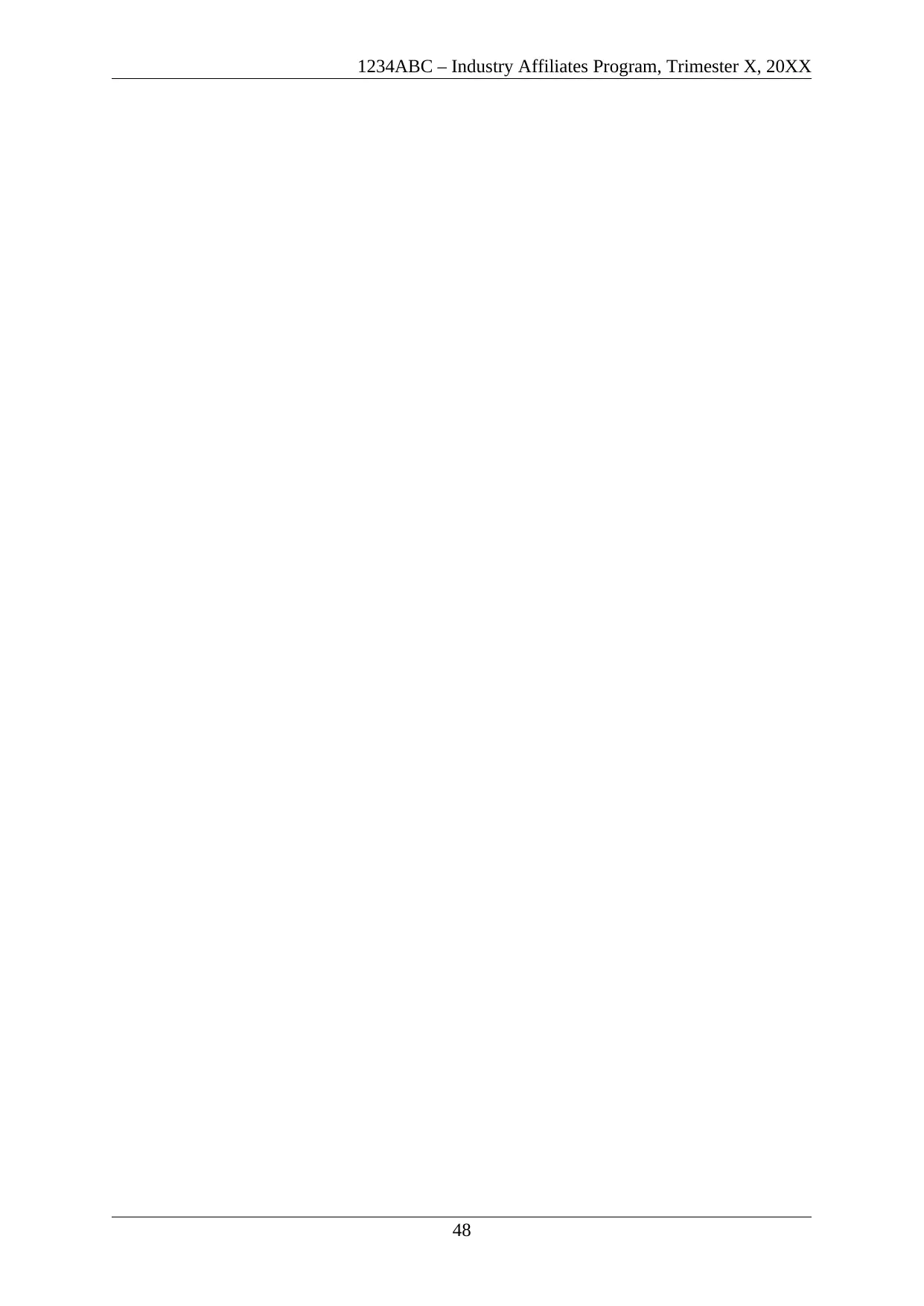
1234ABC – Industry Affiliates Program, Trimester X, 20XX
48
48
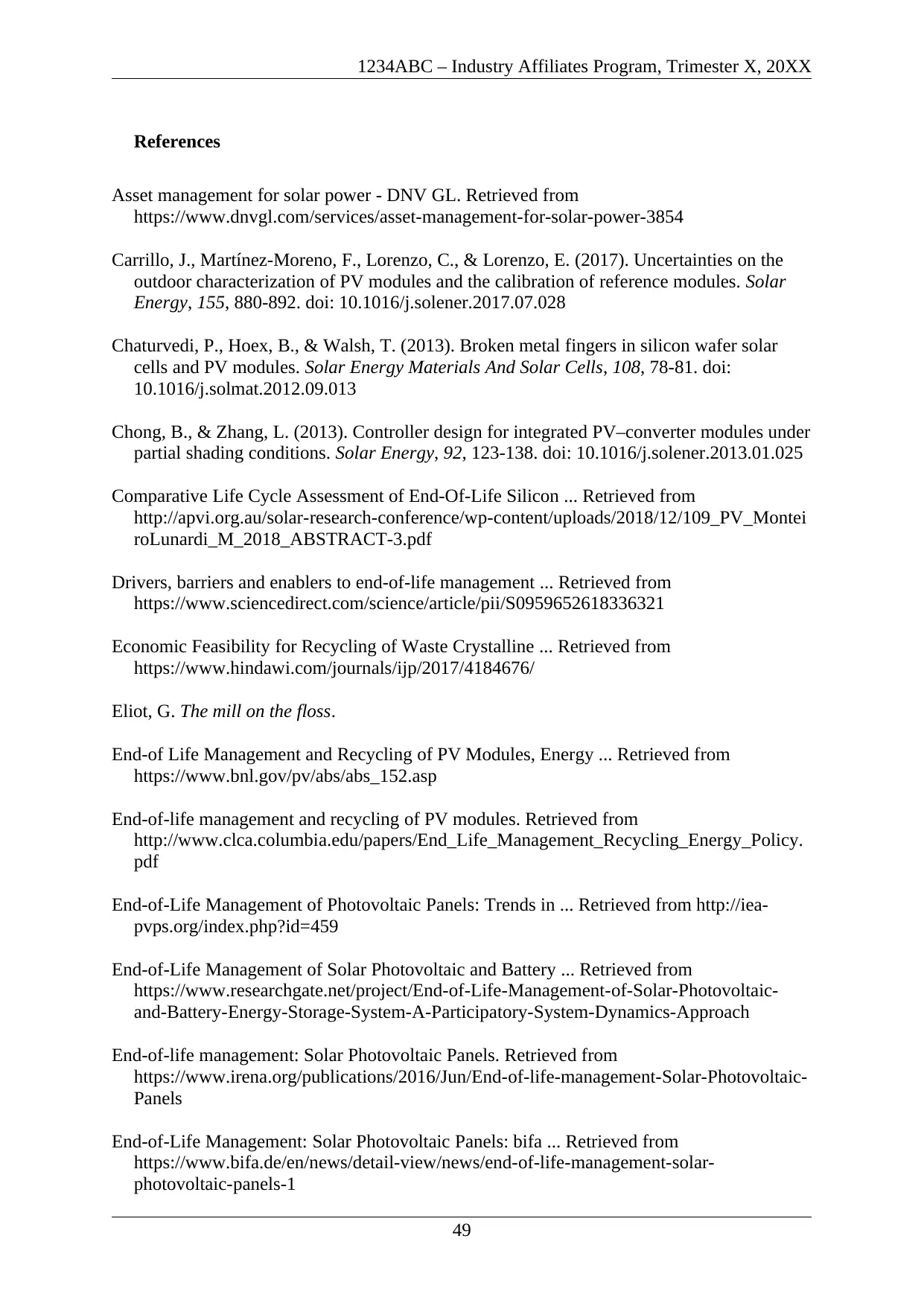
1234ABC – Industry Affiliates Program, Trimester X, 20XX
References
Asset management for solar power - DNV GL. Retrieved from
https://www.dnvgl.com/services/asset-management-for-solar-power-3854
Carrillo, J., Martínez-Moreno, F., Lorenzo, C., & Lorenzo, E. (2017). Uncertainties on the
outdoor characterization of PV modules and the calibration of reference modules. Solar
Energy, 155, 880-892. doi: 10.1016/j.solener.2017.07.028
Chaturvedi, P., Hoex, B., & Walsh, T. (2013). Broken metal fingers in silicon wafer solar
cells and PV modules. Solar Energy Materials And Solar Cells, 108, 78-81. doi:
10.1016/j.solmat.2012.09.013
Chong, B., & Zhang, L. (2013). Controller design for integrated PV–converter modules under
partial shading conditions. Solar Energy, 92, 123-138. doi: 10.1016/j.solener.2013.01.025
Comparative Life Cycle Assessment of End-Of-Life Silicon ... Retrieved from
http://apvi.org.au/solar-research-conference/wp-content/uploads/2018/12/109_PV_Montei
roLunardi_M_2018_ABSTRACT-3.pdf
Drivers, barriers and enablers to end-of-life management ... Retrieved from
https://www.sciencedirect.com/science/article/pii/S0959652618336321
Economic Feasibility for Recycling of Waste Crystalline ... Retrieved from
https://www.hindawi.com/journals/ijp/2017/4184676/
Eliot, G. The mill on the floss.
End-of Life Management and Recycling of PV Modules, Energy ... Retrieved from
https://www.bnl.gov/pv/abs/abs_152.asp
End-of-life management and recycling of PV modules. Retrieved from
http://www.clca.columbia.edu/papers/End_Life_Management_Recycling_Energy_Policy.
pdf
End‐of‐Life Management of Photovoltaic Panels: Trends in ... Retrieved from http://iea-
pvps.org/index.php?id=459
End-of-Life Management of Solar Photovoltaic and Battery ... Retrieved from
https://www.researchgate.net/project/End-of-Life-Management-of-Solar-Photovoltaic-
and-Battery-Energy-Storage-System-A-Participatory-System-Dynamics-Approach
End-of-life management: Solar Photovoltaic Panels. Retrieved from
https://www.irena.org/publications/2016/Jun/End-of-life-management-Solar-Photovoltaic-
Panels
End-of-Life Management: Solar Photovoltaic Panels: bifa ... Retrieved from
https://www.bifa.de/en/news/detail-view/news/end-of-life-management-solar-
photovoltaic-panels-1
49
References
Asset management for solar power - DNV GL. Retrieved from
https://www.dnvgl.com/services/asset-management-for-solar-power-3854
Carrillo, J., Martínez-Moreno, F., Lorenzo, C., & Lorenzo, E. (2017). Uncertainties on the
outdoor characterization of PV modules and the calibration of reference modules. Solar
Energy, 155, 880-892. doi: 10.1016/j.solener.2017.07.028
Chaturvedi, P., Hoex, B., & Walsh, T. (2013). Broken metal fingers in silicon wafer solar
cells and PV modules. Solar Energy Materials And Solar Cells, 108, 78-81. doi:
10.1016/j.solmat.2012.09.013
Chong, B., & Zhang, L. (2013). Controller design for integrated PV–converter modules under
partial shading conditions. Solar Energy, 92, 123-138. doi: 10.1016/j.solener.2013.01.025
Comparative Life Cycle Assessment of End-Of-Life Silicon ... Retrieved from
http://apvi.org.au/solar-research-conference/wp-content/uploads/2018/12/109_PV_Montei
roLunardi_M_2018_ABSTRACT-3.pdf
Drivers, barriers and enablers to end-of-life management ... Retrieved from
https://www.sciencedirect.com/science/article/pii/S0959652618336321
Economic Feasibility for Recycling of Waste Crystalline ... Retrieved from
https://www.hindawi.com/journals/ijp/2017/4184676/
Eliot, G. The mill on the floss.
End-of Life Management and Recycling of PV Modules, Energy ... Retrieved from
https://www.bnl.gov/pv/abs/abs_152.asp
End-of-life management and recycling of PV modules. Retrieved from
http://www.clca.columbia.edu/papers/End_Life_Management_Recycling_Energy_Policy.
End‐of‐Life Management of Photovoltaic Panels: Trends in ... Retrieved from http://iea-
pvps.org/index.php?id=459
End-of-Life Management of Solar Photovoltaic and Battery ... Retrieved from
https://www.researchgate.net/project/End-of-Life-Management-of-Solar-Photovoltaic-
and-Battery-Energy-Storage-System-A-Participatory-System-Dynamics-Approach
End-of-life management: Solar Photovoltaic Panels. Retrieved from
https://www.irena.org/publications/2016/Jun/End-of-life-management-Solar-Photovoltaic-
Panels
End-of-Life Management: Solar Photovoltaic Panels: bifa ... Retrieved from
https://www.bifa.de/en/news/detail-view/news/end-of-life-management-solar-
photovoltaic-panels-1
49
Paraphrase This Document
Need a fresh take? Get an instant paraphrase of this document with our AI Paraphraser
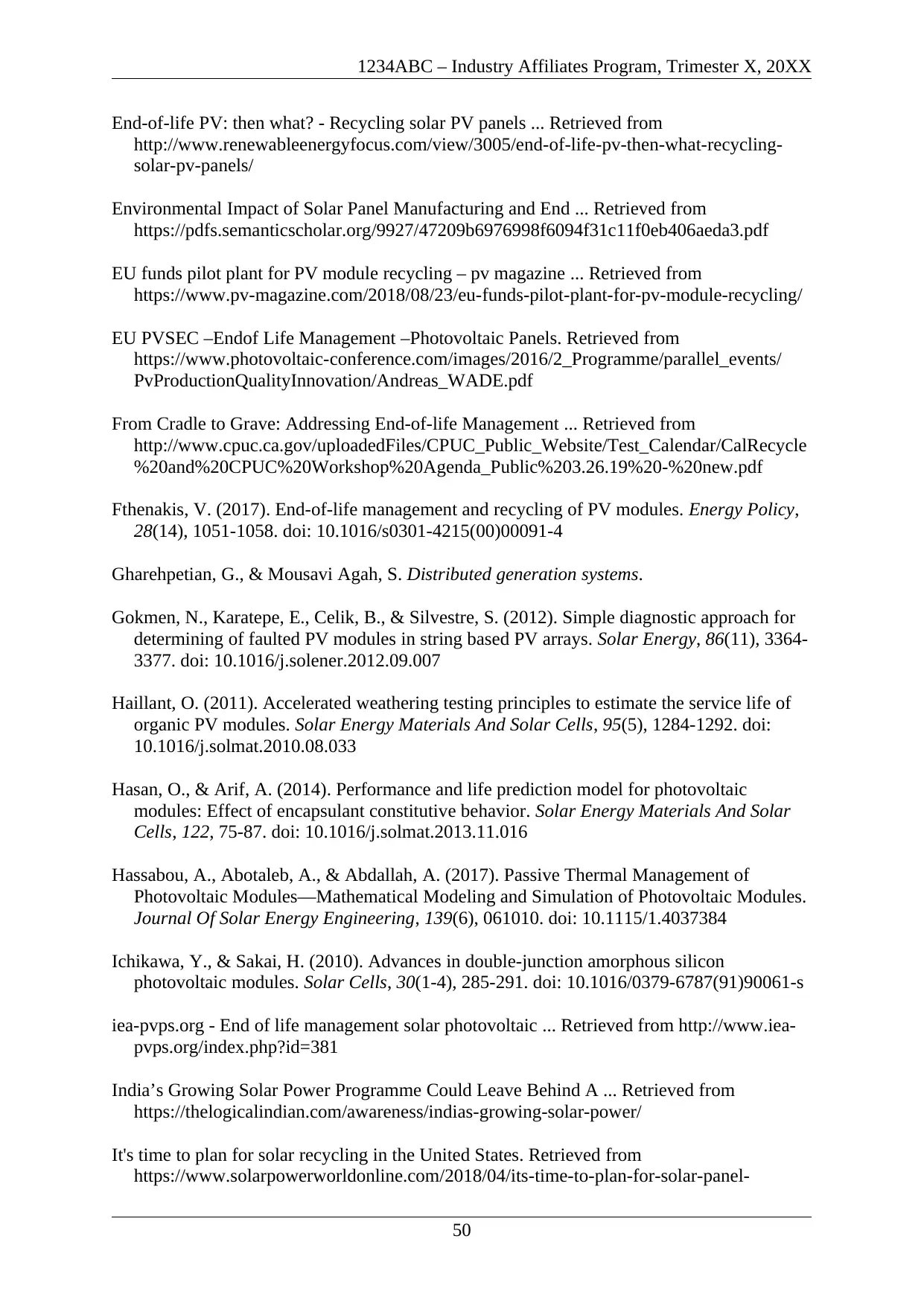
1234ABC – Industry Affiliates Program, Trimester X, 20XX
End-of-life PV: then what? - Recycling solar PV panels ... Retrieved from
http://www.renewableenergyfocus.com/view/3005/end-of-life-pv-then-what-recycling-
solar-pv-panels/
Environmental Impact of Solar Panel Manufacturing and End ... Retrieved from
https://pdfs.semanticscholar.org/9927/47209b6976998f6094f31c11f0eb406aeda3.pdf
EU funds pilot plant for PV module recycling – pv magazine ... Retrieved from
https://www.pv-magazine.com/2018/08/23/eu-funds-pilot-plant-for-pv-module-recycling/
EU PVSEC –Endof Life Management –Photovoltaic Panels. Retrieved from
https://www.photovoltaic-conference.com/images/2016/2_Programme/parallel_events/
PvProductionQualityInnovation/Andreas_WADE.pdf
From Cradle to Grave: Addressing End-of-life Management ... Retrieved from
http://www.cpuc.ca.gov/uploadedFiles/CPUC_Public_Website/Test_Calendar/CalRecycle
%20and%20CPUC%20Workshop%20Agenda_Public%203.26.19%20-%20new.pdf
Fthenakis, V. (2017). End-of-life management and recycling of PV modules. Energy Policy,
28(14), 1051-1058. doi: 10.1016/s0301-4215(00)00091-4
Gharehpetian, G., & Mousavi Agah, S. Distributed generation systems.
Gokmen, N., Karatepe, E., Celik, B., & Silvestre, S. (2012). Simple diagnostic approach for
determining of faulted PV modules in string based PV arrays. Solar Energy, 86(11), 3364-
3377. doi: 10.1016/j.solener.2012.09.007
Haillant, O. (2011). Accelerated weathering testing principles to estimate the service life of
organic PV modules. Solar Energy Materials And Solar Cells, 95(5), 1284-1292. doi:
10.1016/j.solmat.2010.08.033
Hasan, O., & Arif, A. (2014). Performance and life prediction model for photovoltaic
modules: Effect of encapsulant constitutive behavior. Solar Energy Materials And Solar
Cells, 122, 75-87. doi: 10.1016/j.solmat.2013.11.016
Hassabou, A., Abotaleb, A., & Abdallah, A. (2017). Passive Thermal Management of
Photovoltaic Modules—Mathematical Modeling and Simulation of Photovoltaic Modules.
Journal Of Solar Energy Engineering, 139(6), 061010. doi: 10.1115/1.4037384
Ichikawa, Y., & Sakai, H. (2010). Advances in double-junction amorphous silicon
photovoltaic modules. Solar Cells, 30(1-4), 285-291. doi: 10.1016/0379-6787(91)90061-s
iea-pvps.org - End of life management solar photovoltaic ... Retrieved from http://www.iea-
pvps.org/index.php?id=381
India’s Growing Solar Power Programme Could Leave Behind A ... Retrieved from
https://thelogicalindian.com/awareness/indias-growing-solar-power/
It's time to plan for solar recycling in the United States. Retrieved from
https://www.solarpowerworldonline.com/2018/04/its-time-to-plan-for-solar-panel-
50
End-of-life PV: then what? - Recycling solar PV panels ... Retrieved from
http://www.renewableenergyfocus.com/view/3005/end-of-life-pv-then-what-recycling-
solar-pv-panels/
Environmental Impact of Solar Panel Manufacturing and End ... Retrieved from
https://pdfs.semanticscholar.org/9927/47209b6976998f6094f31c11f0eb406aeda3.pdf
EU funds pilot plant for PV module recycling – pv magazine ... Retrieved from
https://www.pv-magazine.com/2018/08/23/eu-funds-pilot-plant-for-pv-module-recycling/
EU PVSEC –Endof Life Management –Photovoltaic Panels. Retrieved from
https://www.photovoltaic-conference.com/images/2016/2_Programme/parallel_events/
PvProductionQualityInnovation/Andreas_WADE.pdf
From Cradle to Grave: Addressing End-of-life Management ... Retrieved from
http://www.cpuc.ca.gov/uploadedFiles/CPUC_Public_Website/Test_Calendar/CalRecycle
%20and%20CPUC%20Workshop%20Agenda_Public%203.26.19%20-%20new.pdf
Fthenakis, V. (2017). End-of-life management and recycling of PV modules. Energy Policy,
28(14), 1051-1058. doi: 10.1016/s0301-4215(00)00091-4
Gharehpetian, G., & Mousavi Agah, S. Distributed generation systems.
Gokmen, N., Karatepe, E., Celik, B., & Silvestre, S. (2012). Simple diagnostic approach for
determining of faulted PV modules in string based PV arrays. Solar Energy, 86(11), 3364-
3377. doi: 10.1016/j.solener.2012.09.007
Haillant, O. (2011). Accelerated weathering testing principles to estimate the service life of
organic PV modules. Solar Energy Materials And Solar Cells, 95(5), 1284-1292. doi:
10.1016/j.solmat.2010.08.033
Hasan, O., & Arif, A. (2014). Performance and life prediction model for photovoltaic
modules: Effect of encapsulant constitutive behavior. Solar Energy Materials And Solar
Cells, 122, 75-87. doi: 10.1016/j.solmat.2013.11.016
Hassabou, A., Abotaleb, A., & Abdallah, A. (2017). Passive Thermal Management of
Photovoltaic Modules—Mathematical Modeling and Simulation of Photovoltaic Modules.
Journal Of Solar Energy Engineering, 139(6), 061010. doi: 10.1115/1.4037384
Ichikawa, Y., & Sakai, H. (2010). Advances in double-junction amorphous silicon
photovoltaic modules. Solar Cells, 30(1-4), 285-291. doi: 10.1016/0379-6787(91)90061-s
iea-pvps.org - End of life management solar photovoltaic ... Retrieved from http://www.iea-
pvps.org/index.php?id=381
India’s Growing Solar Power Programme Could Leave Behind A ... Retrieved from
https://thelogicalindian.com/awareness/indias-growing-solar-power/
It's time to plan for solar recycling in the United States. Retrieved from
https://www.solarpowerworldonline.com/2018/04/its-time-to-plan-for-solar-panel-
50
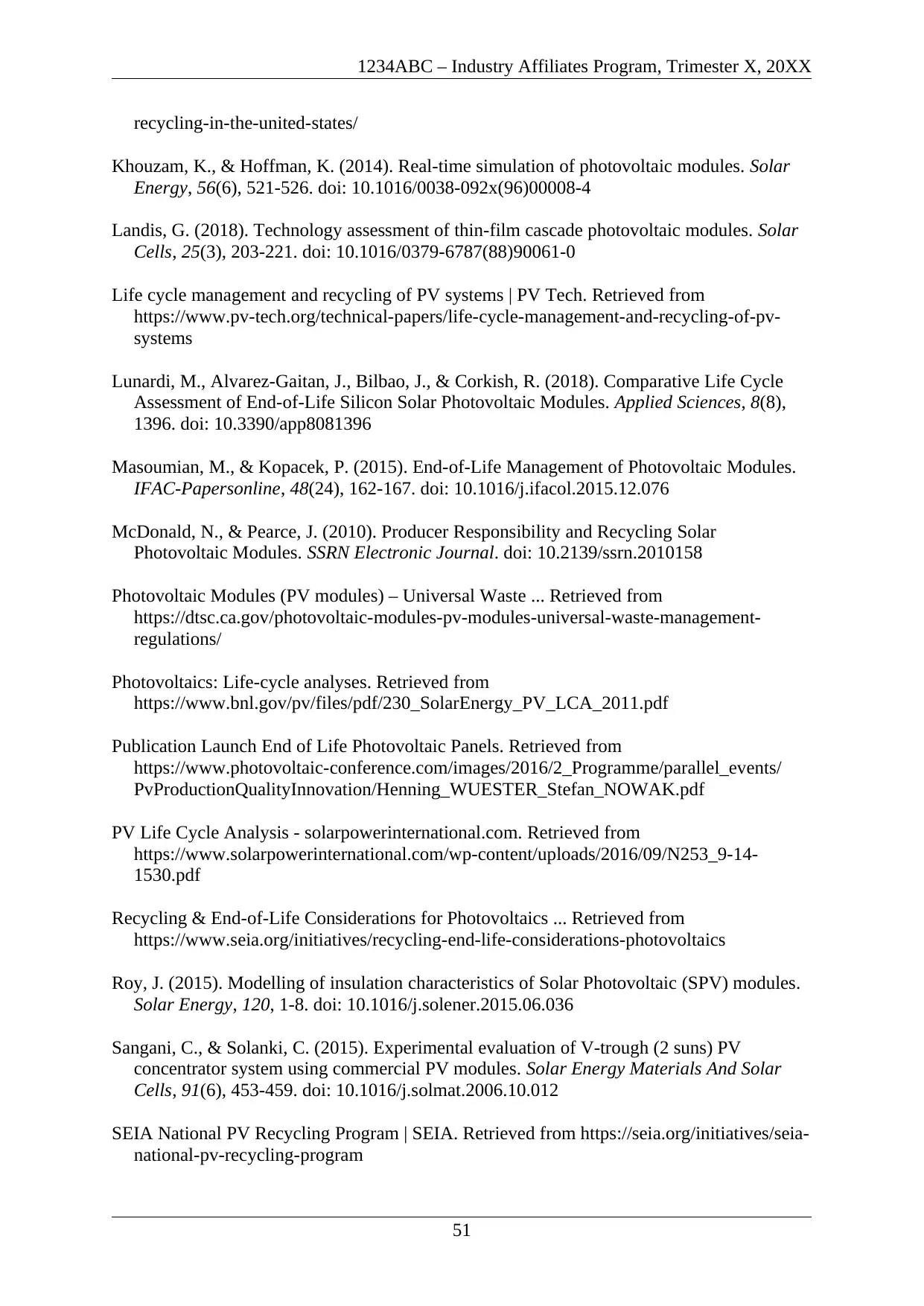
1234ABC – Industry Affiliates Program, Trimester X, 20XX
recycling-in-the-united-states/
Khouzam, K., & Hoffman, K. (2014). Real-time simulation of photovoltaic modules. Solar
Energy, 56(6), 521-526. doi: 10.1016/0038-092x(96)00008-4
Landis, G. (2018). Technology assessment of thin-film cascade photovoltaic modules. Solar
Cells, 25(3), 203-221. doi: 10.1016/0379-6787(88)90061-0
Life cycle management and recycling of PV systems | PV Tech. Retrieved from
https://www.pv-tech.org/technical-papers/life-cycle-management-and-recycling-of-pv-
systems
Lunardi, M., Alvarez-Gaitan, J., Bilbao, J., & Corkish, R. (2018). Comparative Life Cycle
Assessment of End-of-Life Silicon Solar Photovoltaic Modules. Applied Sciences, 8(8),
1396. doi: 10.3390/app8081396
Masoumian, M., & Kopacek, P. (2015). End-of-Life Management of Photovoltaic Modules.
IFAC-Papersonline, 48(24), 162-167. doi: 10.1016/j.ifacol.2015.12.076
McDonald, N., & Pearce, J. (2010). Producer Responsibility and Recycling Solar
Photovoltaic Modules. SSRN Electronic Journal. doi: 10.2139/ssrn.2010158
Photovoltaic Modules (PV modules) – Universal Waste ... Retrieved from
https://dtsc.ca.gov/photovoltaic-modules-pv-modules-universal-waste-management-
regulations/
Photovoltaics: Life-cycle analyses. Retrieved from
https://www.bnl.gov/pv/files/pdf/230_SolarEnergy_PV_LCA_2011.pdf
Publication Launch End of Life Photovoltaic Panels. Retrieved from
https://www.photovoltaic-conference.com/images/2016/2_Programme/parallel_events/
PvProductionQualityInnovation/Henning_WUESTER_Stefan_NOWAK.pdf
PV Life Cycle Analysis - solarpowerinternational.com. Retrieved from
https://www.solarpowerinternational.com/wp-content/uploads/2016/09/N253_9-14-
1530.pdf
Recycling & End-of-Life Considerations for Photovoltaics ... Retrieved from
https://www.seia.org/initiatives/recycling-end-life-considerations-photovoltaics
Roy, J. (2015). Modelling of insulation characteristics of Solar Photovoltaic (SPV) modules.
Solar Energy, 120, 1-8. doi: 10.1016/j.solener.2015.06.036
Sangani, C., & Solanki, C. (2015). Experimental evaluation of V-trough (2 suns) PV
concentrator system using commercial PV modules. Solar Energy Materials And Solar
Cells, 91(6), 453-459. doi: 10.1016/j.solmat.2006.10.012
SEIA National PV Recycling Program | SEIA. Retrieved from https://seia.org/initiatives/seia-
national-pv-recycling-program
51
recycling-in-the-united-states/
Khouzam, K., & Hoffman, K. (2014). Real-time simulation of photovoltaic modules. Solar
Energy, 56(6), 521-526. doi: 10.1016/0038-092x(96)00008-4
Landis, G. (2018). Technology assessment of thin-film cascade photovoltaic modules. Solar
Cells, 25(3), 203-221. doi: 10.1016/0379-6787(88)90061-0
Life cycle management and recycling of PV systems | PV Tech. Retrieved from
https://www.pv-tech.org/technical-papers/life-cycle-management-and-recycling-of-pv-
systems
Lunardi, M., Alvarez-Gaitan, J., Bilbao, J., & Corkish, R. (2018). Comparative Life Cycle
Assessment of End-of-Life Silicon Solar Photovoltaic Modules. Applied Sciences, 8(8),
1396. doi: 10.3390/app8081396
Masoumian, M., & Kopacek, P. (2015). End-of-Life Management of Photovoltaic Modules.
IFAC-Papersonline, 48(24), 162-167. doi: 10.1016/j.ifacol.2015.12.076
McDonald, N., & Pearce, J. (2010). Producer Responsibility and Recycling Solar
Photovoltaic Modules. SSRN Electronic Journal. doi: 10.2139/ssrn.2010158
Photovoltaic Modules (PV modules) – Universal Waste ... Retrieved from
https://dtsc.ca.gov/photovoltaic-modules-pv-modules-universal-waste-management-
regulations/
Photovoltaics: Life-cycle analyses. Retrieved from
https://www.bnl.gov/pv/files/pdf/230_SolarEnergy_PV_LCA_2011.pdf
Publication Launch End of Life Photovoltaic Panels. Retrieved from
https://www.photovoltaic-conference.com/images/2016/2_Programme/parallel_events/
PvProductionQualityInnovation/Henning_WUESTER_Stefan_NOWAK.pdf
PV Life Cycle Analysis - solarpowerinternational.com. Retrieved from
https://www.solarpowerinternational.com/wp-content/uploads/2016/09/N253_9-14-
1530.pdf
Recycling & End-of-Life Considerations for Photovoltaics ... Retrieved from
https://www.seia.org/initiatives/recycling-end-life-considerations-photovoltaics
Roy, J. (2015). Modelling of insulation characteristics of Solar Photovoltaic (SPV) modules.
Solar Energy, 120, 1-8. doi: 10.1016/j.solener.2015.06.036
Sangani, C., & Solanki, C. (2015). Experimental evaluation of V-trough (2 suns) PV
concentrator system using commercial PV modules. Solar Energy Materials And Solar
Cells, 91(6), 453-459. doi: 10.1016/j.solmat.2006.10.012
SEIA National PV Recycling Program | SEIA. Retrieved from https://seia.org/initiatives/seia-
national-pv-recycling-program
51
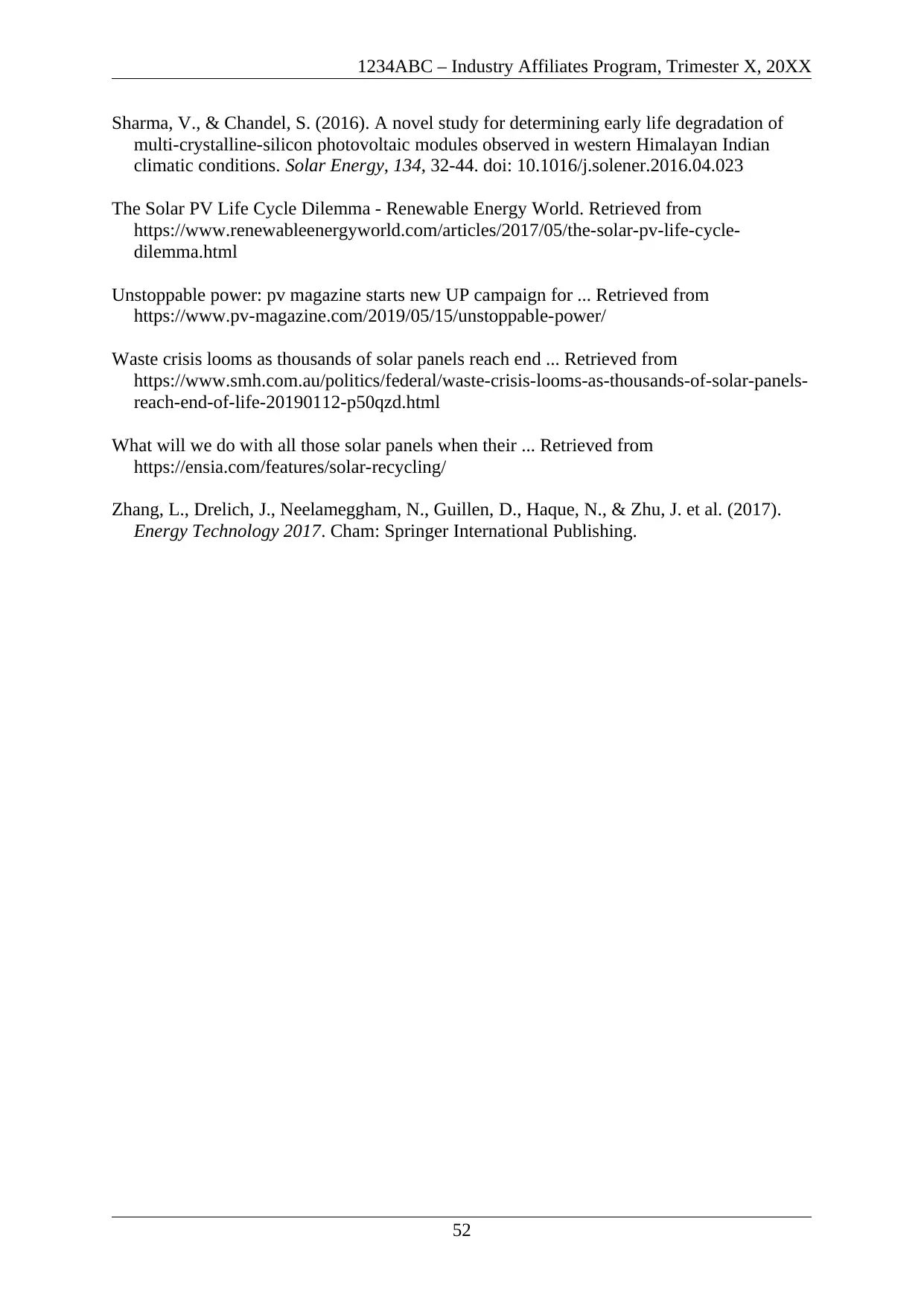
1234ABC – Industry Affiliates Program, Trimester X, 20XX
Sharma, V., & Chandel, S. (2016). A novel study for determining early life degradation of
multi-crystalline-silicon photovoltaic modules observed in western Himalayan Indian
climatic conditions. Solar Energy, 134, 32-44. doi: 10.1016/j.solener.2016.04.023
The Solar PV Life Cycle Dilemma - Renewable Energy World. Retrieved from
https://www.renewableenergyworld.com/articles/2017/05/the-solar-pv-life-cycle-
dilemma.html
Unstoppable power: pv magazine starts new UP campaign for ... Retrieved from
https://www.pv-magazine.com/2019/05/15/unstoppable-power/
Waste crisis looms as thousands of solar panels reach end ... Retrieved from
https://www.smh.com.au/politics/federal/waste-crisis-looms-as-thousands-of-solar-panels-
reach-end-of-life-20190112-p50qzd.html
What will we do with all those solar panels when their ... Retrieved from
https://ensia.com/features/solar-recycling/
Zhang, L., Drelich, J., Neelameggham, N., Guillen, D., Haque, N., & Zhu, J. et al. (2017).
Energy Technology 2017. Cham: Springer International Publishing.
52
Sharma, V., & Chandel, S. (2016). A novel study for determining early life degradation of
multi-crystalline-silicon photovoltaic modules observed in western Himalayan Indian
climatic conditions. Solar Energy, 134, 32-44. doi: 10.1016/j.solener.2016.04.023
The Solar PV Life Cycle Dilemma - Renewable Energy World. Retrieved from
https://www.renewableenergyworld.com/articles/2017/05/the-solar-pv-life-cycle-
dilemma.html
Unstoppable power: pv magazine starts new UP campaign for ... Retrieved from
https://www.pv-magazine.com/2019/05/15/unstoppable-power/
Waste crisis looms as thousands of solar panels reach end ... Retrieved from
https://www.smh.com.au/politics/federal/waste-crisis-looms-as-thousands-of-solar-panels-
reach-end-of-life-20190112-p50qzd.html
What will we do with all those solar panels when their ... Retrieved from
https://ensia.com/features/solar-recycling/
Zhang, L., Drelich, J., Neelameggham, N., Guillen, D., Haque, N., & Zhu, J. et al. (2017).
Energy Technology 2017. Cham: Springer International Publishing.
52
1 out of 52
Your All-in-One AI-Powered Toolkit for Academic Success.
+13062052269
info@desklib.com
Available 24*7 on WhatsApp / Email
![[object Object]](/_next/static/media/star-bottom.7253800d.svg)
Unlock your academic potential
© 2024 | Zucol Services PVT LTD | All rights reserved.